- Analytics
- News and Tools
- Market News
CFD Markets News and Forecasts — 29-03-2023
- USD/CHF has dropped to near 0.9180 amid rising expectations for more rates by the SNB.
- SNB Quarterly Bulletin cemented more rate hikes to ensure price stability in the Swiss region.
- The expectation of weak growth in US Retail Sales in 2023 is barricading the upside of the USD Index.
The USD/CHF pair has shown a corrective move to near 0.9180 in the early Tokyo session. The Swiss Franc asset has witnessed selling pressure led by a gradual decline in the US Dollar Index (DXY) and rising expectations for more rates by the Swiss National Bank (SNB).
In recent sessions, the collapse of Credit Suisse kept the Swiss Franc on the back foot as the currency lost its charm of safe-haven. It seems that hawkish SNB bets are aiming to retrieve its glory.
The release of the SNB Quarterly Bulletin on Wednesday confirmed that SNB Chairman Thomas J. Jordan will hike rates further to ensure price stability in the Swiss region. The SNB Quarterly Bulletin also showed that inflation escalated to 3.4% in February and the majority of the contribution to rising Swiss inflation is coming from domestic goods.
Going forward, Friday’s Real Retail Sales (Feb) data will be keenly watched. The annual retail sales data is expected to expand by 1.9% against a contraction of 2.2%, which would cement further scalability in the inflationary pressures.
Meanwhile, the USD Index has turned sideways below 102.70. The asset had a roller-coaster ride on Wednesday amid deepening expectations of a decline in the retail demand in the United States ahead. The National Retail Federation (NRF) said on Wednesday that fears of a recession and tremors in the banking industry cast a shadow over a recovery in consumer spending, as reported by Reuters. The NRF is expecting a growth in retail demand in the 4-6% range, lower than expansion by 7% recorded in 2022.
- NZD/USD´s 4-hour chart shows that the price needs to break below 0.6215.
- Below 0.6215, bears will seek a continuation below 0.6150.
NZD/USD is flat on the day so far after what was a relatively quiet session on Wednesday. The pair has stuck to familiar ranges around 0.6220 amid growing expectations that the Reserve Bank of New Zealand will lift the official cash rate by 25bps to 5.0% at its meeting next week and a move to hike rates again to 5.25% in May.
However, until then, there is room for the US Dollar to claw back some ground and the following illustrates a downside bias for NZD/USD:
NZD/USD daily charts
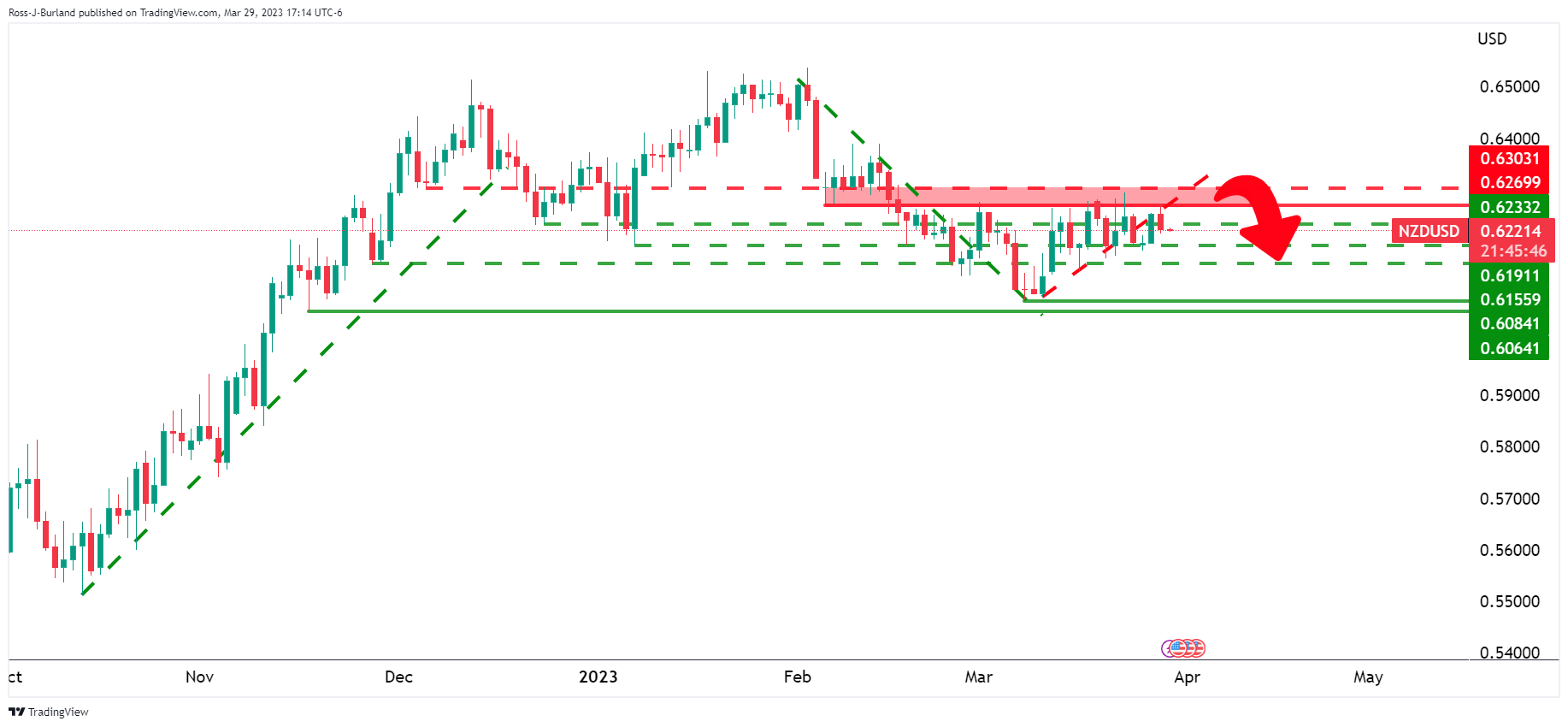
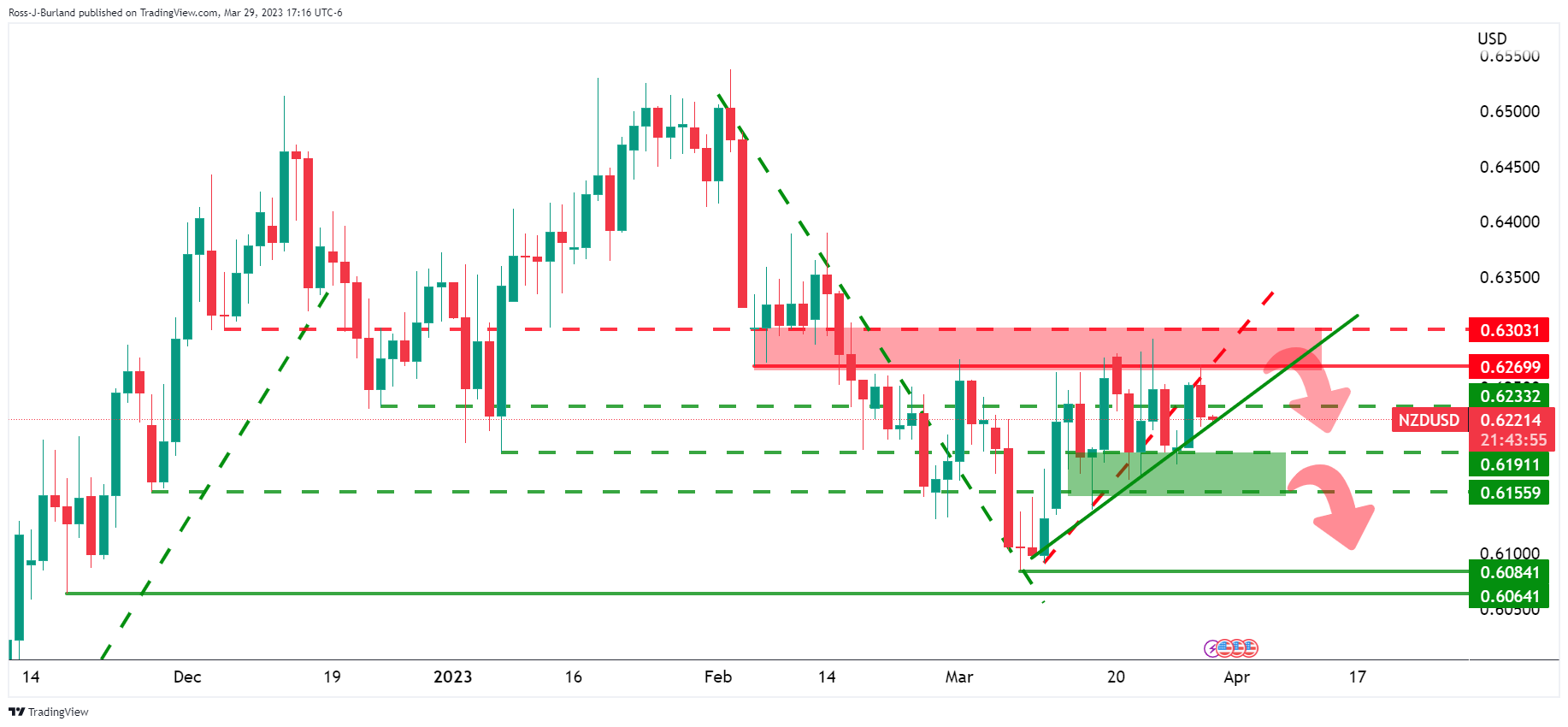
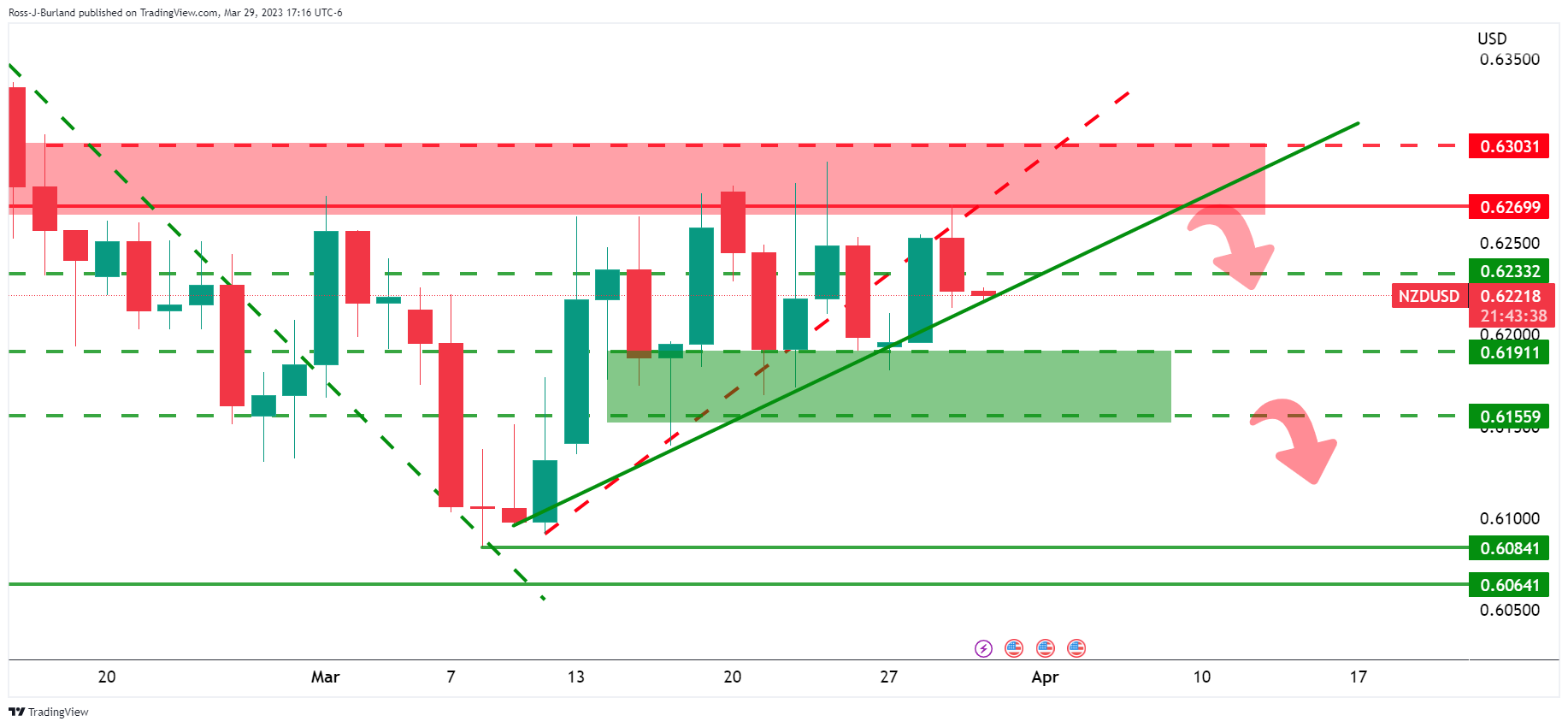
The price is on the back side of the prior bullish trend but a break of another micro trendline support will open the risk of a break below 0.6190 and then 0.6150.
NZD/USD H4 chart
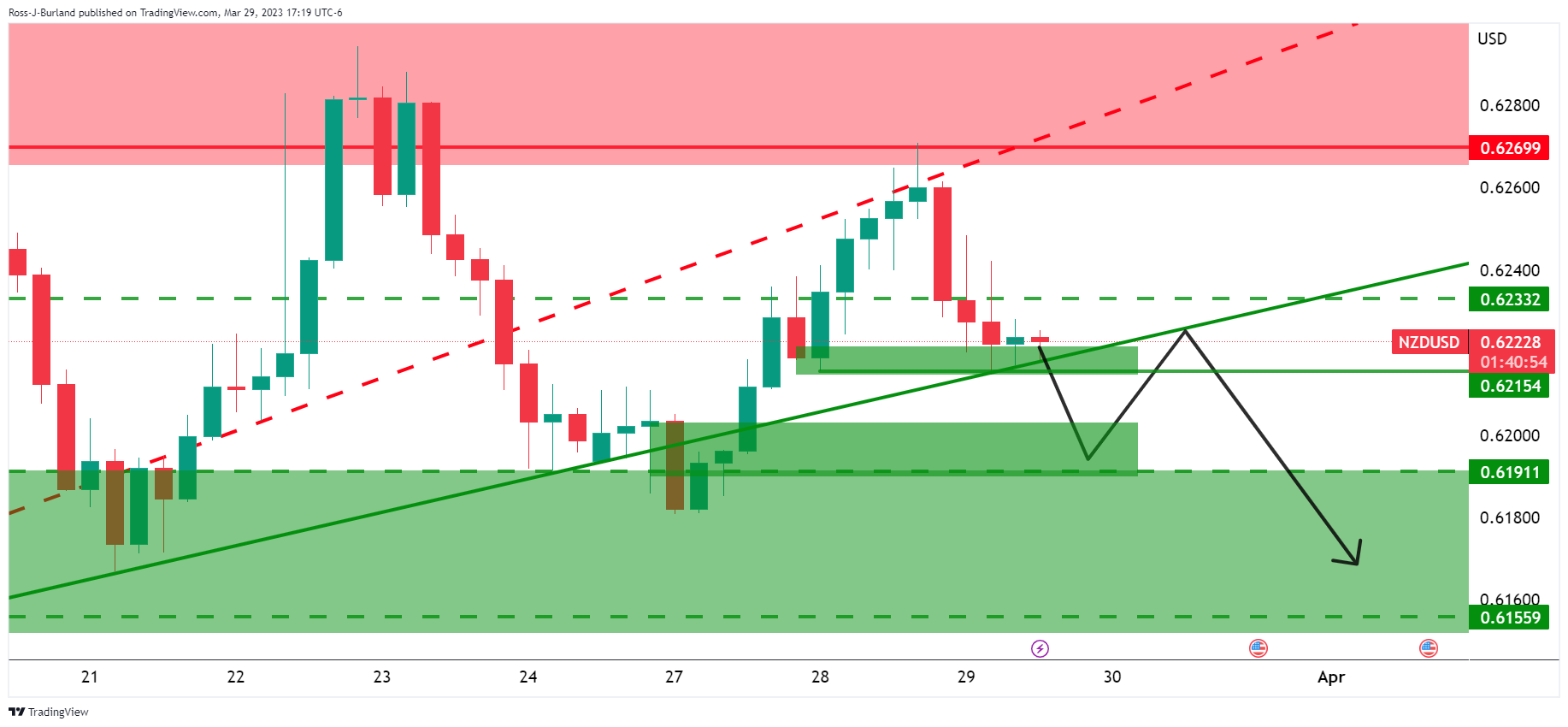
NZD/USD´s 4-hour chart shows that the price needs to first break below 0.6215.
- WTI crude oil remains sidelined inside a short-term bullish channel after reversing from the highest levels in a fortnight.
- Five-week-old horizontal hurdle guards immediate upside, convergence of 200-SMA, channel’s top line is the key hurdle.
- 100-SMA lures intraday sellers of Oil but further downside needs validation from $69.45.
WTI crude oil seesaws around $73.00 during Thursday’s sluggish Asian session, following its pullback from a 12-day high. In doing so, the black gold remains with the fortnight-old ascending trend channel while retreating from the channel’s top line and a five-week-long horizontal hurdle of late.
It should be noted that the energy benchmark’s latest pullback takes clues from the impending bear cross on the MACD and a retreat in the RSI (14) line after it touched the overbought territory.
With this, the commodity price is likely to decline further towards the immediate support of 100-SMA, around $71.70 by the press time.
In a case where the quote remains bearish past $71.70, the $70.00 and bottom line of the stated channel, close to $69.45, become crucial to watch as they hold the gate for the Oil bear’s entry.
Meanwhile, the aforementioned five-week-old horizontal resistance near $73.90-74.00 restricts the immediate upside of the WTI crude oil.
Following that, a convergence of the stated channel’s top line and the 200-SMA together highlights $74.60 as a tough nut to crack for Oil buyers.
Should the commodity price rally beyond $74.60, the odds of witnessing a run-up toward $77.50 and then to the $78.00 hurdles can’t be ruled out. Though, multiple hurdles marked since February 13 highlight the $80.80-81.00 as crucial resistance to watch afterward.
WTI: Four-hour chart

Trend: Pullback expected
- The EUR/JPY struggled at 144.00 and dived toward the 143.70s area.
- An EUR/JPY fall below 143.50, and the 20/50-day EMAs, could be tested before Friday’s session.
- EUR/JPY buyers reclaiming 144.00, and a new YTD high could be possible, above 145.56.
The EUR/JPY reached a weekly high at 144.09, but as the Asian session began, it retreated under 144.00. Although the EUR/JPY double bottom is still in play, it is at the brisk of being invalidated once the pair drops below the March 22 daily high at 143.62. At the time of writing, the EUR/JPY is trading at 143.75, registering minuscule losses of 0.01%.
EUR/JPY Price Action
From the daily chart perspective, the EUR/JPY rallied sharply on Wednesday, piercing the 20 and the 50-day Exponential Moving Averages (EMAs), each at 142.65 and 142.58, respectively. However, failure to hold to its gains above 144.00 could exacerbate a pullback toward the 142.00 area.
Oscillators like the Relative Strength Index (RSI) and the Rate of Change (RoC), portray the pair might be headed for a bullish continuation. But the RSI’s slope shifted flat, suggesting buyers are getting a respite.
If the EUR/JPY buyers reclaim 144.00, that could open the door to test the March 15 high at 144.96, ahead of piercing 145.00. A breach of the latter, and the EUR/JPY could be trading at new YTD highs, nearby the December 15 high at 146.72. But firstly, the EUR/JPY needs to face solid resistance at 145.50 and 146.00.
On the other hand, if the EUR/JPY extended its losses below 143, the 20-day EMA, at 142.64, could be tested. Break below, and the 50-day EMA is next at 142.58.
EUR/JPY Daily Chart
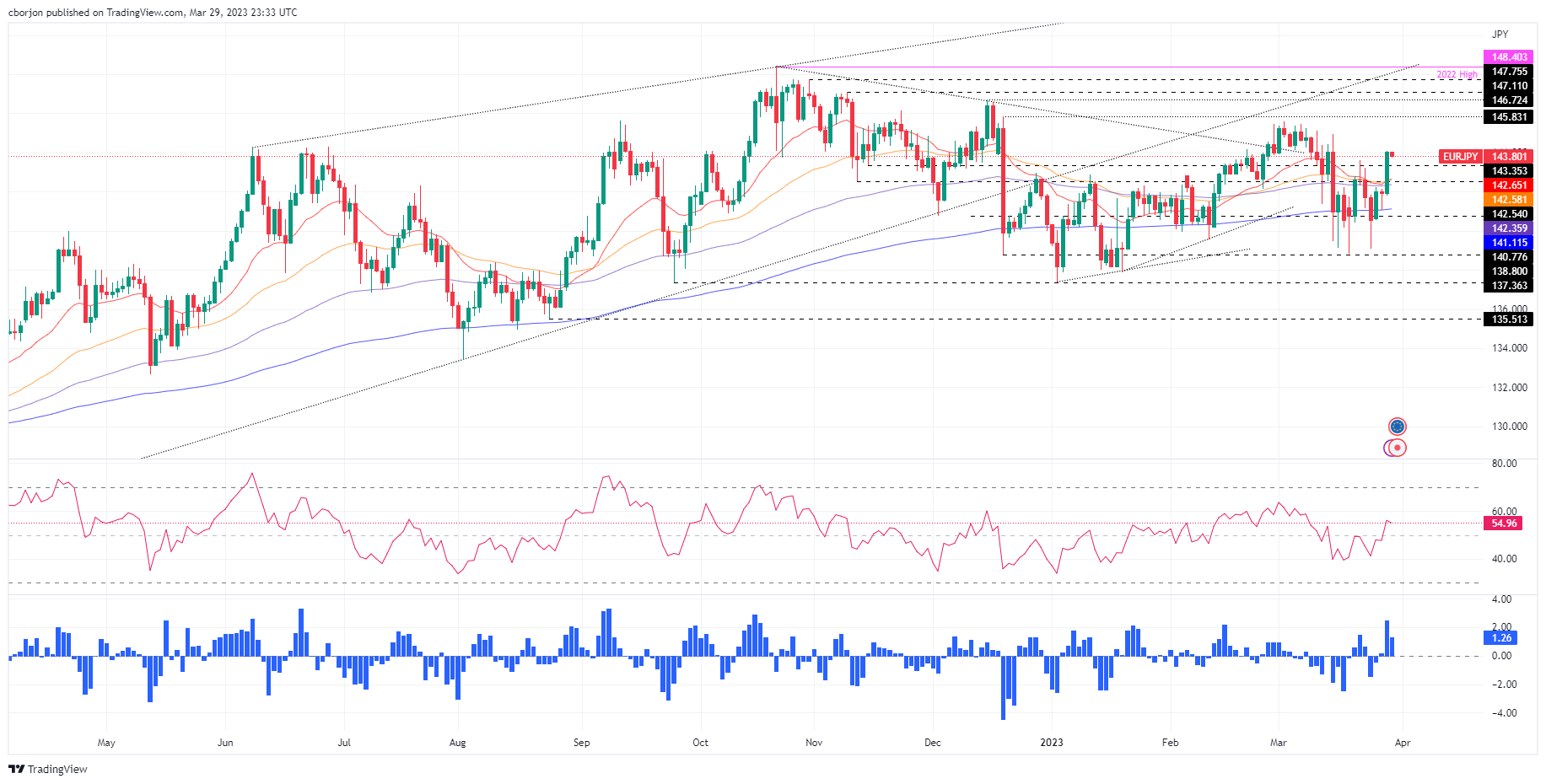
EUR/JPY Technical Levels
- USD/JPY is aiming to recapture 133.00 as ebbing fears of US banking shakedown have trimmed the Japanese Yen’s appeal.
- The street believes that the US banking sector has already reported its collateral damage.
- Tokyo CPI is expected to soften consecutively led by declining oil prices.
The USD/JPY pair is facing barricades in reclaiming the immediate resistance of 133.00 in the Asian session. The major is expected to resume its upside journey as global banking fears have eased, the US Dollar Index (DXY) has shown a decent recovery, and fears of softening of Japan’s inflation have renewed.
Easing US banking jitters after the announcement of the acquisition of collapsed Silicon Valley Bank’s (SVB) deposits and loans to efforts made by US authorities to infuse confidence among investors have trimmed appeal for the Japanese Yen as a safe-haven.
Investors were gung ho for the Japanese Yen when the US administration alarmed shakedown in the banking sector. However, the market participants believe that the US banking sector has already reported its collateral damage, which has forced them to withdraw funds from the Japanese Yen. This also helped the USD Index in building a cushion around 102.40. A recovery move by the USD Index has already pushed it to above 102.60.
The US Dollar is expected to remain in action ahead of the release of the Federal Reserve’s (Fed) preferred inflation tool, core Personal Consumption Expenditure (PCE) Price Index (Feb) data. According to the estimates, monthly core PCE inflation would accelerate by 0.4%, lower than the former expansion of 0.6%. The annual figure is expected to remain steady at 4.7%.
On the Tokyo front, investors are focusing on Tokyo Consumer Price Index (CPI) data, which will release on Friday. The street is anticipating further softening of the headline Tokyo CPI to 2.7% from the former release of 3.4% led by declining oil prices in the international market. However, the core CPI that strips off oil and food prices is seen expanding to 3.3% from the former release of 3.2%. More stimulus measures are expected from the Bank of Japan (BoJ) in keeping inflation steadily above desired levels.
- US Dollar Index fades bounce off one-week low, sidelined of late.
- Fed Chair Powell signal one more rate hike in 2023, Vice Chair Barr highlights data dependency.
- US inflation expectations remain firmer ahead of Fed’s favorite inflation gauge.
- Dicey markets, quarter-end positioning also restrict DXY moves ahead of Thursday’s second-tier data.
US Dollar Index (DXY) struggles to keep the previous day’s bounce off weekly low around 102.65 amid mixed signals from the Federal Reserve (Fed) officials despite inflation woes, as well as due to the recently receding banking fears.
Corrective bounce in the US Treasury bond yields joined the quarter-end positioning and cautious optimism in the market to underpin the US Dollar’s latest rebound. Adding strength to the greenback’s rebound could be the geopolitical fears emanating from China, Russia and North Korea. However, an absence of hawkish comments from the Federal Reserve (Fed) officials joins the absence of talks about banking woes to weigh on the US Dollar.
The US blacklisting of Chinese companies and Beijing’s dislike of a meeting between the White House Speak and the Taiwan President can be considered the key catalysts to challenge the previously firmer sentiment and allowed the US Dollar to snap a two-day downtrend. Though, optimism on the technology and banking front challenged the risk-off mood, as well as the DXY’s rebound.
It’s worth noting that the US inflation expectations, per the 10-year and 5-year breakeven inflation rates from the St. Louis Federal Reserve (FRED), jumped to a two-week high the previous day and allowed the US Dollar to remain firmer.
However, Bloomberg came out with the news suggesting Fed Chair Jerome Powell showed forecasts for one more rate hike in 2023, which in turn pushed back talks of policy pivot and favor the US Dollar bulls. Though, Vice Chair for Supervision Michael Barr said, “We will be looking at incoming data, financial conditions to make a meeting-by-meeting judgment on rates.
Against this backdrop, Wall Street closed with notable gains led by tech and bank stocks while the US Treasury bond yields eased.
Looking ahead, the final readings of the US fourth quarter (Q4) Gross Domestic Product (GDP) will join the Q4 Core Personal Consumption Expenditure (PCE) details and the weekly jobless claims to direct intraday moves. However, Friday’s US Core PCE Price Index, the Fed’s favorite inflation gauge becomes crucial for the market to watch for clear directions.
Technical analysis
US Dollar Index bulls need to provide a daily closing beyond a three-week-old descending resistance line, around 102.90 by the press time, to retake control.
- GBP/USD seesaws in a tight range after reversing from a two-month high.
- One-month-old ascending resistance line challenges bulls despite firmer oscillators.
- Bears need validation from two-week-long support line before taking control.
GBP/USD stays defensive above 1.2300 amid early Thursday’s Asian session, making rounds to a 15-pip trading range in the last, as bears struggle to keep the reins after the Cable pair reversed from a two-month high the previous day.
That said, the Cable pair took a U-turn from a multi-day top the previous day after an upward-sloping resistance line from late February challenged the bulls. However, the bullish MACD signals and an absence of the overbought RSI (14) seem to have tamed the bearish bias.
Adding strength to the upside bias is the pair’s ability to trade beyond the two-week-old upward-sloping support line and the key moving averages.
With this, the GBP/USD buyers are likely to again challenge the aforementioned resistance line, around 1.2370 by the press time.
In that case, a horizontal area comprising multiple tops marked since mid-December 2022, around 1.2445-50, gains major attention.
However, likely overbought conditions of the RSI around then could challenge the Cable bulls afterward, if not then the GBP/USD price won’t hesitate to challenge the May 2022 high of around 1.2670.
On the flip side, a two-week-long ascending support line, close to 1.2290 by the press time, restricts the immediate downside of the pair, a break of which highlights the 10-DMA support of 1.2270.
It should be noted, however, that a clear downside break of the 10-DMA can direct GBP/USD towards the 50-DMA, close to 1.2150 by the press time.
GBP/USD: Daily chart

Trend: Further upside expected
- The AUD/JPY daily chart portrays the pair might consolidate as it faces solid resistance.
- In the short term, the AUD/JPY must reclaim 89.00 to pursue higher prices.
- Otherwise, the AUD/JPY could fall toward the 87.00 area.
The AUD/JPY retreats as the Asian session begins, some 0.06%, following Wednesday’s gains of 1.09%. at the time of writing, the AUD/JPY is trading at 88.68, below the week’s high at 88.82, and also 20 pips under the 20-day Exponential Moving Average (EMA).
AUD/JPY Price Action
From a daily chart perspective, the AUD/JPY failed to hurdle solid resistance at the 20-day EMA and at March’s 22 high of 89.00. Oscillators turned flat at bearish territory, suggesting that sellers are lurking around current exchange rates. Additionally, the Rate of Change (RoC), albeit bullish, is at the mercy of Thursday’s price action. Therefore, sudden shifts in market sentiment and the AUD/JPY could reverse its course.
Short term, the AUD/JPY is hovering around the 100-EMA at 88.68, slightly above the central pivot point. After the AUD/JPY crossed above the 20-EMA, the pair registered gains of 1.41%. However, the Relative Strength Index (RSI) is shifting downward, albeit at bullish territory, while the Rate of Change (RoC) portrays that buying pressure is waning. The AUD/JPY could print a leg-down before testing 89.00 and beyond.
Hence, the AUD/JPY first support would be the pivot point at 88.42, followed by the confluence of the 50/20-EMAs, and the S1 pivot point at around 87.95/88.02. Once cleared, the pair could dive to the S1 daily pivot at 87.28
On the upside, the AUD/JPY could test the 200-EMA once it clears 89.00 and the R1 daily pivot at 89.16. The next resistance would be the 200-EMA at 89.58.
AUD/JPY 4-Hour Chart
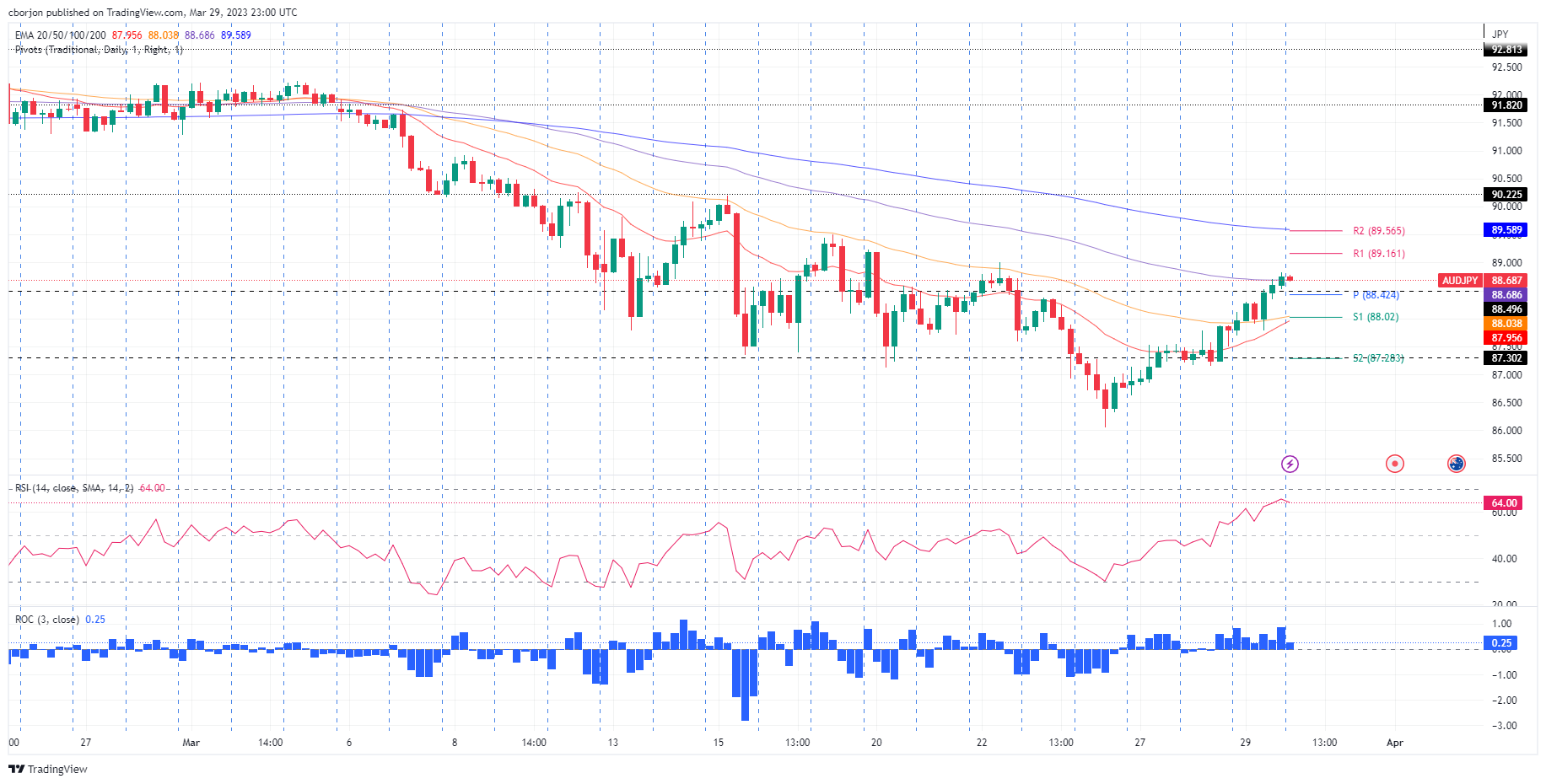
AUD/JPY Technical levels
- USD/CAD is likely to refresh its monthly low below 1.3555 amid the risk-on mood.
- S&P500 futures were heavily bought as fading US banking fears infused confidence among investors.
- Oil price has extended its correction below $73.00 despite the US EIA reporting a huge drawdown in oil stockpiles by 7.489 million barrels.
The USD/CAD pair is hovering near a monthly low around 1.3555 in the early Asian session. The Loonie asset is expected to refresh the same despite some sort of recovery from the US Dollar Index (DXY). The major has shown a three-day losing spell and is expected to continue the same if it surrendered the 1.3555 support. The USD Index is juggling in a narrow range after a mild correction as the upside looks capped around 102.80.
S&P500 futures were heavily bought by the market participants on Wednesday as fading United States banking fears infused confidence among investors. Also, US authorities are making efforts in assuring households of continuing deposits to mid-size banks after the collapse of a couple of banks.
The risk appetite theme underpinned by the market participants has improved the appeal of the Canadian Dollar. Going forward, investors will keep focusing on the Canadian Gross Domestic Product (GDP) data, which will release on Friday. As per the consensus, the Canadian economy has grown by 0.3% in January on a monthly basis against a contraction of 0.1% reported earlier.
But before that, US GDP data will release on Thursday. The economic data is expected to remain steady at 2.7%. The Federal Reserve (Fed) will keep its focus on the GDP data as any contraction in growth rate could propel keeping rates steady ahead. As per the CME Fedwatch tool, more than 60% of investors are favoring an unchanged monetary policy by the Fed.
On the oil front, the oil price has extended its correction below $73.00 despite the US Energy Information Administration (EIA) reporting a huge drawdown in oil stockpiles by 7.489 million barrels for the week ending March 24.
“Federal Reserve Chair Jerome Powell, asked in a private meeting with US lawmakers how much further the central bank will raise interest rates this year, pointed to policymakers’ latest forecasts showing they anticipate one more increase, according to Republican Representative Kevin Hern per Bloomberg.
On the other hand, Reuters claim that US Senator Hern said that Fed’s Powell told Republican lawmakers that Congress should re-evaluate limits on the size of federally insured bank deposits.
"We talked about that but he said it was the role for Congress to really evaluate. Thought it was a great topic to bring up," Hern said after Powell spoke to a closed-door meeting of the Republican Study Committee per Reuters.
The news also adds that the Federal Deposit Insurance Corporation (FDIC) currently insures up to $250,000 per depositor, but the Silicon Valley Bank (SVB) and Signature Bank collapses this month have raised questions over whether insurance limits needed to be raised.
Also read: EUR/USD stays firm around 1.0840, with traders eyeing German and US inflation data
“Some recommendations from an independent review of the Reserve Bank of Australia’s (RBA) monetary policy decision-making and board make-up may require legislative changes to enact,” said Australian Treasurer Jim Chalmers on Thursday while speaking on ABC Radio per Reuters.
Reuters also added that the review was called after the RBA undershot its inflation target of 2% to 3% for much of the last decade and issued guidance during the COVID-19 pandemic that rates were not expected to rise until at least 2024,” while also mentioning, “But the RBA has made 10 straight rate hikes since May to tame surging inflation.”
Aussie Treasurer Chalmers looks set to receive on Friday the findings of the report on the RBA.
Additional quotes
The government would look to reach consensus with the opposition parties to amend any laws ‘if we go down that path’.
If there are some that require a change to the (RBA Act) that we're keen on progressing, then ideally we would do that in a bipartisan way.
I would release the report with the government's initial views next month, ahead of the federal budget in May.
So I'd like to put it out in April, and people can go through it and see what they think about it.
A decision whether to re-appoint Governor Philip Lowe, whose term ends in September, would be taken ‘closer to the middle of the year’ in consultation with Prime Minister Anthony Albanese and the cabinet.
AUD/USD stays pressured
AUD/USD remains depressed around 0.6680 by the press time, following the first daily loss in three.
Also read: AUD/USD struggles below 0.6700 as market sentiment dwindles on inflation, banking concerns
- The Euro is registering gains of 0.78% in the week after hitting a low of 1.0744.
- A risk-on impulse, US Dollar weakness, and expectations for higher rates in the Eurozone boosted the EUR.
- EUR/USD Price Analysis: Set to test 1.1000 above 1.0900; otherwise, it could fall to 1.0700.
The Euro (EUR) advanced for three straight sessions against the US Dollar (USD), but late in the North American session, the EUR/USD retreated, forming a doji. Hence, indecision is the game's name, as the greenback staged a recovery on Wednesday. The EUR/USD is trading at 1.0841, down 0.02%, as the Asian session begins.
German and US inflation figures, eyed by EUR/USD traders
The shared currency has been bolstered by a soft US Dollar, which snapped two days of straight losses, as shown by a basket of six currencies vs. the buck. The US Dollar Index rose 0.22%, at 102.654 on Wednesday.
The US economic docket featured Pending Home Sales, which increased by 0.8% MoM in February, exceeding expectations for a 0.3% drop. Annually, it fell by 21.1%, less than the 29.4% drop predicted. On the Eurozone (EU) side, the German Gfk Consumer sentiment in April improved to -29.5 from a revised -30.6 in March. Although it improved, it was beneath the estimates of -29.0.
In the meantime, European Central Bank (ECB) policymakers have stressed the need for higher interest rates after the bank turmoil dissipated. Philip Lane, the ECB Chief Economist, said, “Under our baseline scenario, to make sure inflation comes down to 2%, more hikes will be needed.”
Therefore, the EUR/USD pair has been upward pressured as market participants estimate that the US Federal Reserve (Fed) would leave rates unchanged at 4.75%-5.00%. After that, a few rate cuts have been priced in by the year’s end.
The EUR/USD would be influenced by inflation data in the US and the EU on Thursday and Friday. The Fed’s preferred gauge for inflation, the core PCE, will be revealed on Friday. Any upward revisions could put into play further rate increases by the US central bank. On the EU’s front, rising inflation in Germany would cement the case for another interest rate increase by the ECB.
What to watch?
On Thursday, the EU’s calendar will feature German inflation figures. In the US, the Gross Domestic Product (GDP) for Q4, alongside Initial Jobless Claims for the last week, will be released.
EUR/USD Technical analysis
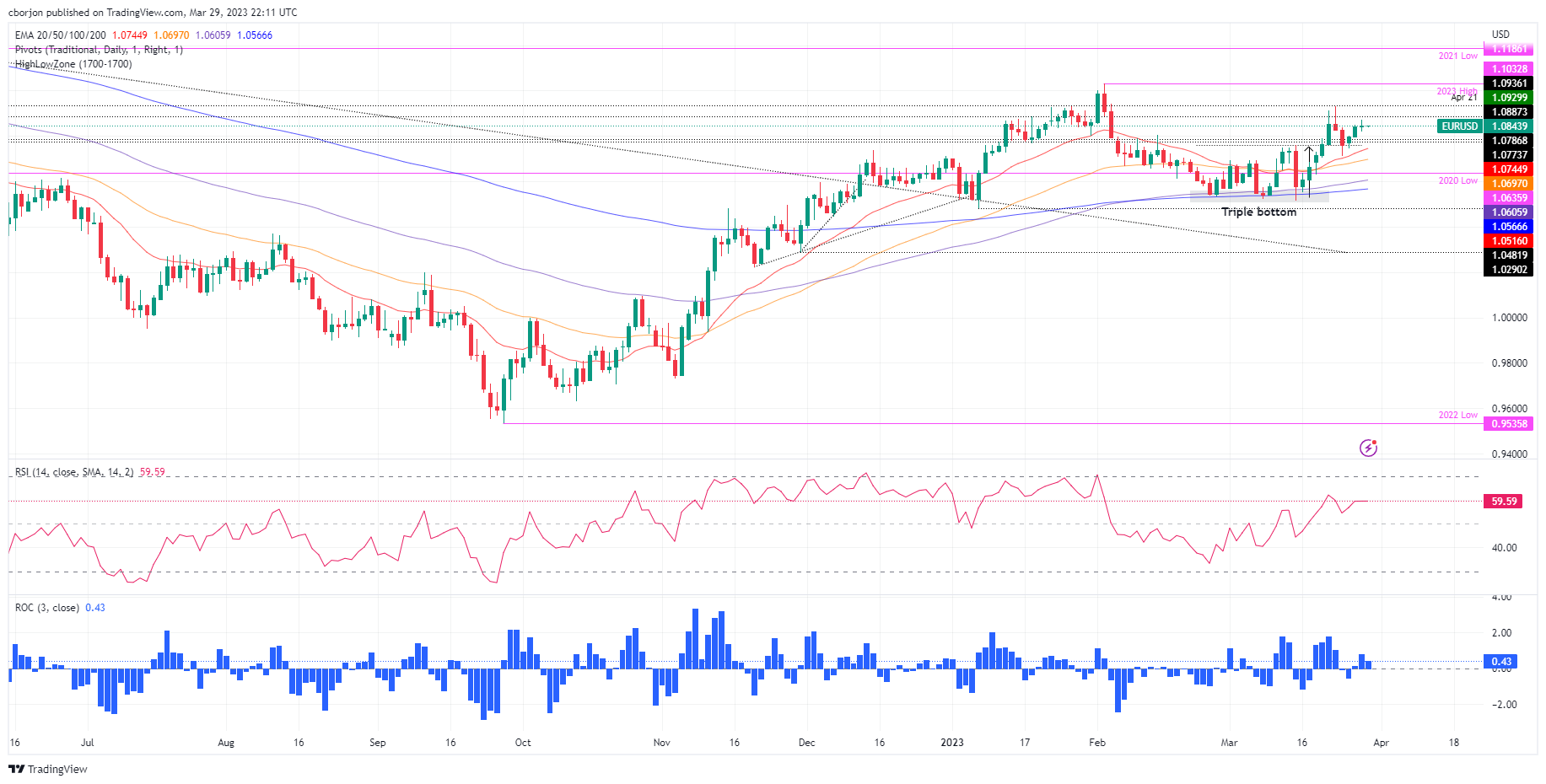
Given the backdrop, the EUR/USD triple bottom remains in play. A fall below the March 15 daily high at 1.0759 would invalidate the chart pattern and exacerbate a fall. That would expose the 20-day Exponential Moving Average (EMA) at 1.0744, followed by the 50-day EMA, shy of 1.0700, at 1.0696. On the flip side, a break above 1.0900 and the EUR/USD pair will test the week’s high at 1.0929 before challenging 1.1000.
- Gold price is oscillating above $1,960.00 ahead of US PCE Price Index for fresh impetus.
- S&P500 recorded a stellar rally on Wednesday as fears of a global banking crisis receded, portraying a risk-on mood.
- Fed Barr assured investors that the failure of a couple of lenders is unable to lead to a widespread contagion.
Gold price (XAU/USD) is displaying topsy-turvy moves in a $12 range above 1,960.00 in the early Asian session. The precious metal is defending the $1,960.00 support despite easing global banking jitters, which has trimmed the appeal for Gold as a safe-haven asset.
The asset is unable to find a decisive move as investors are awaiting the release of the United States the core Personal Consumption Expenditure (PCE) Price Index (Feb) data will be of significant importance. As per the consensus, monthly core PCE would accelerate by 0.4%, lower than the former expansion of 0.6%. The annual figure is expected to remain steady at 4.7%.
S&P500 recorded a stellar rally on Wednesday as fears of a global banking crisis receded, portraying a firmer risk appetite of the market participants. The commentary from Federal Reserve (Fed) Vice Chair for Supervision Michael Barr told Senate Banking Committee that the United States banking system is ‘sound and resilient’. He assured investors that the failure of a couple of lenders is unable to lead to a widespread contagion.
The US Dollar Index (DXY) has shown some gradual correction to near 102.70 after a solid recovery on hopes that ebbing global banking jitters would allow the Fed to continue its policy-tightening spell. The demand for US government bonds remained choppy as fears of a banking crisis are ebbing, which left 10-year US Treasury yields steady at around 3.56%.
Gold technical analysis
Gold price is auctioning in a Symmetrical Triangle chart pattern on a two-hour scale. The upward-sloping trendline of the chart pattern is plotted from March 22 low at $1,934.34 while the downward-sloping trendline is placed from March 20 high at $2,009.88. Any side break of the Symmetrical Triangle, a volatility contraction pattern, will result in wider ticks and heavy volume.
The 20-period Exponential Moving Average (EMA) at $1,965.00 overlaps with the asset price, indicating a rangebound performance ahead.
Meanwhile, the Relative Strength Index (RSI) (14) is oscillating in the 40.00-60.00 range, which indicates that investors are awaiting a fresh trigger for further action.
Gold hourly chart
“Underlying inflation in the eurozone is proving sticky and the recent fall in energy costs may not pull it down as fast as some expect, European Central Bank (ECB) policymaker Isabel Schnabel said on Wednesday, highlighting the bank's chief concern,” reported Reuters late Wednesday.
Schnabel, head of the ECB's market operations, also added that last year's energy price spike seeped into the broader economy quickly but the reversal may take longer.
It’s worth noting that ECB’s Schnabel spoke at a National Association for Business Economics conference in Washington.
More comments
My suspicion is that it is not the case, that it may not drop out as quickly as it moves in.
And it's not even clear whether it's going to be completely symmetric in the sense that everything is even going to drop out at all.
ECB has some flexibility in reaching its 2% target and did not want to create needless pain by acting too quickly.
Our target is defined over the medium term, and so of course, we do not want to cause unnecessary pain.
Market reaction
EUR/USD remains sidelined around 1.0850 by the press time, after a mostly inactive day.
Also read: EUR/USD stays firm around 1.0840, with traders eyeing German and US inflation data
- AUD/USD remains sidelined after reversing from weekly high, up on weekly basis so far.
- Downbeat Aussie inflation data, fears of further rate hikes and geopolitical woes weigh on the risk-barometer pair.
- Light calendar in Asia favors traders to extend latest pullback ahead of Friday’s key US inflation clues.
AUD/USD justifies its risk-barometer status as the quote seesaws around 0.6680 amid a mixed start to Thursday’s trading, following a downbeat closing. That said, the Aussie pair’s previous losses could be linked to the US Dollar’s rebound and downbeat Australia inflation numbers while the latest inaction is likely due to a lack of major catalyst, as well as mixed concerns about inflation and banking.
On Wednesday, Australia’s Monthly Consumer Price Index dropped to 6.8% YoY in February versus 7.2% expected and 7.4% prior. The reading followed downbeat Retail Sales and triggered a fall in the odds of witnessing another 0.25% rate hike from the Reserve Bank of Australia (RBA).
On the other hand, the US Dollar Index (DXY) marked the first daily gain in three even as the market sentiment improved and the US Treasury bond yields. The reason might be the month-end positioning, as well as the hawkish Fed comments, not to forget the recent fears emanating from China.
Amid these plays, Wall Street closed with notable gains led by tech and bank stocks while the US Treasury bond yields eased.
Given the light calendar in the Asia-Pacific region, the AUD/USD pair may rely on the risk catalysts for clear directions. Among them, the inflation and banking headlines will be the key to follow.
Technical analysis
AUD/USD pair gradually recovers towards the 50-DMA hurdle of 0.6830, backed by the latest breakout of the 21-DMA, close to 0.6665 by the press time.
- USD/CHF is being offered but the bears need to get below the support near 0.9120.
- The pair is being resisted at key structure across the time frames.
USD/CHF is running into offers again as the following technical analysis will illustrate. Meanwhile, the US Dollar rose against most major peers on Wednesday and was 0.22% higher on the day printing a high of 102.78 at one point. Nevertheless, the CHF ran into offers and stays bearish as follows:
USD/CHF M5 chart
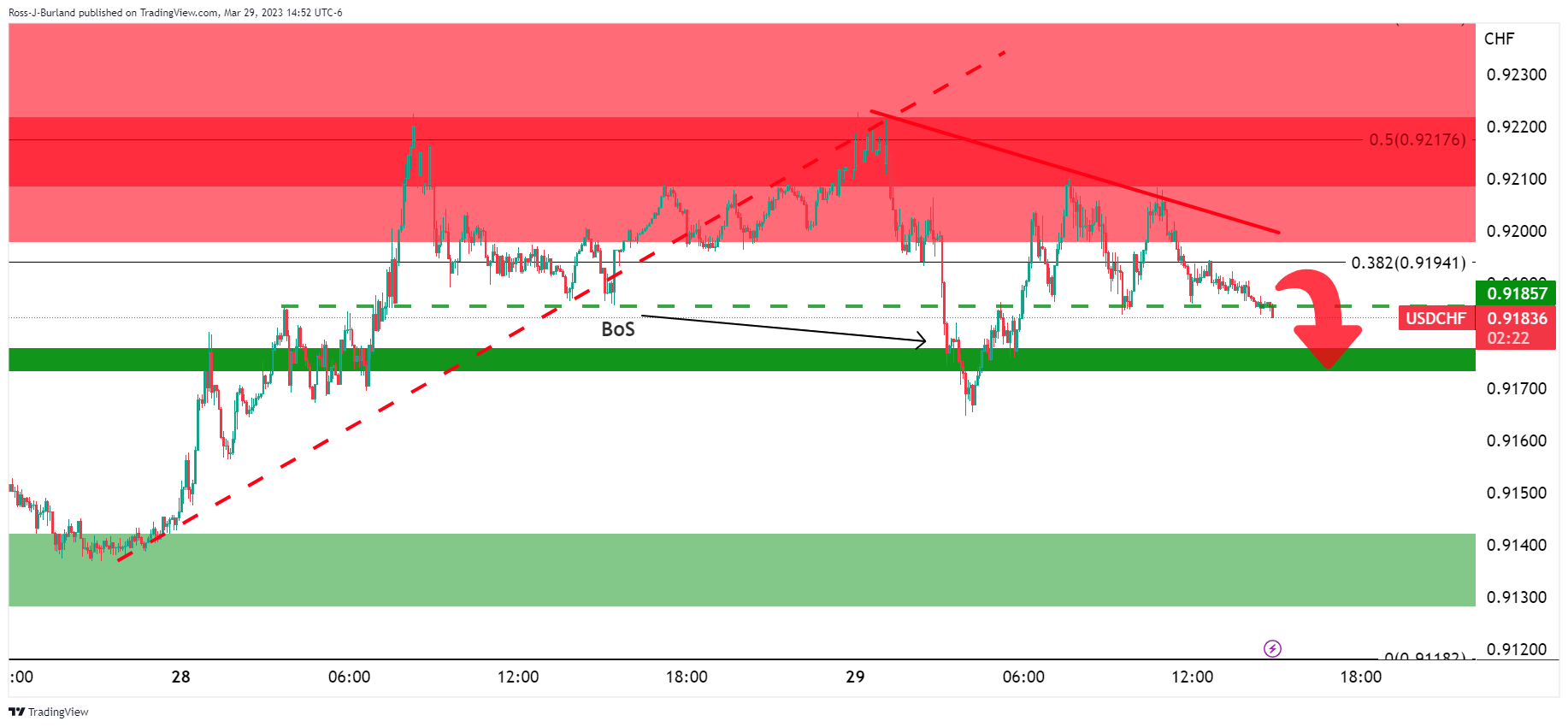
The 5-minute charts show the price moving lower into bearish territory again after the break of structure, BoS, from the prior day.
USD/CHF H1 chart
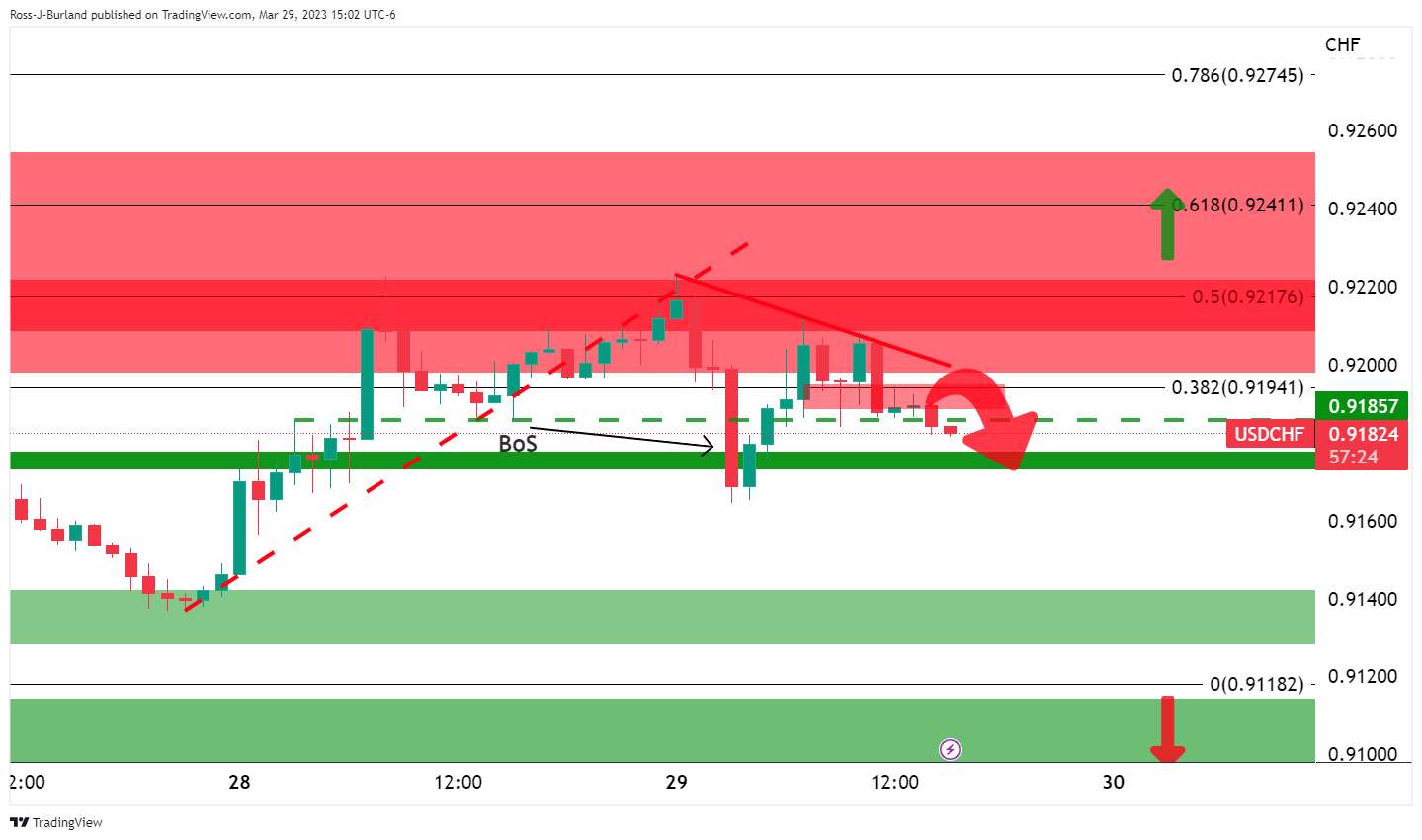
The resistance on the hourly chart shows that the price is being resisted.
USD/CHF daily chart

The M-formation is bearish with the price struggling at the neckline resistance.
USD/CHF H4 chart
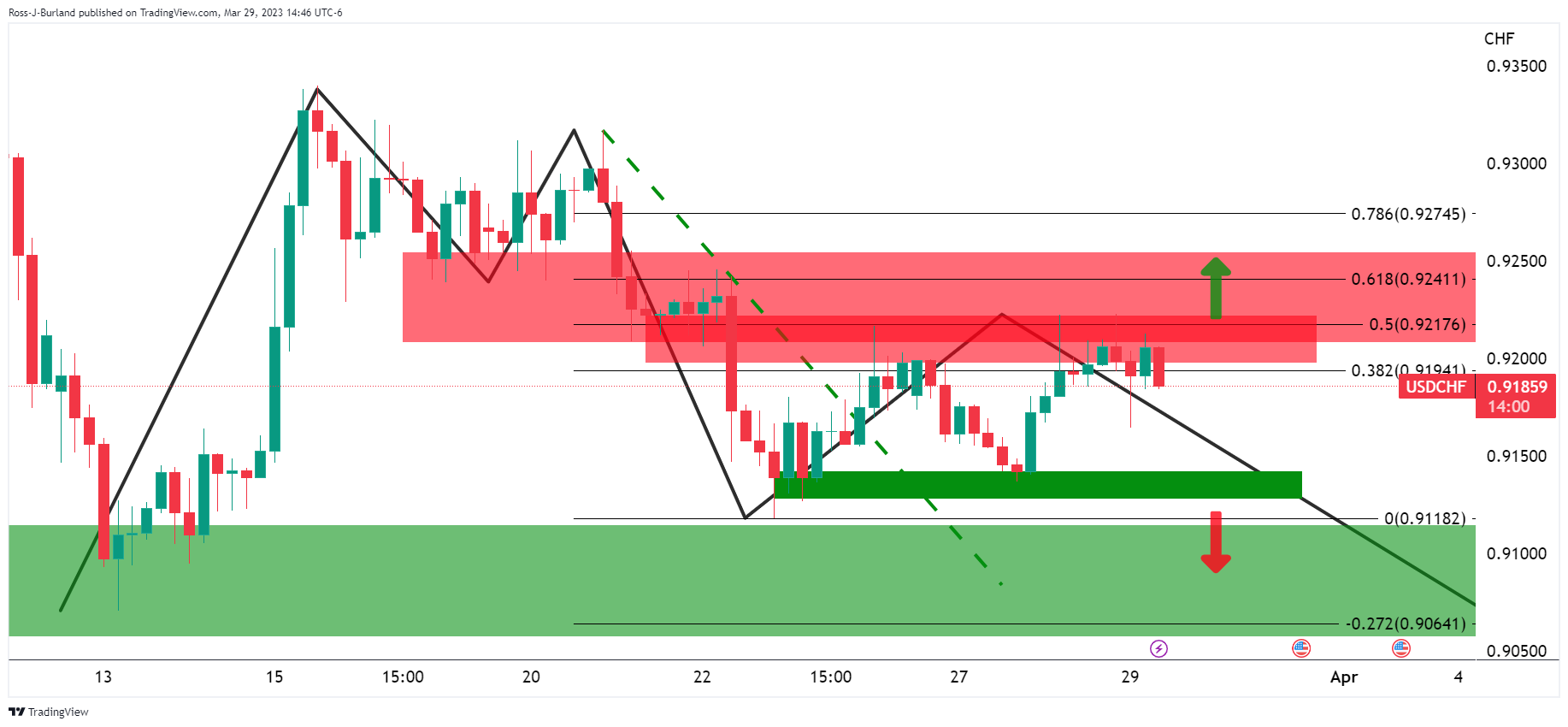
The bears need to get below the support near 0.9120.
The FX market offers no clear signs ahead of crucial inflation data from the Euro Area and the US. The US Dollar is moving between gains and losses despite risk appetite. The economic calendar for the Asian session is light and could favor more price consolidation.
Here is what you need to know on Thursday, March 30:
Wall Street indexes closed with strong gains, and the VIX posted the lowest close in three weeks. The S&P 500 reclaimed the 4,000 mark with a 1.40% gain, while the Nasdaq soared 1.79%. Tech and bank sectors rose, as banking concerns continued to ease. Investors turn their focus to incoming inflation data.
US bonds moved sideways on a quiet session, with yields hovering near recent highs. The Japanese Yen was the worst performer, affected by risk appetite, higher yields and expectations that the Bank of Japan will continue its current policy until the second half of the year. USD/JPY was last seen approaching 133.00, after a 200-pip rally.
The rally in USD/JPY boosted the US Dollar Index, which rose after two days, ending above 102.50. Regarding US data, Jobless Claims and the third Q4 GDP growth estimate on Thursday will be the preview for Friday’s critical inflation PCE report.
EUR/USD hit weekly highs and pulled back; it is consolidating around 1.0840. German inflation will be released on Thursday and Eurozone’s on Friday. European Central Bank (ECB) officials will watch those numbers closely and could have considerable market implications.
GBP/USD climbed to the highest level in two months above 1.2350 but reversed, falling toward 1.2300. The Euro and the Pound are holding on to significant monthly gains versus the US Dollar.
The optimism in the stock market did not reflect the usual correlation among commodity currencies. The Loonie continues to outperform, while AUD and NZD weaken. USD/CAD dropped sharply for the third consecutive day, posting the lowest daily close in a month at 1.3560.
Australian lower-than-expected February CPI data (6.8% YoY vs 7.1%) supported the case for the Reserve Bank of Australia (RBA) to pause at next week’s meeting. AUD/USD slid after the report, bottomed on European hours at 0.6659 and then trimmed losses.
The Kiwi was the worst among commodity currencies. NZD/USD peaked at 0.6270 and then tumbled toward 0.6200, while AUD/NZD bounced sharply from three-day lows under 1.0700 to weekly highs at 1.0747, despite softer Australian inflation.
Emerging market currencies cheered the upbeat tone in Wall Street. USD/MXN is looking at 18.00 after falling for the fifth consecutive day, reaching three-week lows. On Thursday, Banxico will announce its monetary policy decision.
Gold pulled back, finding support around the $1,960 zone, while Silver ended flat at $23.30. All major cryptocurrencies rose on Wednesday. Bitcoin gained more than $1,000, or 4%, to reclaim $28,000. XRP jumped 4.45%.
Like this article? Help us with some feedback by answering this survey:
- Eurozone countries will release preliminary March inflation figures.
- US Dollar recovers modestly despite risk appetite.
- EUR/USD flattens below 1.0850, holds above key daily moving averages.
The EUR/USD hit the highest level in four days at 1.0871 and then pulled back, ending flat around 1.0840. The pair is consolidating as market participants await critical inflation data from the Eurozone and the US. The US Dollar rose during the American session despite a rally in US stocks.
European Central Bank’s rate-setters on the wires continued to talk about the need to raise interest rates further, also considering the situation in financial markets. Forecasts point to a 25 basis points rate hike at the next meeting on May 4. The hawkish comments continue to offer support to the Euro.
Regarding economic data, Germany reported April GfK Consumer Confidence. The survey came in at -29.5, below the -29.2 of market consensus, showing an indiscernible improvement. More German data is coming with March inflation figures (preliminary) on Thursday and February Retail Sales and March Unemployment Rate on Friday.
Euro area HICP Preview: Peak inflation or base effects? No trade-off for ECB (for now)
On both sides of the Atlantic, attention is set on inflation data. On Thursday, Spain and Germany will release the estimated reading of March inflation and the rest of the countries and the Eurozone on Friday. In the US, the number of the week will be the Core Personal Consumption Expenditure Price Index on Friday. In addition, the US Labor Department will release the weekly Jobless Claims and the Bureau of Economic Analysis, the third estimate of Q4 GDP growth. Also, on Thursday, the European Commission will release its business and consumer surveys.
Inflation numbers will be the main focus for the next sessions unless some bank hits the wires. As the banking crisis eases, the outlook for the Euro improves. The EUR/USD bias is to the upside, but a return above 1.0900, for the moment, needs a weaker Dollar.
EUR/USD short-term technical outlook
-638157184843609332.png)
The EUR/USD lost its positive momentum; however the retreat from the peak of 1.0871 has been limited. The daily chart is still biased to the upside, but the Euro is struggling to extend gains. The key area on the chart is 1.0740/50: while above, upside risk dominates.
In the near term, the 4-hour chart favors the bulls as the price remains above the 20-period Simple Moving Average (SMA) that turned north. However, RSI and Momentum flattened as EUR/USD entered a consolidation phase. Ahead of relevant events, if the pair breaks and holds above 1.0865, more gains seem likely. The mentioned 20-SMA and an uptrend line around 1.0810/15 should limit a potential slide. A downward extension below the latter should expose 1.0785.
View Live Chart for the EUR/USD
- NZD/USD is under pressure as the US Dollar perks up.
- Eyes will turn to the RBNZ next week.
NZD/USD is losing ground, down some 0.5% and falling from a high of 0.6270 to 0.6214 on the day so far. All in all, it's been relatively quiet mid-week. Meanwhile, market worries about the banking system have ebbed following a U.S. regulator-backed sale of failed lender Silicon Valley Bank's assets.
Nevertheless, as analysts at ANZ Bank noted, ´´US 10yr bond yields haven’t moved much; the bounce in equities and commodities did little for the Kiwi. It’s a quiet week on the data front, and some consolidation was always due ahead of next week’s OCR decision.´´
In this regard, the analysts said that markets seem to be coming around to the view that we’re likely to get a hawkish tone, and are slowly pricing out hikes that were expected in the second half of the year. ´´But fears of a credit crunch are alive and well in markets around the globe, and broad risk appetite (a key ally of the Kiwi) is suffering a touch as a result.´´
In a prior note, the analysts said that they ´´expect the Reserve Bank of New Zealand will raise the Official Cash Rate (OCR) 25bp to 5.00% at its Monetary Policy Review (MPR) next Wednesday. If that’s not to be, we see a 50bp hike as likelier than a pause.´´
As for the greenback, DXY is up slightly and trading near 102.70 after two straight down days. However, a firm move below 102.50 would expose last week’s low near 101.915. With that being said, analysts at Brown Brothers Harriman argued that ´´markets are overestimating the Fed’s capacity to ease and so the dollar should eventually recover when expectations are repriced.´´
- The USD/CAD slid on market sentiment and high oil prices.
- An offered US Dollar would keep the USD/CAD under heavy stress, as the USD/CAD eyes 1.3500.
- USD/CAD Price Analysis: Would continue headed downwards unless buyers conquer 1.3600.
The Canadian Dollar (CAD) extended its gains against the US Dollar (USD) for three straight days, spurred by a risk-on impulse and overall US Dollar weakness. The buck is pressured on expectations for a less hawkish US Federal Reserve (Fed). The USD/CAD is trading at 1.3569 after printing a high of 1.3616.
Canadian Dollar boosted by high oil prices, risk appetite and soft USD
The USD/CAD continued its fall on higher oil prices, as Western Texas Intermediate (WTI) rose more than 6% weekly. Canada is one of the world’s major crude oil and natural gas exporters. Therefore, higher energy prices it usually underpins the Canadian Dollar.
Additionally, a softer US Dollar gave another leg-down to the USD/CAD pair, as it’s falling to a three-week low. However, the US Dollar Index (DXY), a barometer for the greenback’s value vs. a basket of six currencies, has paired some of its losses, gains 0.23%, at 102.665.
Traders should be aware that the Canadian Dollar, as a risk-perceived currency, would be subject to weakening on geopolitical tensions rise or sentiment shifts. As long as investors’ mood remains upbeat, the USD/CAD has room for another leg down, and it might test the 100-day Exponential Moving Average (EMA) at 1.3520.
Data-wise, the US economic docket featured Pending Home Sales for February, which rose by 0.8% MoM, above estimates for a plunge of 0.3%. Annually based, it decreased by 21.1%, less than the 29.4% plunge foreseen.
On the Canadian front, the docket featured the Bank of Canada (BoC) Deputy Governor Toni Gravelle. Gravelle did not speak about monetary policy; thought commented the BoC is ready to step in, if the banking system comes under pressure. He added that the BoC’s Quantitative Tightening (QT) program would run its course by the first half of 2025.
USD/CAD Technical analysis
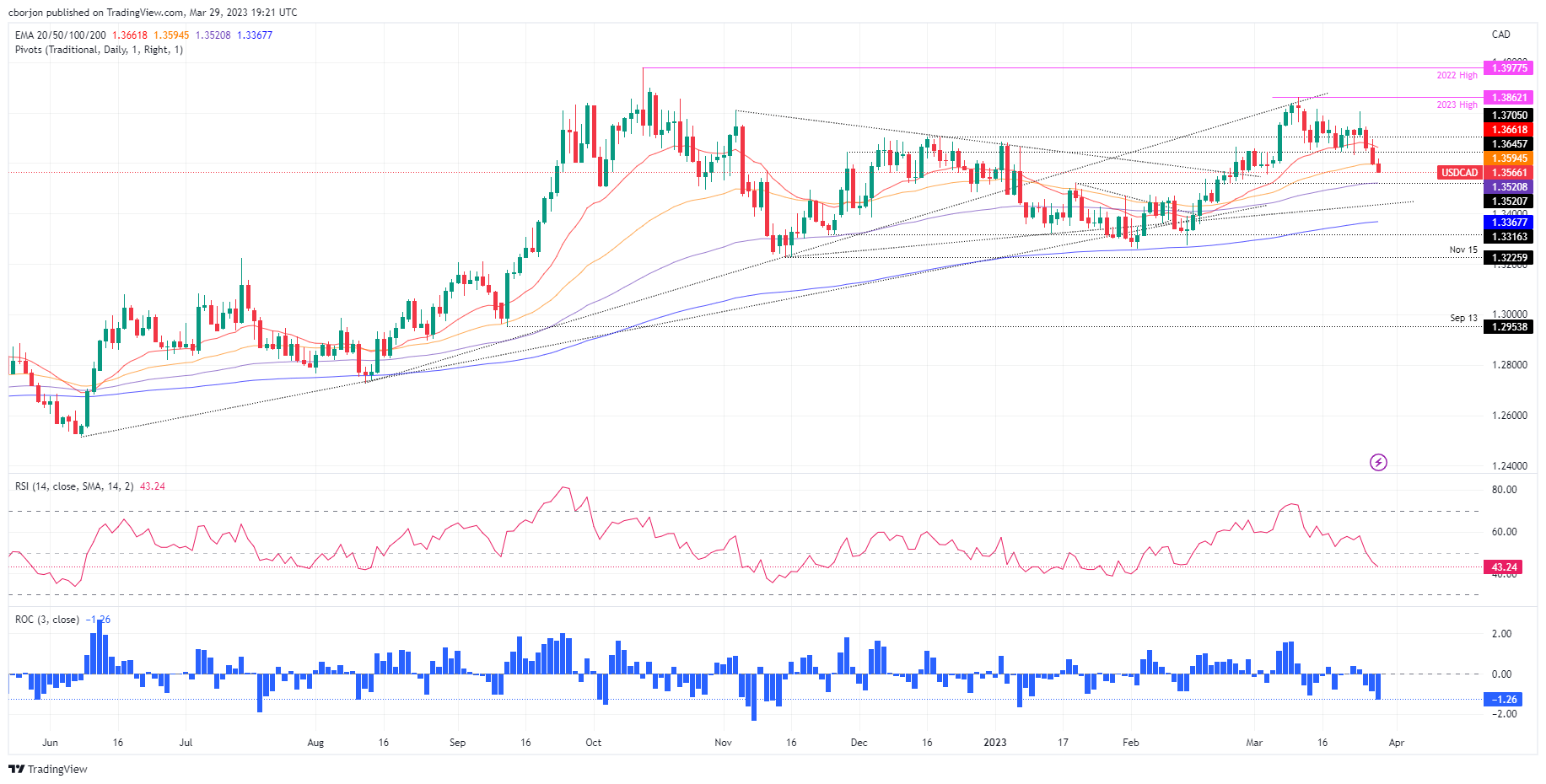
USD/CAD remains downward biased after dropping below the 50-day Exponential Moving Average (EMA) at 1.3594. a drop below 1.3550 will expose the 100-day EMA at 1.3520, ahead of testing 1.3500. Once cleared, a support trendline at around 1.3420/30 could be tested before retracing to 1.3400.
On the other hand, the USD/CAD buyers reclaiming the 50-day EMA at 1.3594 could pave the way to test 1.3600, followed by the 20-day EMA.
- GBP/JPY holds near microcycle highs around 163.40.
- The Yen is lower across the board on a risk-positive mood.
GBP/JPY shot higher to reach 163.47 on a day when the cross rallied from 161.34 on broad Yen weakness. The yen retreated after Japan’s government approved ¥2.2tn of reserve money to tame escalating price pressures.
However, as analysts at Rabobank noted, the window of opportunity for policy tightening for the BoJ now appears to be even smaller than before the banking crisis given the BoJ is unlikely to tighten policy if the US economy is facing down a recession.
´´It remains the case that growth in Japan is already fairly lacklustre. That said, while the JPY may not see much support from policy tightening this year, it is likely to act as a safe haven,´´ the analysts said.
However, they note that risk appetite has improved this week, the global economy has to become accustomed to operating in a higher interest rate environment. ´´That suggests that the stresses of the past few weeks are unlikely to be the last. We maintain a 3 mth USD/JPY131.00 forecast.´´
For the cross, GBP has derived some support from the recently better-than-expected UK economic data may have provided some recent support as well. However, talk of a policy pause clearly made the market nervous ahead of last week’s Bank of England meeting where the BoE hiked by 25bp to 4.25% with 7 members voting for a 25bp hike and two members voting for keeping the Bank Rate unchanged.
´´Overall, the forward guidance was limited with the BoE leaving the door open for another hike at the May meeting if persistent inflation pressures persist,´´ analysts at Danske Bank argued.
´´We revise our forecast to include a final 25bp hike in May, marking a peak in the Bank Rate at 4.50%,´´ the analysts said. ´´Our expectations are in line with current market pricing (currently 30bp priced until August 2023) as we expect the rest of the BoE committee to increasingly turn less hawkish amid a weakening growth backdrop and easing labour market conditions.´´
´´Markets are pricing in 30bp of cuts during H2. We still believe that the first-rate cuts will not be delivered before the beginning of 2024,´´ the analysts concluded.
- Silver price is trading sideways after hitting a daily high of $23.39.
- XAG/USD Price Analysis: Short term, the XAG/USD might test $24.00 once it reclaims $23.50: otherwise, it would consolidate.
Silver price consolidates for the fourth straight day after hitting a weekly high of $23.52. However, the white metal faces solid resistance and trades sideways on Wednesday. At the time of typing, the XAG/USD is trading at $23.32 for a gain of 0.40%.
XAG/USD Price action
On Wednesday, the XAG/USD failed to sustain the early break above March’s 28 high of $23.37, which would open the door to test the week’s low at $22.83 once sellers break the $23.00 psychological level. That would open the door for a leg down, and if the XAG/USD tumbles below the former, that could exacerbate a test of the 20-day Exponential Moving Average (EMA) at $22.32.
On the flip side, with Silver’s buyers cracking $23.50, upside risks would lie at $24.00, followed by a test of the YTD high at $24.63.
In the short term, the XAG/USD 4-hour chart portrays the white metal as neutral to upward bias, and it might test $23.50 soon. A breach of the latter will clear the path to test higher pivot points, like #2 at $23.70, before assaulting R3 at $24.04.
XAG/USD 4-hour chart
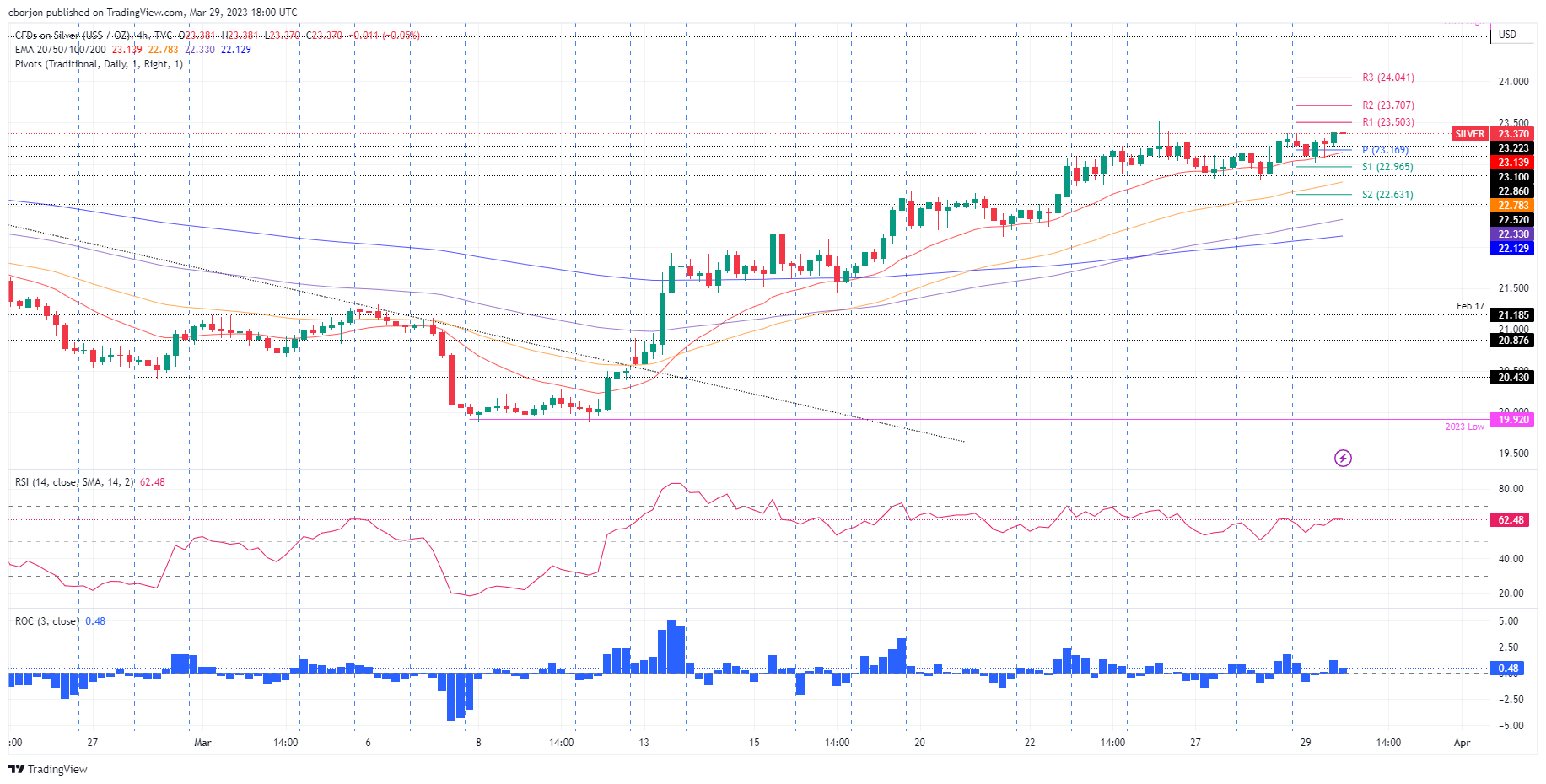
XAG/USD Technical levels
- GBP/USD pulls away from the eight-week highs.
- Analysts forecast to include a final 25bp BoE hike in May.
The British Pound pulled back from the highest level against the dollar in eight weeks on Wednesday, a high made as worries about the health of the global financial system continued to ease. At the time of writing, GBP/USD is down some 0.2% after falling from a high of 1.2361 to a low of 1.2302.
Prior to today's pullback, the Pound Sterling rose by over 0.1% against the US Dollar to 1.2361, its highest since February 2 as it was supported by the rebound in risk appetite. The rebound followed cooling concerns about the banking sector turmoil sparked by US tech lender Silicon Valley Bank (SVB) and the emergency takeover of Credit Suisse by banking rival UBS. The worries of systemic stress had led to market volatility in the anticipation of more bank failures but these worries, however, have now faded. Investors took solace from First Citizens BancShares' agreement to buy all of the failed lender Silicon Valley Bank's deposits and loans.
Additionally, the fact that no further cracks have emerged in global banking this week is a positive. On Tuesday, Michael Barr, the Fed's vice chairman for supervision, told the Senate Banking Committee that Silicon Valley Bank's problems were due to "terrible" risk management, suggesting it could be an isolated case.
Meanwhile, on the domestic front, recently better-than-expected UK economic data may have provided some recent support as well. However, talk of a policy pause clearly made the market nervous ahead of last week’s Bank of England meeting where the BoE hiked by 25bp to 4.25% with 7 members voting for a 25bp hike and two members voting for keeping the Bank Rate unchanged.
´´Overall, the forward guidance was limited with the BoE leaving the door open for another hike at the May meeting if persistent inflation pressures persist,´´ analysts at Danske Bank argued.
´´We revise our forecast to include a final 25bp hike in May, marking a peak in the Bank Rate at 4.50%,´´ the analysts said. ´´Our expectations are in line with current market pricing (currently 30bp priced until August 2023) as we expect the rest of the BoE committee to increasingly turn less hawkish amid a weakening growth backdrop and easing labour market conditions.´´
´´Markets are pricing in 30bp of cuts during H2. We still believe that the first-rate cuts will not be delivered before the beginning of 2024,´´ the analysts concluded.
- US Energy Information Administration (EIA) reports an inventory decrease for the last week.
- US crude oil imports drop to the lowest level since March 2021.
- WTI Price Analysis: Would resume upwards if it breaks above $75.00; otherwise, it would remain sideways.
Western Texas Intermediate (WTI), the US crude oil benchmark, retreated from weekly highs and reached $74.32 in the early New York session. Inventories in the United States (US) dropped, though it failed to underpin WTI’s price. At the time of typing, WTI exchanges hands at $73.08 PB.
US EIA announced that inventories dropped, but WTI remains down
Traders’ sentiment is positive, as shown by US equities climbing. The US Energy Information Administration (EIA) revealed that inventories in the last week fell as refineries ramped up operations once the maintenance period ended. US crude oil imports fell to their lowest level since March 2021.
Delving into the data, crude oil stockpiles dropped by 7.5 million barrels in the week to March 24 to 473.7 million barrels, vs. estimates of 92,000 barrels rise.
Although there was an oil shortage, WTI failed to capitalize as the greenback recovered some ground. The US Dollar Index (DXY), which track’s the value of the American Dollar (USD) against a basket of six currencies, is up 0.31%, at 102.745. That makes oil prices more expensive for international buyers.
After an arbitrage decision, the Norwegian oil firm DNO began shutting down production in Kurdistan’s fields.
WTI Technical analysis
After recovering from trading nearby the YTD lows, WTI is consolidating within the 20 and 50-day Exponential Moving Averages (EMAs), at $72.45-$74.85. For a bullish continuation, WTI needs to crack $75.00, with upside risks at around the 100-day EMA At $77.90. On the other hand, WTI’s would re-test the YTD lows at 64.41, once it broke below $72.00 PB.
Bank of Canada (BOC) Deputy Governor Toni Gravelle said on Wednesday that the BOC is ready to act in the case of severe market-wide stress and provide liquidity support to the financial system, as reported by Reuters.
Additional takeaways
"Quantitative tightening program will likely end sometime around the end of 2024 or first half of 2025; QT is working but will take some time to run its course."
"If faced with extreme event that caused severe dysfunction in government of Canada (GoC) bond market, bank could resort to large-scale GoC bond purchases."
"Bar is very high for bank to use large-scale GoC bond purchases to support market functioning again."
"Bank would only be offering extraordinary liquidity in extreme market-wide situations, when entire financial system faced funding constraints."
"Penalty pricing should be built into extraordinary actions whenever possible to make program unattractive once financial conditions improve."
"If bank were faced with a UK-style pension fund crisis, it could use its contingent term repo facility; this would reduce need for bank to conduct outright bond purchases."
"This level is well below current level of roughly C$200 bln; our best estimate is somewhere in the range of C$20 bln to C$60 bln."
"Canadian banks are not immune to spillover from events elsewhere, which can negatively affect things here."
Market reaction
The USD/CAD showed no reaction to these comments and was last seen losing 0.15% on the day at 1.3580.
- US Pending Home Sales improved, but investors are focused on core PCE figures on Friday.
- Banxico’s monetary policy decision loom, with analysts expecting a 25 bps rate hike.
- USD/MXN Price Analysis: Further downside is estimated, but Banxico’s decision could spur a leg-up.
The USD/MXN continues its free-fall during the week, down 1.45% since Monday, registering five days of consecutive losses. Sentiment improvement, and a strong US Dollar (USD), have not stopped the appreciation of the Mexican currency. At the time of writing, the USD/MXN is trading at 18.1060, down 0.69% in the day.
The Mexican Peso at the mercy of Banxico’s policy decision
A risk on impulse underpinned the Mexican Peso (MXN), which continues to drag the USD/MXN exchange rate, further below the psychological 18.50 barrier, eyeing to test 18.00. Investors’ appetite for risk improved on news that Alibaba will split into six business groups seeking Initial Public Offerings (IPOs). Therefore, Wall Street portrays an optimistic sentiment after a “short-lived” banking crisis.
A light economic calendar in the United States (US) featured that Pending Home Sales for February grew at a 0.8% MoM and exceeded estimates for a plunge of 0.3%, though on an annual basis, decreased by 21.1%, less than the 29.4% plunge foreseen.
Market participants ignored US data as they shifted to the US Federal Reserve’s (Fed) preferred gauge for inflation, the Core Personal Consumption Expenditure (PCE) for February, estimated at 0.4% MoM and 4.7%, annually based.
Additionally, Thursday’s calendar will be packed, with Initial Jobless Claims for the last week, and the Gross Domestic Product (GDP) for Q4
In the meantime, US Treasury bond yields are retreating, with 2s and 10s, each at 4.05% and 3.56%, respectively. The greenback climbs 0.27%, as shown by the US Dollar Index, up at 102.704.
On the Mexican front, the Bank of Mexico (Banxico) will unveil its interest rate decision on Thursday. Analysts foresee a 25 bps rate hike by Banxico. Expectations lie around a possible pause in the hiking cycle, which, although it favors the Mexican Peso (MXN) due to its interest rate differential, could trigger some profit-taking. Therefore, further upside in the USD/MXN could be possible.
USD/MXN Technical analysis
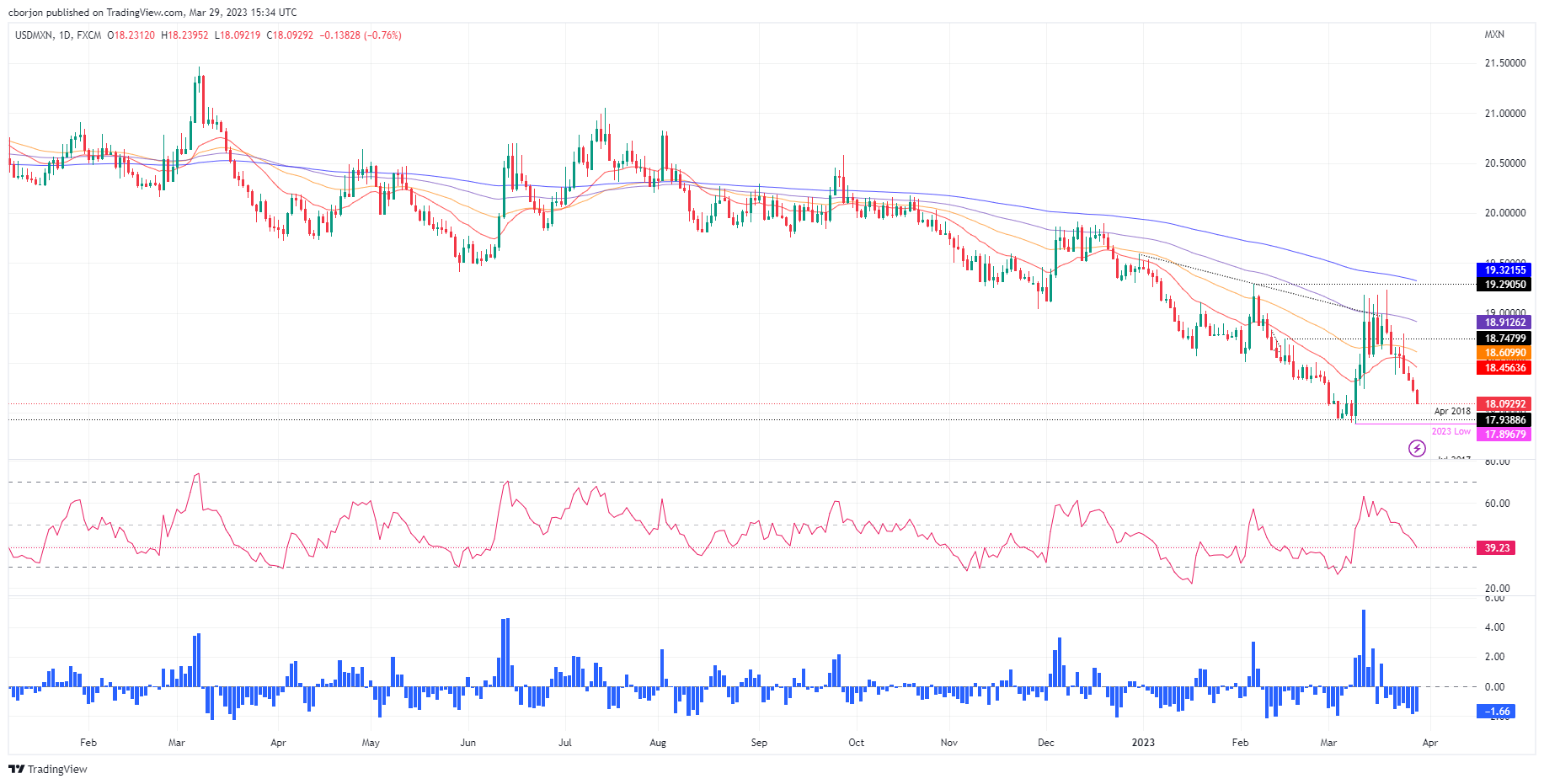
From a daily chart perspective, the USD/MXN is downward biased, eyeing a renewed test of YTD lows at 17.8968. But, the USD/MXN pair needs to clear some hurdles on its way south, like the 18.00 figure, followed by the March 7 low of 17.9664, before challenging the YTD low. If that price level is cleared, the next support would be July 2017 low at 17.4498.
Conversely, the USD/MXN’s first resistance would be the 20-day Exponential Moving Average (EMA) at 18.4607. But oscillators staying at bearish territory suggest the least resistance path is downwards.
"We will be looking at incoming data, financial conditions to make a meeting-by-meeting judgement on rates," Federal Reserve Vice Chair for Supervision Michael Barr said on Wednesday, as reported by Reuters.
Key takeaways
"it's fair to ask if the supervisors of SVB could have been more aggressive."
"We have substantial authority to supervise firms in an appropriate way."
"A tiering approach makes sense."
"But we do need stronger rules on capital and liquidity for banks of $100 bln and up."
"Monetary policy decisions were well-telegraphed and essential to meet mandates."
"Bank management failed to manage straightforward interest-rate risk."
Market reaction
The US Dollar Index clings to modest daily recovery gains at 102.70 following these comments.
Gold remains below its $2,070/2075 record highs and has started a short-term consolidation. A sustained move above $2,000/10 is needed to reinvigorat upside pressure, economists at Credit Suisse report.
XAU/USD could see further weakness on failure to defend 55-DMA
“A sustained move beyond $2,000/10 stays seen needed to clear the way for a retest of long-term resistance from the $2,070/75 record highs of 2020 and 2022. Whilst this should clearly be respected, a clear and sustained break higher would be seen to open the door to a move to $2,300 next.”
“Ideally, the 55-DMA, currently seen at $1,891, floors the market now. If this breaks, we could see further weakness towards the recent range low at $1,805, before the crucial 200-DMA, currently seen at $1,781, which we would once more expect to provide a floor.”
The month of March proved eventful for the Euro with a nearly 4 cent difference between the low and high marks. Economists at the National Bank of Canada expect the shared currency to strengthen in the second half of the year.
Financial system volatility
“March was characterized by disruption in the global financial system stemming from the repercussions of woes in the US banking system. Compounded to this was the takeover of Credit Suisse by UBS. With the dust now settling from the transpired events, the collective currency has stabilized to some extent.”
“Continued tightening by the European Central Bank and a let up from the US Federal Reserve could translate into a narrowing of monetary policy. As such, we see the potential for some Euro appreciation in the second half of the year assuming data remains resilient on the European side.”
CAD pessimism looks overdone, in the view of Kit Juckes, Chief Global FX Strategist at Société Générale.
In 2019, peak Fed Funds signalled peak USD/CAD
“No-one expects the Bank of Canada to hike rates on April 14, rate differentials and consensus growth forecasts are both CAD-unfriendly. Soft oil prices don’t help, and a North American banking crisis could spill over the border. All of these negative factors are known, however.”
“Short USD/CAD on this basis, is well positioned to benefit from a gradual easing in concerns about the banking sector, and a peak in Fed rates. The last time the speculative market was this short of CAD, back at the start of 2019, the Fed had just finished hiking rates, and by the end of the year, USD/CAD was back under 1.30.”
- Pending Home Sales in the US increased unexpectedly in February.
- US Dollar Index clings to modest recovery gains slightly above 102.50.
Pending Home Sales in the US rose by 0.8% on a monthly basis in February, the data published by the National Association of Realtors showed on Wednesday. This reading followed January's increase of 8.1% and came in better than the market expectation for a decrease of 0.8%.
On a yearly basis, Pending Home Sales declined by 21.1%, compared to analysts' estimate for a decline of 29.4%.
Market reaction
The US Dollar Index showed no immediate reaction to these data and was last seen trading modestly higher on the day at 102.60.
- EUR/USD advances to the 1.0870 region earlier on Wednesday.
- The dollar remains bid across the board amidst higher US yields.
- Hawkish ECB speak keeps the pair on the positive side.
EUR/USD clings to daily gains around the 1.0850 region against the backdrop of a firm note in the greenback on Wednesday.
EUR/USD: Weekly gains look capped near 1.0870
EUR/USD trades within the familiar range, up slightly in the mid-1.0800s against the backdrop of the moderate bounce in the greenback.
The better tone in the European currency looks propped up by comments from ECB’s rate setters. Indeed, ECB Board member Kazimir suggested that the core inflation could take a key role when it comes to interest rate decisions at the time when he left the door open to further rate hikes, albeit at a slower pace. In addition, member Lane defended further rate hikes and suggested inflation in the region could drop rapidly by year end.
In the euro calendar, Consumer Confidence tracked by GfK in Germany improved marginally to -29.5 for the month of April (from -30.6), while the Consumer Confidence in France receded to 81 in March (from 82).
In the US, MBA Mortgage Applications expanded 2.9% in the week to March 24 and Pending Home Sales are due later.
What to look for around EUR
The weekly recovery in EUR/USD meets initial resistance near 1.0870 amidst the resumption of some USD-buying.
In the meantime, price action around the European currency should continue to closely follow dollar dynamics, as well as the potential next moves from the ECB in a context still dominated by elevated inflation, although amidst dwindling recession risks for the time being.
Key events in the euro area this week: Germany GfK Consumer Confidence, France Consumer Confidence (Wednesday) – Germany Flash Inflation Rate, EMU Consumer Confidence, Economic Sentiment (Thursday) – Germany Retail Sales/Labor Market Report, EMU Flash Inflation Rate/Unemployment Rate, France Flash Inflation Rate, Italy Flash Inflation Rate (Friday).
Eminent issues on the back boiler: Continuation, or not, of the ECB hiking cycle. Impact of the Russia-Ukraine war on the growth prospects and inflation outlook in the region. Risks of inflation becoming entrenched.
EUR/USD levels to watch
So far, the pair is gaining 0.04% at 1.0846 and a break above 1.0929 (monthly high March 23) would target 1.1032 (2023 high February 2) en route to 1.1100 (round level). On the downside, the next support aligns at 1.0712 (low March 24) followed by 1.0637 (100-day SMA) and finally 1.0516 (monthly low March 15).
- AUD/USD drifts lower on Wednesday and is pressured by a combination of factors.
- The softer Australian CPI lifts RBA rate pause bets and weighs heavily on the Aussie.
- Rising US bond yields revive the USD demand and further contribute to the decline.
The AUD/USD pair comes under some renewed selling pressure on Wednesday and reverses a major part of the previous day's positive move. The pair maintains its offered tone through the early North American session and is currently placed near the lower end of its daily range, around the 0.6670-0.6660 region.
The Australian Dollar started losing ground in reaction to the softer-than-expected domestic consumer inflation figures, which fuels speculation that the Reserve Bank of Australia (RBA) could pause its rate-hiking cycle at the April meeting. In fact, the Australian Bureau of Statistics (ABS) reported that the headline CPI decelerated from the previous month's reading of 7.4% to 6.8% in the year to February, marking the slowest rise since June 2022. This, along with a modest pickup in the US Dollar (USD) demand, is seen exerting some downward pressure on the AUD/USD pair.
Having registered losses over the past two days, the USD regains some positive traction amid a further rise in the US Treasury bond yields. Easing fears of a full-blown banking crisis continues to push the US bond yields higher. That said, the Federal Reserve's less hawkish outlook could act as a headwind for the US bond yields and the Greenback. It is worth recalling that the US central bank last week toned down its approach to reining in inflation and signalled that a pause to interest rate hikes was on the horizon in the wake of the recent turmoil in the banking sector.
Apart from this, the prevalent risk-on mood - as depicted by a strong opening rally around the US equity markets - could cap gains for the safe-haven buck and lend some support to the risk-sensitive Aussie. This, in turn, makes it prudent to wait for strong follow-through selling before positioning for any further depreciating move for the AUD/USD pair. Even from a technical perspective, the recent two-way price action witnessed over the past two weeks or so points to indecision over the next leg of a directional move and warrants some caution for bearish traders.
Technical levels to watch
Risks for BRL remain high despite hawkish Brazilian central bank (BCB), economists at Commerzbank report.
Toing and froing about the fiscal framework is another risk factor for BRL
“The government’s criticism of the monetary policy not only constitutes a risk factor for the BRL but also makes the BCB’s job more difficult. The government’s debate about revising the inflation target is likely to have contributed to higher inflation expectations.”
“In our view the toing and froing about the fiscal framework is another risk factor for BRL. Even though the government seemed optimistic that it would convince the market with its solid household plans thanks to the fiscal framework, doubts remain. In particular since the susceptibility of the BRL regarding budget risks is likely to have increased further as a result of the recent turbulence on the global financial markets.”
- Japanese Yen is under pressure across the board on risk appetite and higher US yields.
- DXY is up by 0.30% on Wednesday, down by 2.20% in March.
- USD/JPY is having the biggest daily gain of the month, rising more than 150 pips.
Following a correction to 131.55, the USD/JPY resumed the upside, breaking firmly above 132.00. It is trading at its highest level in a week at 132.55/60. It is up by 175 pips, the biggest daily gain in a month.
The pair has been moving all day with a bullish bias. On Asian hours it was supported by a broad-based recovery of the US Dollar. More recently, the move higher gained speed boosted by higher US yields.
The US 10-year Treasury bond yield reached 3.61% and the 2-year climbed to 4.14%, both at the highest levels in a week. On Wall Street, US equities opened with strong gains. The Dow Jones is up by 0.70% and the Nasdaq gains 1.30%.
The combination of risks appetite and higher US yields, as the banking crisis fades, weighs on the Japanese Yen. The currency is the worst performer on Wednesday among the most traded currencies.
USD/JPY looking at 133.00
In the daily chart, the pair is above the 55-periord Simple Moving Average (SMA), currently at 132.40. On the upside, the next barrier is the 133.00 area. A consolidation above would clear the way to more gain. On the flip side, the 131.80 zone has become the key support.
-638156942991823286.png)
Technical levels
S&P 500 strength stays seen as temporary. Analysts at Credit Suisse look for an eventual test of the 200-week average at 3743.
Break above 4078 to reassert an upward bias
“The S&P 500 rebound has been capped at its downtrend from February, and the market could be forming a potential ‘head and shoulders’ top. Strength therefore stays seen as temporary, and we look for an eventual test of the 200-week average at 3743. Below here at any stage would open up a move back to the 3505/3492 lows.”
“Above 4078 would be seen to reassert an upward bias for strength back to 4195, possibly even 4312/4325.”
The USD is trading mixed versus the majors. Economists at Scotiabank expect the greenback to sustain further losses ahead.
Strengthening downtrend continues to develop
“Passive equity hedge rebalancing signals for the USD over the past month appear to be USD-negative (ex-JPY) but positive over a Q1 perspective and may ultimately work against each other – but these flows could still buffet intraday trade to an extent.”
“USD losses are poised to extend further overall as markets focus on the maturing Fed policy cycle; the DXY’s failure to make deeper headway through the mid-103 area last week keeps the near-term technical tone negative as a strengthening downtrend continues to develop.”
- GBP/USD pulls back from its highest level since February touched earlier this Wednesday.
- A further rise in the US bond yields revives the USD demand and exerts some pressure.
- The fundamental backdrop supports prospects for additional near-term gains for the pair.
The GBP/USD pair retreats from the 1.2360 area, or its highest level since February 03 touched this Wednesday and trades with modest losses during the early North American session. Spot prices, for now, seem to have snapped a two-day winning streak, though manage to hold comfortably above the 1.2300 round-figure mark, or the daily swing low.
The US Dollar (USD) gains some positive traction amid a further rise in the US Treasury bond yields and is seen as a key factor acting as a headwind for the GBP/USD pair. Hopes that a full-blown banking crisis can be averted might have been averted fuel speculations that the Federal Reserve (Fed) might stick to its policy tightening path, which, in turn, continue to push the US bond yields higher. That said, the prevalent risk-on mood - as depicted by a generally positive tone around the equity markets - might hold back traders from placing aggressive bullish bets around the safe-haven Greenback.
In the absence of negative news from the banking sector over the past two weeks, the takeover of Silicon Valley Bank by First Citizens Bank & Trust Company calmed market nerves about the contagion risk. Furthermore, US regulators reiterated strength in the banking system and helped reverse the recent negative sentiment in the markets. Furthermore, the Bank of England (BoE) Governor Andrew Bailey told the House of Commons Treasury Select Committee on Tuesday that the UK banking system is in a strong position and is not experiencing stress linked to the global turmoil in the banking sector.
Apart from this, bets for additional rate hikes by the BoE continue to act as a tailwind for the British Pound. The expectations were reaffirmed after the British Retail Consortium (BRC) reported that UK shop prices increased from 8.4% previously to 8.9% in the year to March - the highest reading on record since the survey started in 2005. Adding to this, food prices increased 15.0% over the year, also a record high. This, in turn, supports prospects for a further near-term appreciating move for the GBP/USD pair, warranting some caution before positioning for any meaningful corrective pullback.
Technical levels to watch
EUR/USD could increase further and challenge the 1.10 level, economists at HSBC report.
Key local driver is likely to be core inflation
“The key local driver is likely to be core inflation, which has continued to push higher. We believe it can nudge higher still. Germany will reveal its preliminary March data on 30 March, with France and the Eurozone aggregate data out the next day.”
“EUR/USD is vulnerable to any ‘risk off’ mood but, barring surprises, a test of 1.10 level is likely over the near term, supported by rate differentials.”
- EUR/USD rose to fresh 3-day tops around 1.0870 on Wednesday.
- Further upside could revisit the monthly high near 1.0930.
EUR/USD climbs to fresh multi-day highs near 1.0870 amidst the continuation of the weekly rebound on Wednesday.
The likelihood of extra advances appears favoured for the time being. Against that, the pair could now set sail to the March peak at 1.0929 (March 23) prior to a potential test of the 2023 high at 1.1032 (February 2).
Looking at the longer run, the constructive view remains unchanged while above the 200-day SMA, today at 1.0336.
EUR/USD daily chart

Economists at TD Securities do not expect a meaningful MXN reaction to Banxico's decision on Thursday as they consider it has been mostly priced in.
Banxico to fulfill its 25 bps hike promise
“We expect Banxico to hike in 25 bps on March 30 and hit terminal at 11.25%. We think the bar is high for the central bank to contradict its own forward guidance once again.”
“We do not expect a meaningful MXN reaction to Banxico's decision as we think it has been mostly priced in. However, we expect gradual weakening of MXN against the USD in the coming months.”
“We still expect USD/MXN levels at 20.00 by year-end, though we acknowledge risks are tilted to the downside.”
- USD/CAD drops to over a three-week low, though lacks strong follow-through.
- Bullish Crude Oil prices continue to underpin the Loonie and exert pressure.
- A modest USD strength lends some support to the pair and helps limit losses.
The USD/CAD pair turns lower for the third straight day following an early uptick to the 1.3615 area on Wednesday and drops to its lowest level since early March heading into the North American session. The pair, however, manage to bounce a few pips in the last hour and currently trades with only modest intraday losses, just below the 1.3600 round-figure mark.
Crude Oil prices prolong a three-day-ole bullish trend and climb to over a two-week high, which, in turn, is seen underpinning the commodity-linked Loonie and exerting some downward pressure on the USD/CAD pair. A halt to some exports from Iraq's Kurdistan region raised concerns about tightening global supplies. This, along with hopes for a strong fuel demand recovery in China, continues to support Oil prices amid a drop in US crude inventories.
In fact, market sources, citing American Petroleum Institute figures on Tuesday, suggested that Crude stocks in the US fell by 6.1 million barrels last week. Investors now look to the official US inventory data from the Energy Information Administration to see if it confirms the Crude stock decline. In the meantime, easing fears of a full-blown banking crisis remains supportive of the prevalent risk-on environment and lends additional support to the black liquid.
That said, the emergence of some US Dollar (USD) buying lends some support to the USD/CAD pair and limits the downside, at least for the time being. The USD uptick, meanwhile, lacks any obvious fundamental catalyst and runs the risk of fizzling out rather quickly in the wake of the Federal Reserve's (Fed) less hawkish outlook. In fact, the US central bank signalled last week that a pause to interest rate hikes was on the horizon amid the recent banking turmoil.
This, along with a fresh leg down in the US Treasury bond yields and a generally positive tone around the equity markets, keeps a lid on any meaningful gains for the safe-haven Greenback. The fundamental backdrop suggests that the path of least resistance for the USD/CAD pair is to the downside. The negative outlook is reinforced by the overnight breakdown below the 1.3630 support. Hence, any attempted recovery move might still be seen as a selling opportunity.
Technical levels to watch
Economists at HSBC maintain their bullish view on the British Pound.
GBP should benefit from an improvement in global risk appetite
“Our base case is that the GBP should benefit from an improvement in global risk appetite.”
“Recent upward surprises to domestic activity data, a potentially sharp fall in supply-side driven inflation through the summer, and an improving UK trade balance should also support the GBP. Until we see clearer signs of those factors changing, we maintain our bullish view on the GBP.”
The CAD is trading at its highest against the USD since the early part of March. Economists at Scotiabank expect the USD/CAD pair to challenge the low 1.35s on a move under the 1.3570 support.
Resistance aligns at 1.3650/60
“USD/CAD losses through the low/mid 1.36s confer a softer technical tone on the short-term charts but the Loonie has a lot of work to do still to show any real technical strength.”
“A move under 1.3570 (50% retracement of the Feb/Mar USD rise) would pave the way for a test of the low 1.35 region where the 100-Day Moving Average (which has been a good bellwether for USD/CAD recently) stands at 1.3517.”
“Resistance is 1.3650/60.”
EUR/USD rebounds from early losses. Ultimately, a move through to 1.10+ looks on the cards, economists at Scotiabank report.
Limited scope for counter-trend corrections
“Bullish trend signals on the short, medium and long-term oscillators suggests limited scope for counter-trend corrections and ongoing pressure for gains to extend towards the low 1.09s and a retest of last week’s high at 1.0927.”
“Higher rates in Europe while the outlook for Fed policy remains uncertain will help keep the EUR supported and on tracking for a test of 1.10+.”
- USD/JPY catches aggressive bids on Wednesday and climbs to a one-week high.
- The risk-on mood undermines the safe-haven JPY and lends support to the pair.
- The Fed’s less hawkish stance keeps the USD on the defensive and caps the upside.
The USD/JPY pair regains positive traction following the previous day's downfall and maintains its bid tone through the mid-European session on Wednesday. The momentum pushes spot prices to a one-week high, though bulls struggle to capitalize on the move further beyond the 132.00 round-figure mark.
Easing fears of a full-blown banking crisis remains supportive of a generally positive tone around the equity markets, which, in turn, undermines the safe-haven Japanese Yen (JPY) and acts as a tailwind for the USD/JPY pair. The takeover of Silicon Valley Bank by First Citizens Bank & Trust Company calmed market nerves about the contagion risk. This, coupled with the lack of negative news from the banking sector over the past two weeks, further boosted investors' confidence and helps reverse the recent negative sentiment.
The JPY is further weighed down by the overnight dovish-sounding remarks by Bank of Japan (BoJ) Governor Haruhiko Kuroda, saying that it is too early to debate an exit from easy monetary policy. Adding to this, the recent widening of the US-Japan rate differential, led by a rally in the US Treasury bond yields witnessed since the beginning of the current week, also contributes to driving flows away from the JPY. That said, subdued US Dollar (USD) demand holds back traders from placing fresh bullish bets around the USD/JPY pair.
The Federal Reserve (Fed) last week toned down its approach to reining in inflation and signalled that a pause to interest rate hikes was on the horizon in the wake of the turmoil in the banking sector. This leads to a fresh leg down in the US Treasury bond yields and could act as a headwind for the USD. The BoJ, on the other hand, is expected to tweak its bond yield control policy and whittle down its massive stimulus under new Governor Kazuo Ueda. This further contributes to keeping a lid on the USD/JPY pair, at least for the time being.
Market participants now look to the US economic docket, featuring the release of Pending Home Sales later during the early North American session. Apart from this, the US bond yields will influence the USD price dynamics and provide some impetus to the USD/JPY pair. Traders will further take cues from the broader market risk sentiment to grab short-term opportunities. The focus, however, remains glued to the release of the Fed's preferred inflation gauge - the US Core PCE Price Index, due on Friday.
Technical levels to watch
- DXY attempts a mild rebound to the 102.70.75 band on Wednesday.
- The monthly low near 101.90 emerges as a decent contention area.
DXY attempts to leave behind part of the recent downside pressure, although the bull run faltered near 102.70 on Wednesday.
In the meantime, it seems the index has moved into some consolidative phase. The drop below the March low at 101.91 (March 23) is expected to encourage sellers to return to the market and open the door to a potential visit to the 2023 low around 100.80 (February 2).
Looking at the broader picture, while below the 200-day SMA, today at 106.57, the outlook for the index is expected to remain negative.
DXY daily chart
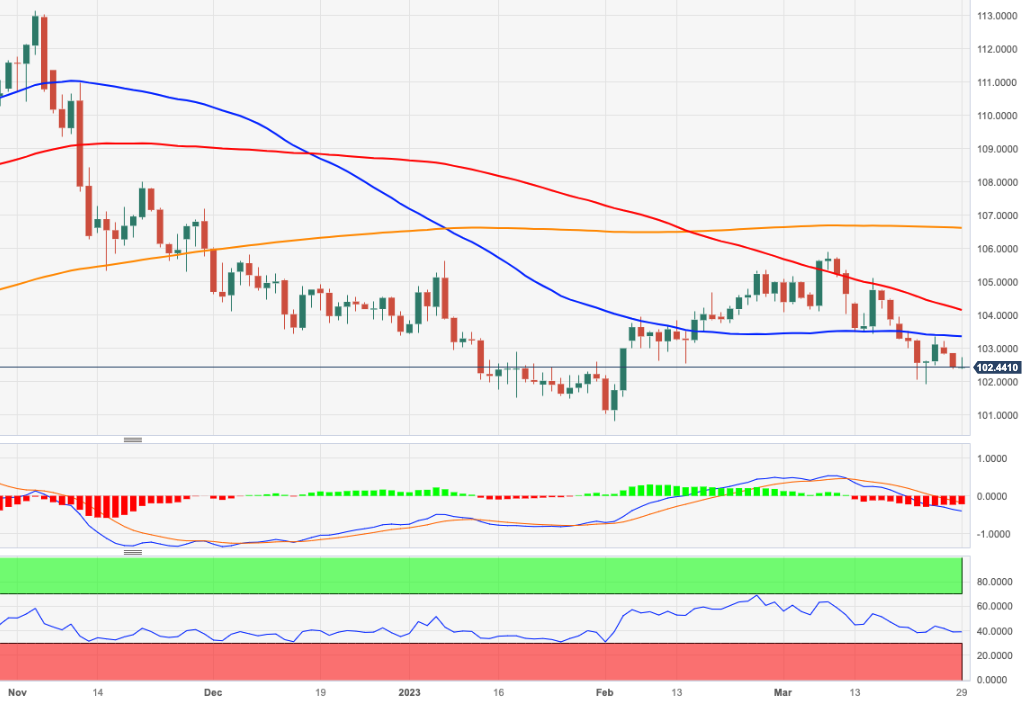
GBP/USD trades firm in mid-1.23s. Economists at Scotiabank expect the pair to retest the late 2022/early 2023 peaks at 1.2445.
Foreign investors remain wary of Gilts
“Foreign investors remain net sellers of UK government bonds. Net outflows were much smaller than Jan record net exodus (GBP28 bn) but the trend remains a concern after the late 2022 volatility in UK markets. The data had no impact on the GBP’s intraday performance, however.”
“GBP/USD gains are pressuring last week’s peak at 1.2342; trend oscillators are bullishly aligned across a range of timeframes making a retest of the late 2022/early 2023 peaks at 1.2445 a likelihood in the near future, provided that strong trend support on the intraday chart at 1.2290 remains intact.”
- EUR/JPY leaves behind Tuesday’s small downtick and retakes 143.00.
- The breakout of the consolidation theme faces resistance near 145.60.
EUR/JPY advances markedly and regain the area beyond the 143.00 hurdle to print new multi-session peaks on Wednesday.
The cross so far surpasses the key 200-day SMA near 141.80, and a sustainable surpass of this region should open the door to further upside in the short-term horizon. Moving forward, the consolidation theme is expected to remain unchanged, while a more serious bounce should target the monthly highs around 145.50.
In the meantime, extra losses remain on the table while the cross trades below the 200-day SMA.
EUR/JPY daily chart
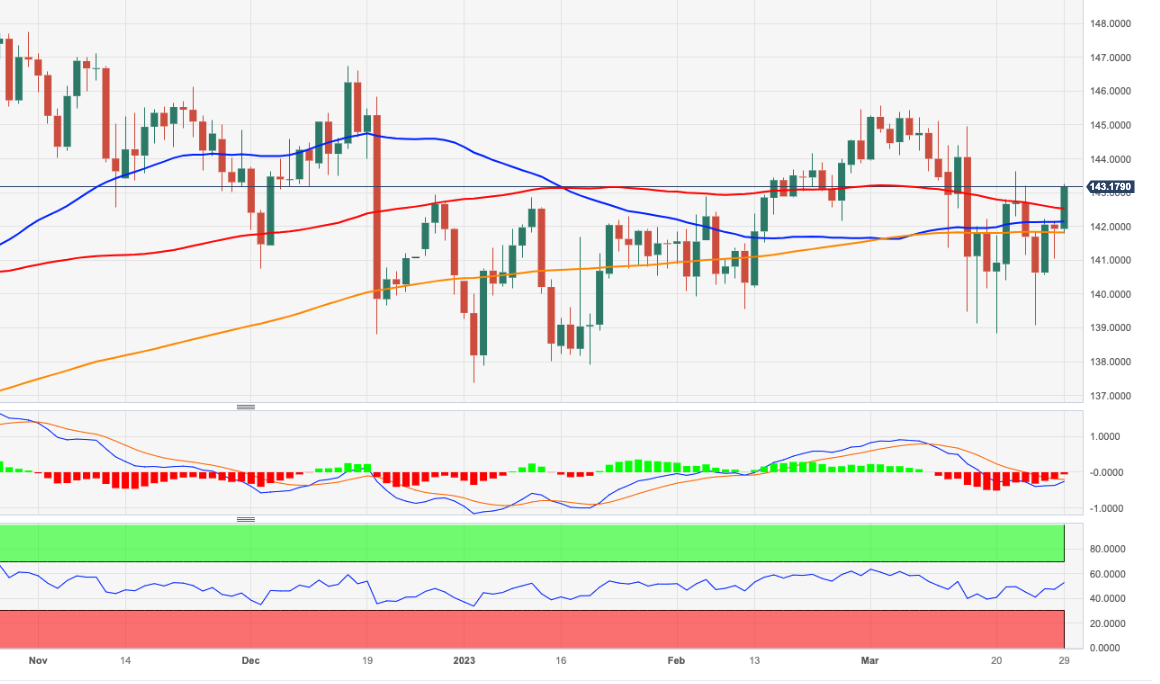
The US Dollar weakened modestly further yesterday. Nonetheless, economists at MUFG Bank expect the EUR/USD rally to fade as the pair nears the 1.10 mark.
It is difficult to envisage the current divergence in policy expectations being sustained
“It is difficult to envisage the current divergence in policy expectations being sustained if the data from the US remains resilient.”
“The OIS market currently implies 50 bps of hikes by the ECB by September while the market is 80% priced for a 25 bps rate cut from the Fed by then. Without further banking sector turmoil, data flow will dictate the sustainability of that degree of divergence in policy expectations and based on the consumer confidence data there is a greater risk of that divergence closing which could see EUR/USD again run out of steam as we move toward the 1.1000 level.”
EUR/CZK erased gains of the past two days yesterday. A break below 23.58/23.53 would open up 23.35, then 23.00/22.88, analysts at Société Générale report.
Initial resistance seen at 23.85
“Lower band of this range at 23.58/23.53 which is also the 76.4% retracement of recent bounce is important support. If the pair fails to defend this, resumption in downtrend is not ruled out. In such a scenario, next potential objectives are likely to be at the low formed earlier this month near 23.35 and 23.00/22.88.”
“Upper end of range at 23.85 is first resistance.”
Antje Praefcke, FX Analyst at Commerzbank, expects the US Dollar to struggle against the Euro.
Levels in EUR/USD above 1.08 seem justified
“The market clearly remains more sceptical towards the US as opposed to the Euroze. That is why the Dollar has a more difficult standing against the Euro, as the Fed has become a little more cautious whereas the ECB has continued its rate cycle almost unaffected by the events of the past weeks and continues to sound restrictive. As a result, levels in EUR/USD above 1.08 seem justified.”
“Monetary policy remains the most important driver. That is why in my view focus will remain on the price data. On the other hand, I think that it is not (yet) going to be sufficiently surprising to provide much momentum. For that to happen market uncertainty would have to ease too. However, that also means that the Dollar is unlikely to be able to gain ground considerably for now.”
- USD/CHF retreats from a one-week high and reverses a major part of the overnight gains.
- The Fed’s less hawkish stance, sliding US bond yields weigh on the USD and exert pressure.
- The risk-on mood does little to undermine the safe-haven CHF or lend support to the pair.
The USD/CHF pair struggles to capitalize on its modest intraday gains and attracts fresh sellers near the 0.9220-0.9225 area, or a one-week high touched earlier this Wednesday. The pair drops to the 0.9165 region during the first half of the European session and has now reversed a major part of the previous day's losses.
Against the backdrop of the Federal Reserve's (Fed) less hawkish stance, a fresh leg down in the US Treasury bond yields is seen weighing on the US Dollar (USD) and exerting some downward pressure on the USD/CHF pair. It is worth recalling that the US central bank last week toned down its approach to reining in inflation and signalled that a pause to interest rate hikes was on the horizon in the wake of the recent turmoil in the banking sector. This, in turn, keeps the USD bulls on the defensive and continues to act as a headwind for the USD/CHF pair.
Even the prevalent risk-on mood - as depicted by a generally positive tone around the equity markets - does little to weigh on the safe-haven Swiss Franc (CHF) or lend any support to the USD/CHF pair. This, in turn, suggests that the path of least resistance for spot prices is to the downside and any attempted recovery move is more likely to get sold into. That said, the range-bound price action witnessed over the past week or so points to indecision over the next leg of a directional move for the major and warrants some caution for aggressive traders.
Market participants now look to the Swiss National Bank's (SNB) Quarterly Bulletin for fresh clues about the domestic economy, especially after the recent developments surrounding the Credit Suisse saga. The US economic docket, meanwhile, features the release of Pending Homes Sales data, which, along with the US bond yields, might influence the USD and provide some impetus to the USD/CHF pair. The market focus, however, will remain glued firmly to the US Core PCE Price Index, the Fed's preferred inflation gauge - due on Friday.
Technical levels to watch
AUD/USD trims yesterday’s gains after below forecast February CPI cements case for RBA pause next Tuesday. Nonetheless, economists at Société Générale expect the Aussie to edge higher over the medium-term.
Increased likelihood of a pause by the RBA next week and stymies support for the AUD
“In Australia, CPI surprised to the downside after slowing to 6.8% yoy in February, the lowest since last June. The decline was led mainly by housing, transport, recreation and culture. This increases the likelihood of a pause by the RBA next week and stymies support for the AUD.”
“Valuations, optimism over the Chinese economy and peak in US rates suggest AUD/USD should strengthen over the medium-term.”
USD/JPY has been in a downtrend since early March reflecting Yen’s safe haven credentials. Rabobank’s central view is that USD/JPY is likely to hold around current levels on a one-to-three month view.
Stresses of the past few weeks are unlikely to be the last
“Although risk appetite has improved this week, the global economy has to become accustomed to operating in a higher interest rate environment. That suggests that the stresses of the past few weeks are unlikely to be the last.”
“We maintain a three-month USD/JPY 131.00 forecast.”
Today's calendar includes a monetary policy meeting of the Czech National Bank (CNB). Economists at ING expect EUR/CZK to move below 23.50.
CNB to confirm its readiness to intervene in the FX market should the CZK move higher
“We expect the CNB to follow other European central banks with a hawkish tone today, which may favour a repricing of rate cut expectations and a higher CZK.”
“Together with the Hungarian Forint, the Koruna has the highest beta against the global story and higher EUR/USD and low energy prices are playing into its hands. Moreover, we expect the CNB to confirm its readiness to intervene in the FX market should the CZK move higher. Thanks to that, the potential loss is limited and moreover, we believe the market is not ready for CNB intervention levels at the moment, which we estimate at around 24.60-24.70 EUR/CZK. Moreover, the Koruna maintains decent carry within the CEE region.”
“We believe the Koruna has the best risk/reward within the region at the moment and we expect a move below 23.50 EUR/CZK today.”
- NZD/SUD faces rejection near the 200-day SMA and meets with a fresh supply on Wednesday.
- A goodish intraday pickup in the USD demand turns out to be a key factor exerting pressure.
- The Fed’s less hawkish stance, a positive risk tone caps the USD and lends support to the pair.
The NZD/USD pair once again fails near a technically significant 200-day Simple Moving Average (SMA) and comes under fresh selling pressure on Wednesday. Spot prices, however, remain depressed through the first half of the European session and currently trade just below mid-0.6200s, down less than 0.15% for the day.
The US Dollar (USD) gains some positive traction and snaps a two-day losing streak, which, in turn, is seen as a key factor acting as a headwind for the NZD/USD pair. The USD uptick, however, lacks any obvious fundamental catalyst and remains capped amid the Federal Reserve's less hawkish stance. In fact, the US central bank last week toned down its approach to reining in inflation and signalled that a pause to interest rate hikes was on the horizon in the wake of the recent turmoil in the banking sector.
Apart from this, the prevalent risk-on mood - as depicted by a generally positive tone around the equity markets - caps gains for the safe-haven Greenback and lends some support to the risk-sensitive Kiwi. The takeover of Silicon Valley Bank by First Citizens Bank & Trust Company calmed nerves about the contagion risk. This, coupled with the lack of any bad news from the banking sector over the past two weeks, boosts investors' confidence and helped reverse the recent negative sentiment in the markets.
The aforementioned fundamental backdrop supports prospects for some meaningful appreciating move for the NZD/USD pair. That said, repeated failures to make it through the very important 200-day SMA make it prudent to wait for strong follow-through buying before placing fresh bullish bets. Traders now look to the US economic docket, featuring Pending Home Sales data. This, along with the US bond yields and the broader risk sentiment, might influence the USD and provide some impetus to the major.
Technical levels to watch
Since the beginning of the banking crisis in the United States and in Europe, all bank shares have fallen considerably. Analysts at Natixis seek to determine whether or not the decline in bank share prices in the US and the Eurozone is rational.
Is the decline in bank share prices rational?
“Banks in the US and the Eurozone are benefiting from higher interest rates.”
“US banks, especially unregulated banks, regional banks, are incurring significant losses on bond portfolios.”
“Interconnection between banks in the money market is weak.”
“All things considered, the large US and European banks look solid.”
USD/CNH should keep the side-lined trade well in place within the 6.8100-6.9200 range in the short-term horizon, comment Economist Lee Sue Ann and Markets Strategist Quek Ser Leang at UOB.
Key Quotes
24-hour view: “Our view for USD to trade with a downward bias did not materialize as it traded in a muted manner between 6.8720 and 6.8900 before closing largely unchanged at 6.8796 (-0.05%). The price movements are likely part of a consolidation phase and we expect USD to trade in a range of 6.8700/6.8950 today.
Next 1-3 weeks: “There is not much to add to our update from Monday (27 Mar, spot at 6.8700). As highlighted, the recent USD weakness has stabilized. The current movement is likely the early parts of a consolidation phase and USD is likely to trade between 6.8100 and 6.9200 for now.”
Economists at ING continue to see mostly downside risks for the US Dollar.
Fed’s lack of clarity counts more than the magnitude of cuts
“Markets moved from pricing in a 24% chance of a hike in May and 88 bp of cuts by year-end on Friday to a 47% implied probability of a hike in May and 46 bp of cuts by year-end as of this morning. In a way, this is telling us how it’s the stance of the Fed and its unclear communication (especially given the contrast with the European counterparts) that leaves the Dollar vulnerable in a stable risk environment and not necessarily the magnitude of expected rate cuts.”
“So, is it going to be a straight-line USD depreciation from now on? We don’t think so. The room for corrections is non-negligible, and those can be triggered either by new risk-off waves outside of the US (like the one seen in Europe on Friday) or by attempts from Fed members to re-establish more hawkish rhetoric.”
European Central Bank (ECB) Chief Economist Philip Lane said on Wednesday, “ECB rates must rise if banking tension has no or ‘fairly limited’ impact.”
Additional comments
“Bank sector tensions are seen settling down; no reason to expect major problems.”
“Some early stage pricing in production showing signs of a turnaround.”
“Euro-area inflation is set to decline rapidly at the year-end.”
“Europe's banks have been prudent in their lending, the system is well capitalized and profitable.”
Related reads
- EUR/USD comes under pressure near 1.0850
- ECB’s Kazimir: We should continue in raising rates, possibly at slower pace
- GBP/USD retreats from a multi-week high amid a goodish pickup in the USD demand.
- The Fed’s less hawkish outlook, the risk-on mood should cap the USD and lend support.
- Rising bets for more BoE rate hikes favour the GBP bulls and help limit the downside.
The GBP/USD pair comes under some selling pressure on Wednesday, snapping a two-day winning streak and eroding a part of the overnight gains to its highest level since early February. The pair drops to a fresh daily low during the first half of the European session, albeit finds some support near the 1.2300 mark and recovers a few pips in the last hour.
Following a two-day downtrend, the US Dollar (USD) regains positive traction and turns out to be a key factor that exerts some downward pressure on the GBP/USD pair. The takeover of Silicon Valley Bank by First Citizens Bank & Trust Company calmed market nerves about the contagion risk and eased fears of a full-blown banking crisis. This, in turn, led to a strong recovery in the US Treasury bond yields since the beginning of the current week, which, in turn, helps revive the USD demand.
That said, the Federal Reserve's (Fed) less hawkish stance, signalling that a pause to interest rate hikes was on the horizon, acts as a headwind for the US bond yields. Apart from this, the prevalent risk-on mood - as depicted by a generally positive tone around the equity markets - might hold back traders from placing aggressive bets around the safe-haven buck. This, along with rising bets for additional rate hikes by the Bank of England (BoE), could lend some support to the GBP/USD pair.
In fact, BoE Governor Andrew Bailey said earlier this week that interest rates may have to move higher if there were signs of persistent inflationary pressure. The bets were lifted further after the British Retail Consortium (BRC) reported that UK shop prices increased from 8.4% previously to 8.9% in the year to March - the highest reading on record since the survey started in 2005. Furthermore, food prices increased 15.0% over the year, also a record high, and could benefit the British Pound.
This, in turn, suggests that the path of least resistance for the GB/USD pair is to the upside and any subsequent pullback might still be seen as a buying opportunity. There isn't any relevant macro data due for release on Wednesday from the UK, while the US economic docket features Pending Home Sales later during the early North American session. This, along with the US bond yields and the broader risk sentiment, might influence the USD price dynamics and provide some impetus.
Technical levels to watch
Japanese Prime Minister Fumio Kishida is making some comments on the country’s wage outlook this Wednesday.
Key quotes
“Aiming to narrow wage gaps between Japan and overseas.”
“Wage hikes will be one of the three pillars of new capitalism.“
“Aiming to draw up guidelines for steps including wage hikes, reskilling workers by June.”
Market reaction
USD/JPY is a little impressed by the above comments, keeping its range at around 132.00, up 0.84% on the day.
In a statement on Wednesday, UK Finance Minister Jeremy Hunt said that “I want to be the chancellor who simplifies taxes.”
Additional takeaways
“It is obvious that you cannot finance tax cuts by raising borrowing.”
“We are gaining stability and beginning to pay down debt.”
While speaking on inflation, Hunt said, that he has “confident in forecasts” and that there “can be no complacency.“
Hunt added that “core inflation will be harder to bring down.”
Market reaction
GBP/USD is making a minor recovery attempt to near 1.2325, still down 0.11% on the day, as of writing.
In the view of Antje Praefcke, FX Analyst at Commerzbank, the Riksbank must continue its fight against inflation with determination. If not, Krona could come under significant pressure.
Riksbank will have to deliver more
“Even though inflation expectations haven't risen, confidence in the Riksbank’s determination to get inflation under control has to remain intact. That is why it is unavoidable in my view that the Riksbank continues to hike its key rate and for it to possibly implement a 50 bps rate step in April.”
“If doubts about the Riksbank’s determination arise on the market that would constitute a negative sign for the Krona – even though the Riksbank underlines that a weak krona can also lead to further rate hikes. Concerns about an insufficiently decisive Riksbank would put the SEK under considerable downward pressure.”
- EUR/USD’s upside momentum falters near 1.0850.
- The greenback trims part of the recent weakness amidst mixed yields.
- Consumer Confidence in Germany improved a tad in April.
The weekly upside bias in EUR/USD appears to have met a tough barrier around the 1.0850 region for the time being.
EUR/USD looks offered as dollar rebounds
EUR/USD loses some momentum following an auspicious first half of the week and comes under some selling pressure on the back of the bounce in the greenback and the broad-based offered stance in the risk complex.
Indeed, bulls appear to struggle to overcome the mid-1.0800s, while the better tone in the dollar remains underpinned by the mixed performance in US yields and safe haven demand stemming from banking concerns.
Meanwhile, ECB Board member Kazimir suggested that the core inflation could take a key role when it comes to interest rate decisions at the time when he left the door open to further rate hikes, albeit at a slower pace.
In the domestic calendar, Consumer Confidence tracked by GfK in Germany improved marginally to -29.5 for the month of April (from -30.6), while the Consumer Confidence in France receded to 81 in March (from 82).
Across the pond, MBA Mortgage Applications and Pending Home Sales are due later in the NA session.
What to look for around EUR
The weekly recovery in EUR/USD meets initial resistance near 1.0850 against the backdrop of the moderate bounce in the dollar.
In the meantime, price action around the European currency should continue to closely follow dollar dynamics, as well as the potential next moves from the ECB in a context still dominated by elevated inflation, although amidst dwindling recession risks for the time being.
Key events in the euro area this week: Germany GfK Consumer Confidence, France Consumer Confidence (Wednesday) – Germany Flash Inflation Rate, EMU Consumer Confidence, Economic Sentiment (Thursday) – Germany Retail Sales/Labor Market Report, EMU Flash Inflation Rate/Unemployment Rate, France Flash Inflation Rate, Italy Flash Inflation Rate (Friday).
Eminent issues on the back boiler: Continuation, or not, of the ECB hiking cycle. Impact of the Russia-Ukraine war on the growth prospects and inflation outlook in the region. Risks of inflation becoming entrenched.
EUR/USD levels to watch
So far, the pair is retreating 0.10% at 1.0832 and faces the next support at 1.0712 (low March 24) followed by 1.0637 (100-day SMA) and finally 1.0516 (monthly low March 15). On the other hand, a break above 1.0929 (monthly high March 23) would target 1.1032 (2023 high February 2) en route to 1.1100 (round level).
- Precious metals have stabilized after big rallies in March.
- Gold price needs fresh impulse from US PCE inflation, Chinese PMIs before bulls target higher levels.
- Silver price trend has been slower but more constant, bulls target $24.50.
Precious metals are consolidating this week after seeing enormous gains since the beginning of March. Gold price (XAU/USD) is trading comfortably above $1,950 after having peaked around the thick $2,000 round resistance. Meanwhile, Silver price (XAG/USD) has seen a constant uptrend with fewer ups-and-downs and is trading above $23, still with room to cover before reaching the year-to-date highs of early January around $24.50.
Gold price trading choppy as it awaits US PCE inflation, Chinese PMIs
Gold trading has been choppy for most of the week as the volatility seen in the past two weeks, with banking bankruptcies and high-stakes central bank meetings getting all the attention, fades.
The market is now looking ahead to the next Federal Reserve (Fed) meeting in early May, and will spend April trying to figure out the likelihood of more interest rate hikes to combat relentless inflation before the inevitable easing of the monetary policy by the US central bank starts. The next top-tier event to start figuring that out is the US Personal Consumption Expenditures (PCE) Price Index release on Friday, the Fed’s preferred measure of inflation. Friday should be a high-stakes trading day, featuring also the Chinese Purchasing Managers Index (PMI) releases – China is the biggest Gold market in the world – and end-of-quarter trading flows.
Until then, Gold price is likely to stay rangebound, together with stable US Treasury bond yields and US Dollar Index value.
Silver price on a solid uptrend
The second most precious metal, Silver, is highly correlated with Gold, as usual. That said, XAG/USD has not seen as much of a retracement this week, actually making its higher daily close since early February on Wednesday, around $23.30.
Silver had seen a much more profound sell-off during the market turnaround seen in February due to the expected Fed hawkishness. Since the course of financial markets swang again after the collapse of Silicon Valley Bank (SVB), Silver price had more room to recover but has done so with a relentless uptrend, barely noticing any retracements.
XAG/USD has already rallied past the 61.8% Fibonacci retracement level from the January 16-March 8 downtrend, and with its main Simple Moving Averages (20 and 100) in the daily chart nearing a bullish cross, it could soon find a platform for another rally back to year-to-date highs. These levels, around $24,50, are the main target and resistance for Silver bulls, as they coincide with a long-term bearish trendline that has contained price action since May 2021.
The fact that Silver price has managed to stay outside overbought territory helps the continuation of a slow but solid uptrend to these levels if fundamentals remain in favor of precious metals, with Federal Reserve interest rate expectations somewhat limited.

Silver price (XAG/USD) daily chart
“We should continue in raising rates, possibly at a slower pace,” European Central Bank (ECB) policymaker Peter Kazimir said on Wednesday.
Also read: ECB’s Kazimir: We are ready to take any steps to secure price and financial stability in Eurozone
Further comments
“We agreed we will not give guidance about the May European Central Bank (ECB) policy meeting,”
“I think inflation is too high for too long.
“Core inflation will be key in nearest decisions.”
“We will take into account the financial markets situation.”
Market reaction
EUR/USD is trading in a tight range at around 1.0830, down 0.05% on the day. The ECB-speak fail to move the needle around the Euro.
In its latest review, Fitch Ratings affirmed Japan’s sovereign credit rating at ‘A’ while maintaining a ‘stable’ outlook.
Key takeaways
Expect Japan's general government (GG) deficit to narrow to about 5% of GDP in the fiscal year ending march 2023 (fFY22).
Forecast real GDP growth for japan at 1.3% in 2023.
Higher energy prices and Yen depreciation spurred inflation in Japan, we forecast to average 2.7% in 2023.
Base case remains that BoJ will maintain its loose monetary policy over medium term.
Market reaction
USD/JPY is battling 132.00, as the Japanese Yen ignores the upbeat outlook from Fitch Ratings. The spot is up 0.85% on the day.
European Central Bank (ECB) policymaker Peter Kazimir said on Wednesday, “we have to closely monitor the situation,” adding that “we are ready to take any steps to secure price and financial stability in the Eurozone.”
Additional quotes
“We see a decline in markets appetite to provide regulatory capital to banks.”
“In Slovakia, banks are in very good condition.”
Market reaction
At the time of writing, EUR/USD remains pressured near 1.0830, as the US Dollar finds it feet ahead of the US Pending Home Sales data.
Extra decline looks likely in USD/JPY while below the 132.00 mark, according to Economist Lee Sue Ann and Markets Strategist Quek Ser Leang at UOB.
Key Quotes
24-hour view: “We highlighted yesterday that USD ‘is likely to edge lower to 130.60, possibly testing the support at 130.20’. While USD weakened as expected, it did not test the support at 130.20 (low of 130.39). Downward momentum has waned with the rebound and USD is unlikely to weaken further. Today, USD is more likely to trade in a range, expected to be between 130.70 and 131.75.”
Next 1-3 weeks: “We have expected USD to weaken since the middle of last week. After USD dropped to 129.67 and rebounded strongly, in our latest update from Monday (27 Mar, spot at 130.70), we indicated “Further USD weakness is not ruled out but USD has to break and stay below 129.60 before further decline is likely”. Since then, USD has not been able to make much headway on the downside. Downward momentum is waning rapidly and the risk of USD bottoming is increasing. However, only a break of 132.00 (no change in ‘strong resistance’ from yesterday) would indicate that USD is not declining further.”
- USD/CAD gains some positive traction amid a goodish pickup in the USD demand.
- The Fed’s less hawkish stance and the risk-on mood act as a headwind for the USD.
- Bullish Oil prices could underpin the Loonie and contribute to capping the major.
The USD/CAD pair attracts some buying near the 1.3585 region, or over a three-week low touched this Wednesday and sticks to its modest gains through the early European session. The pair is currently placed just above the 1.3600 round-figure mark and for now, seems to have snapped a two-day losing streak, though lacks bullish conviction.
The US Dollar regains positive traction and recovers a major part of the overnight losses, which, in turn, is seen as a key factor lending some support to the USD/CAD pair. That said, the Federal Reserve's less hawkish stance, along with the prevalent risk-on environment, might hold back traders from placing aggressive bullish bets around the safe-haven USD and act as a headwind for the major, at least for the time being.
It is worth recalling that the US central bank last week toned down its approach to reining in inflation and signalled that a pause to interest rate hikes was on the horizon in the wake of the recent turmoil in the banking sector. Adding to this, the takeover of Silicon Valley Bank by First Citizens Bank & Trust Company calmed market nerves about the contagion risk and helped reverse the negative sentiment in the markets.
Apart from this, bullish Crude Oil prices could underpin the commodity-linked Loonie and contribute to capping any further gains for the USD/CAD pair. Against the backdrop of hopes of a strong demand recovery in China, a halt to some exports from Iraq's Kurdistan raised concerns about tightening global supplies. This, along with easing fears of a full-blown banking crisis, pushes the black liquid to over a two-week high.
This, in turn, makes it prudent to wait for strong follow-through buying before confirming that the USD/CAD pair's rejection slide from levels just above the 1.3800 mark has run its course and placing fresh bullish bets. Traders now look to the US economic docket, featuring the release of Pending Home Sales. The data might influence the USD, which, along with Oil price dynamics could provide some impetus to the major.
The focus, however, will remain on the final US Q4 GDP on Thursday, followed by the monthly Canadian GDP report and the Core PCE Price Index - the Fed's preferred inflation gauge - on Friday.
Technical levels to watch
Economists at ING dbelieve that the 1.10 level is within reach for the EUR/USD pair.
EUR/GBP to fall below 0.8800
“1.10 should be within reach in the near term. That is a key benchmark level and could see significant resistance: a break higher would likely signal a more structural shift in market strategic views for a stronger Euro.”
“In the crosses, we saw EUR/GBP fall below 0.8800, but we don’t expect the pair’s weakness to be very sustainable as we see the market pricing for Bank of England tightening as too aggressive and policy divergence should be a primary driver for a higher EUR/GBP.”
- Gold price rally stopped dead in $1,970s, precious metal retreats back into familiar range.
- Traders now see less chance of a Fed pivot before the end of the year, weighing on Gold.
- ING Bank expects one more rate hike then cuts before year end – higher Gold prices.
Gold price retreats back into a familiar range between $1,950-60 in the early European Session on Wednesday. Volatility has drained from markets as banking crisis fears dissipate and bets revive of a rate hike in May. Traders await the next big data release on Friday, in the form of the US Federal Reserve’s favored inflation gauge, the Personal Consumption Expenditures – Price Index (PCE).
Federal Reserve less likely to cut rates this year
XAU/USD has pulled back from yesterday’s highs in the mid $1,970s as expectations of the Fed cutting rates later this year have started to fall. The Fed Fund Futures Curve is now only pricing in two instead of three 0.25% rate cuts by the end of 2023. That said, the same indicator is still showing a 57% probability the Fed will not hike rates at the next meeting in May, versus a 43% chance it will raise them by 0.25%.
Traders now await the release of the PCE price index for February for greater clarity on the state of inflation and the Fed’s probable next move. Economists’ forecasts are for the Core PCE to decline to 0.4% from 0.6% previously, MoM, and to remain unchanged at 4.7% YoY.
A higher-than-expected Core PCE will suggest inflation remains a problem and prompt the Fed to raise rates more aggressively, and vice-versa for a lower-than-expected result.
Given rates tend to move in the opposite direction to Gold, because as they rise they make remaining in cash more attractive, a higher PCE result will have a negative impact on Gold price.
Bank stresses to return before the end of 2023
ING Bank expects XAU/USD to pull back in the short term, in the wake of a final 0.25% rate rise from the Federal Reserve in May, before recovering in the medium term as banking stresses revive and the central bank starts cutting rates before the end of the year.
“Whilst we expect a pullback in prices in the short term, we see Gold prices moving higher over 2H23 and expect spot Gold to average $2,000 over 4Q23. The assumptions around this are that we do not see further deterioration in the banking sector and that the Fed starts cutting rates towards the end of this year,” says ING in its note.
Gold price bulls still own the trend
XAU/USD may be meandering in the short term but it is still in an uptrend when looked at from a medium-term perspective. The price of the precious metal continues to make higher highs and lows on the daily chart. Thus, according to the old adage, “The trend is your friend until the bend at the end,” the technical outlook favors bulls.
-638156739445485097.png)
Gold price: Daily Chart
A break above the key $2,009 March top would be required to confirm further upside. The next target for Gold price would then lie at the $2,070 March 2022 highs.
The key $1,934 March 22 swing low must hold for Gold bulls to retain the advantage. Yet, a break and close on a daily basis below that level would introduce doubt into the overall bullish assessment of the trend. Such a move would probably see a sharp decline to support at $1,990 supplied by the 50-day Simple Moving Average (SMA).
CME Group’s flash data for natural gas futures markets noted traders increased their open interest positions for the second session in a row on Tuesday, this time by around 1.6K contracts. in the same direction, volume added to Monday’s uptick and rose by around 56.7K contracts.
Natural Gas risks another test of the 2023 low
Prices of natural gas remained on the defensive in the first half of the week. Tuesday’s decline came on the back of rising open interest and volume, which suggests that further retracements remain well on the table in the very near term. Against that, the next support of note aligns at the 2023 low near $1.97 per MMBtu (February 22).
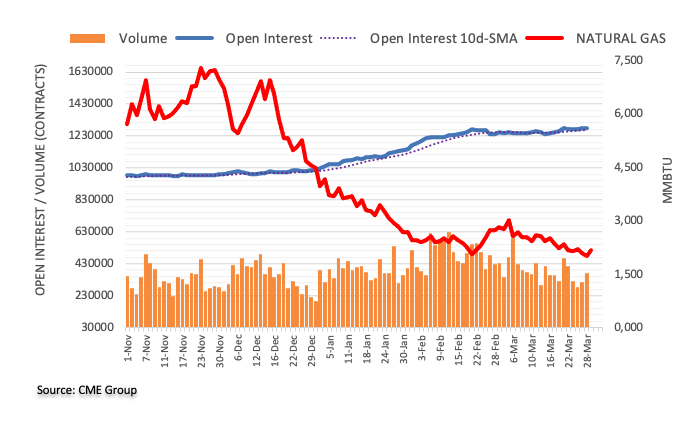
Economist Lee Sue Ann and Markets Strategist Quek Ser Leang at UOB Group still expect AUD/USD to navigate between 0.6565 and 0.6760 in the near term.
Key Quotes
24-hour view: “While we expected AUD to strengthen yesterday, we were of the view that ‘it is unlikely to break 0.6695’. The anticipated AUD strength exceeded our expectations as AUD rose to a high of 0.6710. Strong upward momentum is likely to lead to further AUD strength but overbought conditions suggest it is unlikely to break the major resistance at 0.6760 (there is a minor resistance at 0.6730). Support is at 0.6685; a break of 0.6670 would indicate that AUD is not advancing further.”
Next 1-3 weeks: “On Monday (27 Mar, spot at 0.6645) we highlighted, that for the time being, AUD is likely to trade between the two major levels of 0.6565 and 0.6760. We continue to hold the same view. Looking ahead, if AUD were to break and stay above 0.6760, it would suggest AUD could continue to rise in the days ahead.”
Norges Bank’s policy rate will depend a lot on the Krone’s development over the coming weeks and months. Antje Praefcke, FX Analyst at Commerzbank, expects NOK to gain some ground against the EUR.
Norges Bank will do more in case of a weak Krone
“If the Krone were to develop weaker than expected, the key rate might have to be hiked even more, according to Norges Bank. If, on the other hand, inflation falls faster or unemployment rises more than projected, the policy rate may be lower than projected.”
“As Norges Bank signalled further rate hikes if NOK were to remain weak, to my mind the logical consequence is that it should not depreciate further.”
“Principally I am of the view that NOK is trading at overly weak levels anyway. As a result, and in particular as there is the prospect of the rate differential to the Eurozone narrowing further, NOK should appreciate moderately against the Euro.”
Open interest in crude oil futures markets shrank for the second session in a row on Tuesday, now by around 11.5K contracts according to preliminary readings from CME Group. In the same line, volume went down for the second straight day, this time by nearly 69K contracts.
WTI faces the next hurdle at the 55-day SMA
Prices of the WTI extended the weekly leg higher on Tuesday and close above the $73.00 mark per barrel. The positive price action, however, was in tandem with declining open interest and volume and signals that the current bull run could struggle to advance further in the very near term at least. On the upside, the 55-day SMA near $76.20 should offer initial resistance.
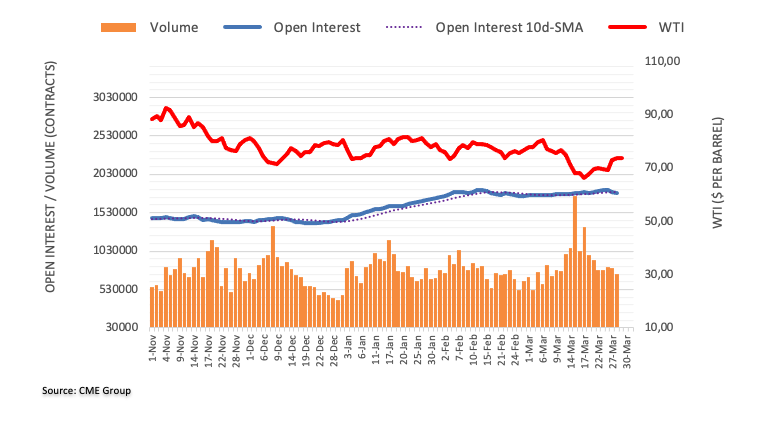
Yesterday, the Hungarian Forint rallied noticeably after the central bank kept all policy parameters on hold. Economists at ING expect the EUR/HUF pair to ove below the 380 level for the rest of the week.
NBH will remain cautious, patient and disciplined
“The most important takeaway from this month's rate-setting meeting is that the NBH will remain cautious, patient and disciplined.”
“The NBH has made it clear that priced-in rate cuts are not on the table at the moment, which should keep FX carry by far the highest in the region. This was the main reason why the Forint was one of the most popular macro trades within the EM space during January and February.”
“We believe that current market conditions along with the hawkish NBH are enticing investors to return to Hungary and the HUF has further room to rally. As such, we expect the Forint to settle below 380 EUR/HUF for the rest of the week.”
- A combination of factors prompts fresh selling around AUD/USD on Wednesday.
- The softer Australian CPI reaffirms bets that the RBA will pause its rate-hike cycle.
- A goodish pickup in the USD demand further contributes to the intraday downfall.
The AUD/USD pair struggles to capitalize on the previous day's positive move and comes under some renewed selling pressure on Wednesday. The steady intraday descent extends through the early European session and drags spot prices to a fresh daily low, around the 0.6675-0.6670 region in the last hour.
The Australian Dollar weakens in reaction to the softer-than-expected domestic consumer inflation figures for February, which reaffirms bets that the Reserve Bank of Australia (RBA) will refrain from raising interest rates at its April meeting. In fact, the Australian Bureau of Statistics (ABS) reported that the headline CPI decelerated from the previous month’s reading of 7.4% to the 6.8% yearly rate, or an eight-month low in February. Apart from this, the emergence of some US Dollar (USD) buying is seen exerting downward pressure on the AUD/USD pair.
The recent rally in the US Treasury bond yields, bolstered by easing fears of a full-blown banking crisis, assists the USD to snap a two-day losing streak. That said, the Federal Reserve's less hawkish stance, along with the prevalent risk-off environment, could cap gains for the safe-haven buck and lend support to the AUD/USD pair. It is worth recalling that the Fed last week signalled that a pause to interest rate hikes was on the horizon. Furthermore, the takeover of Silicon Valley Bank by First Citizens Bank & Trust Company helped calm market nerves about the contagion risk.
The aforementioned mixed fundamental backdrop warrants some caution before placing aggressive bearish bets around the AUD/USD pair and positioning for any further depreciating move. Traders now look to the US economic docket, featuring the release of Pending Home Sales. This, along with the US bond yields and the broader risk sentiment, might influence the USD and provide some impetus to the AUD/USD pair. The focus, however, will remain on the final US Q4 GDP on Thursday and the Core PCE Price Index - the Fed's preferred inflation gauge - on Friday.
Technical levels to watch
Here is what you need to know on Wednesday, March 29:
Risk flows continue to drive the action in financial markets mid-week with US stock index futures trading decisively higher in the European morning. Following a two-day slide, the US Dollar Index clings to modest recovery gains and the 10-year US T-bond yield continues to fluctuate above 3.5%. The US economic docket will feature Pending Home Sales in the American session.
Wall Street's main indexes traded mixed on Tuesday as the sharp decline seen in the technology stocks offset the upbeat performance of energy stocks. In the absence of high-impact macroeconomic data releases, market participants are likely to continue to pay close attention to risk perception. Earlier in the day, major equity indices in Asian rose sharply on news that e-commerce giant Alibaba Group Holdings was planning to split its business into six units and have them list publicly. At the time of press, Hong Kong's Hang Seng Index was on track to end the day with a gain of nearly 2%.
On a negative note, China's Taiwan Affairs Office threatened retaliation over Taiwan President Tsai Ing-wen's visit to the US on Wednesday. This headline, however, doesn't seem to be having an impact on risk sentiment.
During the Asian trading hours, the data from Australia revealed that the Monthly Consumer Price Index (CPI) declined to 6.8% on a yearly basis in February from 7.4% in January. This reading came in below the market expectation of 7.1% and revived expectations for the Reserve Bank of Australia (RBA) to pause its tightening cycle at next week's policy meeting. In turn, AUD/USD turned south and was last seen losing 0.5% on the day at 0.6675.
EUR/USD stages a technical correction early Wednesday but holds comfortably above 1.0800. The Gfk Consumer Confidence Index in Germany declined to -29.5 for April from -30.6 but this reading failed to trigger a noticeable market reaction.
GBP/USD registered strong gains for the second straight day on Tuesday before going into a consolidation phase slightly above 1.2300 on Wednesday. The Bank of England's Financial Policy Committee will release its quarterly report later in the session.
USD/JPY gathered bullish momentum and advanced toward 132.00 early Wednesday. Bank of Japan (BoJ) Governor Haruhiko Kuroda said on Wednesday, that Japan is "closer than before to sustainably hit the 2% inflation target."
Following Tuesday's rebound, Gold price lost its traction and declined to the $1,960 area on Wednesday. Easing fears over a global financial crisis and recovering yields make it difficult for XAU/USD to keep its footing.
Bitcoin regained its traction early Wednesday and was last seen rising nearly 3% slightly above $28,000. Ethereum rose more than 3% on Tuesday and continued to push higher on Wednesday. ETH/USD was last seen gaining 2% on the day at $1,810.
In the view of Economist Lee Sue Ann and Markets Strategist Quek Ser Leang at UOB Group, GBP/USD could see its gains accelerated on a close above 1.2400.
Key Quotes
24-hour view: “Our view for GBP yesterday was that it ‘is likely to test the major resistance at 1.2340 but it is unlikely to maintain a foothold above this level’. Our view was not wrong even though GBP strengthened more than expected, rising to 1.2348 before settling on a firm note at 1.2341 (+0.44%). Despite the advance, there is no significant improvement in upward momentum. However, there is room for GBP to rise to 1.2370 before the risk of a pullback increases. The next resistance at 1.2400 is unlikely to come into view. On the downside, a breach of 1.2290 (minor support is at 1.2310) would indicate that GBP is not advancing further.”
Next 1-3 weeks: “Two days ago (27 Mar, spot at 1.2240), we held the view that the recent GBP strength has ended and we expected GBP to trade in a range of 1.2140/1.2340. Yesterday, GBP rose slightly above the top of the expected range (high of 1.2348). Upward momentum appears to be building, albeit tentatively. In order for GBP to advance in a sustained manner, it has to break and stay above 1.2400. The likelihood of a clear break of 1.2400 is not high for now but it will remain intact as long as GBP stays above 1.2240 in the next few days. Looking ahead, the next resistance above 1.2400 is a solid level at 1.2450.
Analysts at Goldman Sachs have changed their call on the Pound Sterling from bearish to bullish, now targeting EUR/GBP at 0.8800 and GBP/USD at 1.1900 in the next six months.
Key quotes
"We no longer look for idiosyncratic GBP weakness, as investor sentiment on the fiscal side has improved meaningfully, and are updating both our 6- and 12-month EUR/GBP forecasts to 0.88 (from 0.89 and 0.90 previously) but keep our 3-month forecast unchanged at 0.89 because BoE dovishness could continue for a bit longer.”
"We would consider turning even more positive on GBP if we became confident in a revised approach from the BoE."
The Czech National Bank (CNB) is expected to leave rates unchanged in its meeting today. Willingness to hike rates in the future should support Koruna in the coming month, economists at Commerzbank report.
CNB on hold
“We do not expect the bank’s board to use any dovish arguments whatsoever today; rather, we expect it to reiterate that rates need to be kept high for some time longer.”
“Hawks will repeat their argument for one more rate hike – while, an actual rate hike is unlikely in this cycle, the sum total of such signals will convey the message that this central bank stands ready and willing to change its (pause) stance and return to hiking rates if the exchange rate were to need defending. And, this message should support the Koruna through the coming month.”
Australian Consumer Price Index (CPI) fell short of market expectations with headline inflation falling from 7.4% year-on-year in January to 6.8% in February. This will further support a hike at next month's RBA meeting, economists at ANZ Bank report.
RBA to hike in April; Inflation momentum remains strong
“Annual inflation fell to 6.8% YoY in February, down from the peak 8.4% YoY in December, providing further confirmation that we passed peak inflation in Q4.”
“Australia’s monthly CPI indicator showed inflation momentum remains strong and is not slowing as much as the fall in annual inflation would suggest. Along with previous data releases, this makes us comfortable with our call that the RBA will raise the cash rate 25 bps at its April meeting.”
“While the RBA has signalled its intention to pause at some point in coming months, we continue to think that the data is not yet consistent with a pause.”
- Gold price takes offers to reverse the previous day’s corrective bounce off one-week low.
- Geopolitical challenges to sentiment, mixed US data joins month-end positioning to recall US Dollar buyers.
- XAU/USD’s U-turn from previous support, failure to cross SMA confluence keeps bears hopeful.
- Headlines surrounding inflation, banking become necessary for fresh impetus on Gold price.
Gold price (XAU/USD) renews its intraday low around $1,960 as it reverses the previous day’s corrective bounce amid early Wednesday in Europe.
The precious metal’s latest losses could be linked to the US Dollar’s rebound amid fresh challenges to the risk appetite emanating from China. However, a sluggish trading session and a light calendar prod the Gold bears of late.
The US blacklisting of Chinese companies and Beijing’s dislike of a meeting between the White House Speak and the Taiwan President can be considered the key catalysts to challenge the previously firmer sentiment and allow the US Dollar to snap a two-day downtrend. Adding strength to the greenback are the two-week high US inflation expectations, per the 10-year and 5-year breakeven inflation rates from the St. Louis Federal Reserve (FRED).
On the contrary, a successful divergence of the markets from the banking fallouts, policymakers’ efforts to defend their respective banking system and the central banks’ confirmations that the financial crisis is off the table seems to keep the traders optimistic.
It’s worth observing, however, that the inflation woes highlight the upcoming price pressure data from Europe and the US as this week’s key catalysts for the XAU/USD.
While portraying the mood, the S&P 500 Futures rise half a percent to 4,010 as it prints the first daily gains in three whereas the US 10-year and two-year Treasury bond yields print a three-day uptrend around 3.58% and 4.10% respectively.
To sum up, a light calendar on Wednesday may allow the Gold price to justify the downbeat technical signals and please sellers. Though, headlines about inflation and banking will be crucial to watch for clear directions.
Technical analysis
Gold price extends the previous day’s U-turn from a two-week-long support-turned-resistance, around $1,981 by the press time, to slip beneath a convergence of the 21-SMA and 50-SMA.
Not only the failure to cross the key hurdles but the previous reversals from $2,005 and steady RSI (14) also keep Gold bears hopeful.
That said, the recent low of around $1,945 can act as immediate support for the XAU/USD bears to prod before jostling with the key horizontal line surrounding $1,930.
Alternatively, the aforementioned SMA confluence of around $1,970 guards the Gold price recovery ahead of the previous support line close to $1,981.
It’s worth noting that the Gold buyers should remain cautious unless the quote stays beneath a two-week-old horizontal hurdle of near $2,005.
Overall, the Gold price remains well-set for further downside but there prevails a limited room towards the south.
Gold price: Four-hour chart
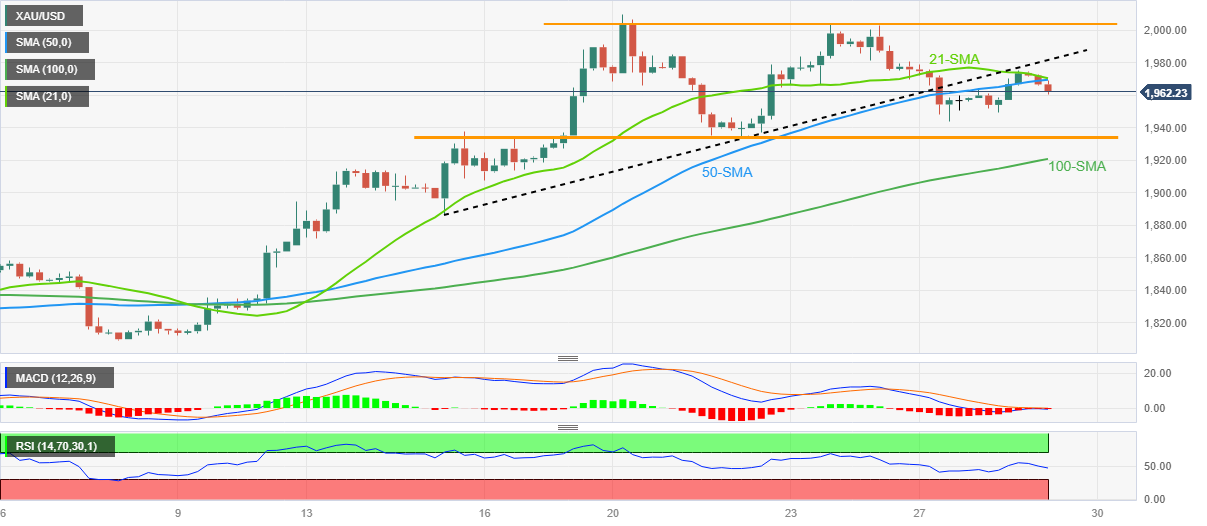
Trend: Limited downside expected
Economists at ABN Amro have adjusted their forecasts in EUR/USD following changes in the Fed view and ECB view.
Year-end 2024 forecast kept at at 1.16
“As we pushed out most of the Fed rate cuts to 2024, we think there is less upside in EUR/USD in the near-term. Therefore, we lower our EUR/USD forecast for the end of 2023 to 1.10 from 1.12.”
“We keep year-end 2024 forecast of EUR/USD at 1.16 though, because of the larger amount of rate cuts we expect for the Fed compared to the ECB in 2024.”
- EUR/USD takes offers to refresh intraday low, prints the first daily loss in three.
- Euro pair’s decline below 61.8% Fibonacci retracement joins looming bear cross on MACD to tease sellers.
- 21-SMA joins two-month-old horizontal support, ascending trend line from mid-March to highlight 1.0800 level as the key for bears.
- Buyers have a bumpy road to tackle before crossing 1.0940.
EUR/USD drops to 1.0830 as it welcomes intraday sellers during the initial hour of Wednesday’s European session. In doing so, the Euro pair prints the first daily loss in three.
The major currency pair’s latest weakness drags it back below the 61.8% Fibonacci retracement level of its February-March downside, following a brief run-up, which in turn teases sellers. Adding strength to the downside bias is the looming bear cross on the MACD indicator.
It should be noted, however, that a convergence of the 21-SMA, horizontal line from late January and a two-week-old ascending trend line together highlight the 1.0800 as a tough nut to crack for the EUR/USD bears.
In a case where the Euro pair drops below 1.0800, the mid-month top around 1.0760 and the last Friday’s high near 1.0715 could lure the bears.
Alternatively, a clear upside break of the recent top surrounding 1.0850 becomes necessary for the EUR/USD buyers to return to the table.
However, a seven-week-long broad resistance area between 1.0930 and 1.0940 can challenge the Euro pair’s further advances, a break of which could quickly propel the pair toward the Year-To-Date (YTD) high marked in January around 1.1033.
EUR/USD: Four-hour chart
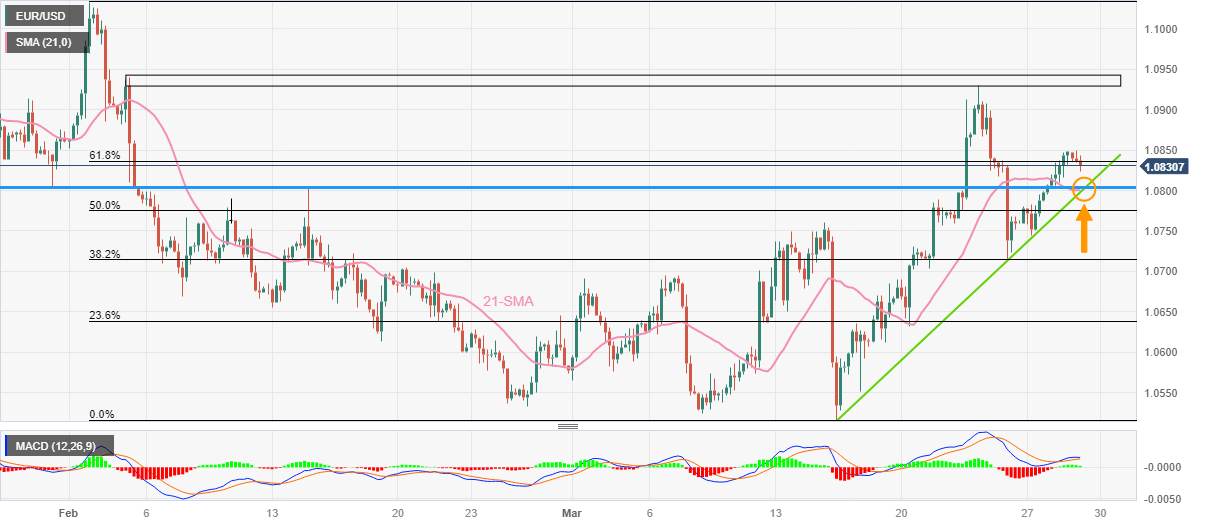
Trend: Further downside expected
FX option expiries for Mar 29 NY cut at 10:00 Eastern Time, via DTCC, can be found below.
- EUR/USD: EUR amounts
- 1.0685 1.0b
- 1.0700 2.5b
- 1.0850 549m
- 1.1000 1.3b
- USD/JPY: USD amounts
- 128.00 585m
- 130.75 630m
- 131.60 1.0b
- AUD/USD: AUD amounts
- 0.6650 681m
- 0.6800 566m
- USD/JPY is marching towards 132.00 as easing US banking jitters have trimmed the appeal for the Japanese Yen as a safe-haven.
- Ex-BoJ Kuroda has reiterated the need for the continuation of expansionary monetary policy.
- Monthly core PCE would accelerate by 0.4%, lower than the former expansion of 0.6%.
The USD/JPY pair is hovering near its weekly high at 131.75 in the early European session. The asset is expected to extend its upside journey towards 132.00 amid renewed fears of the continuation of ultra-loose monetary policy by the Bank of Japan (BoJ).
For the past few months, the Japanese Yen was attracting bullish bets on hopes that the BoJ will exit from its decade-long expansionary policy after the arrival of novel BoJ leadership. However, an absence of hawkish commentary from BoJ Governor Kazuo Ueda after holding the highest chair in the central bank has faded expectations of a shift in the policy stance.
Meanwhile, ultra-dovish commentary from ex-BoJ Governor Haruhiko Kuroda has added fuel to fire. Ex-BoJ Kuroda cited “It is premature to debate an exit from easy monetary policy.” And, “More time is needed to stably and sustainably hit the price target.” The requirement of a dovish policy looks likely as the sustained inflation target has not been met yet.
Apart from that, receding fears of a potential United States banking crisis have faded the appeal for the Japanese Yen as a safe-haven. US authorities are making efforts in infusing confidence among households and investors that their deposits are safe.
Also, the US Dollar Index (DXY) has shown some recovery after correcting to near 102.40 as investors are expecting that fading fears of US banking shakedown could propel chances of one more rate hike by the Federal Reserve (Fed).
This week, the US core Personal Consumption Expenditures (PCE) Price Index data will remain in focus. As per the consensus, monthly core PCE would accelerate by 0.4%, lower than the former expansion of 0.6%. And, the annual figure is expected to remain steady at 4.7%.
- Natural fades the previous day’s corrective bounce off five-week low.
- Sustained trading below two-week-old descending trend line favors bears.
- Yearly low, early July 2020 top can prod XNG/USD bears before directing them to 61.8% Fibonacci Expansion.
- Bulls need validation from a downward-sloping resistance line from late December 2022.
Natural Gas (XNG/USD) holds lower ground near $2.20 as bears poke the Year-To-Date (YTD) low marked in February. In doing so, the energy quote remains sluggish after declining in the last two consecutive days.
The XNG/USD bears cheer the sustained trading below a fortnight-long descending resistance line, around $2.27 by the press time, amid bearish MACD signals and an absence of oversold RSI (14).
As a result, the Natural Gas price appears well-set to slip beneath the yearly low of $2.13, which in turn highlights the $2.00 psychological magnet.
However, the early July 2020 high surrounding $1.97 and the 61.8% Fibonacci Expansion (FE) of its moves during early January-March 2023, around $1.80, could challenge the Natural Gas bears afterward, amid a likely oversold RSI line around then.
On the contrary, an upside break of the stated immediate resistance line, close to $2.27, isn’t an open invitation to the Natural Gas buyers as another downward-sloping trend line from the year’s start, near $2.40 at the latest, acts as an additional check for the XNG/USD bulls.
Should the quote manages to remain firmer past $2.40, the odds of witnessing a rally toward the mid-March high of $2.75 can’t be ruled out.
Natural Gas Price: Daily chart
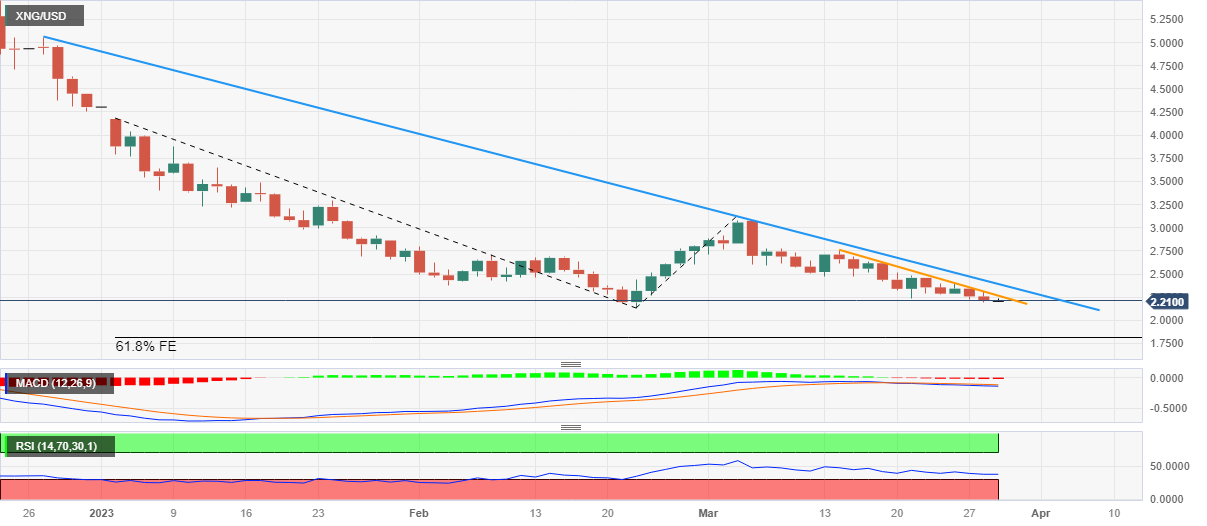
Trend: Further downside expected
Gold price recaptured the 23.6% Fibonacci Retracement (Fibo) level of the March advance, pegged at $1,963, on a daily closing basis on Tuesday. Holding above here is critical to see further gains, FXStreet’s Dhwani Mehta reports.
Awaiting a fresh catalyst
“Gold bulls have paused for a cause, awaiting a fresh catalyst to resume its upside, as the 14-day Relative Strength Index (RSI) is holding comfortably above the midline.”
“If the 23.6% Fibo resistance-turned-support holds the fort, Gold price could turn higher to challenge Monday’s high at $1,981. The next significant resistance for Gold buyers is seen at the $2,000 mark.”
“Alternatively, a breach of the abovementioned Fibo support will recall Gold sellers for a test of the $1,950 psychological level. Further south, $1,934, which is the 38.2% Fibo level of the same ascent, will challenge bullish commitments.”
- The index advances slightly around the 102.50/60 band.
- US yields trade without clear direction so far on Wednesday.
- Weekly Mortgage Applications, Pending Home Sales next on tap.
The greenback, in terms of the USD Index (DXY), regains some composure and revisits the 102.50/60 area on Wednesday.
USD Index looks at risk trends, banking sector
The current bullish attempt comes after two consecutive daily declines and on the back of the tepid knee-jerk in the risk complex as well as the lack of direction surrounding US yields.
In the meantime, banking concerns appear far from abated and somewhat underpin the better tone in the dollar via a firmer demand for the safe haven universe.
On the negative side for the buck, the likelihood that the Federal Reserve might pause its tightening stance at the May gathering continues to weigh on the currency, at the time when the probability of this scenario hovers around 60% according to CME Group’s FedWatch Tool.
In the US data space, weekly MBA Mortgage Applications are due seconded by Pending Home Sales and the weekly report on US crude oil inventories by the EIA.
What to look for around USD
The index picks up some pace and retakes the mid-102.00s amidst some correction in the risk complex on Wednesday.
So far, speculation of a potential Fed’s pivot in the short-term horizon should keep weighing on the dollar, although the still elevated inflation, the resilience of the US economy and the hawkish narrative from Fed speakers are all seen playing against that view for the time being.
Key events in the US this week: MBA Mortgage Applications, Pending Home Sales (Wednesday) – Final Q4 GDP Growth Rate, Initial Jobless Claims (Thursday) – PCE, Personal Income/Spending, Final Michigan Consumer Sentiment (Friday).
Eminent issues on the back boiler: Persistent debate over a soft/hard landing of the US economy. Terminal Interest rate near the peak vs. speculation of rate cuts in 2024. Fed’s pivot. Geopolitical effervescence vs. Russia and China. US-China trade conflict.
USD Index relevant levels
Now, the index is advancing 0.17% at 102.59 and faces the next resistance level at 103.36 (55-day SMA) followed by 104.15 (100-day SMA) and then 105.88 (2023 high March 8). On the other hand, the breach of 101.93 (monthly low March 23) would open the door to 100.82 (2023 low February 2) and finally 100.00 (psychological level).
- USD/CHF grinds higher after posting the biggest daily gains in two weeks.
- US Dollar pares recent losses amid sluggish session amid challenges to risk-on mood, firmer yields.
- Swiss data, SNB Bulletin will be crucial for fresh impetus.
USD/CHF keeps buyers in the driver’s seat during the early Wednesday’s sluggish markets. That said, the Swiss currency pair rose the most in nearly a fortnight the previous day before portraying the latest inaction above 0.9200, up 0.10% near 0.9208 by the press time.
The latest challenges to the previous optimism, mainly from the geopolitical front, join upbeat US Treasury bond yields to help the US Dollar in extending the late Tuesday’s rebound from the weekly low.
Among them, headlines suggesting the US blacklisting of Chinese companies and Beijing’s dislike for a meeting between the White House Speak and Taiwan President. Also testing the risk-on mood could be the two-week high upbeat US inflation expectations, per the 10-year and 5-year breakeven inflation rates from the St. Louis Federal Reserve (FRED).
Even so, the Swiss National Bank’s (SNB) ability to tame the Credit Suisse turmoil, as well as optimism surrounding the Silicon Valley Bank (SVB) deal, keeps the risk profile positive.
It’s worth noting that an absence of major disappointments from the US data also allows the USD/CHF pair to grind higher. On Tuesday, US Conference Board (CB) Consumer Confidence rose to 104.2 in March, versus 101.0 expected and an upwardly revised prior figure of 103.4. Further, US Housing Price Index rose 0.2% MoM in January versus -0.6% expected and -0.1% prior while the S&P/Case-Shiller Home Price Indices matched 2.5% YoY forecasts for the said month compared to 4.5% previous readings.
Amid these plays, US 10-year and two-year Treasury bond yields print a three-day uptrend around 3.58% and 4.10% respectively while the S&P 500 Futures print mild gains, the first in three. Further, the US Dollar Index (DXY) picks up bids to 102.60 while printing the first daily gains in three.
Looking forward, Swiss ZEW Survey details for March can offer immediate directions to the USD/CHF pair ahead of the SNB’s Quarterly Bulletin and the second-tier US data. Given the SNB’s latest defense of the banking sector, the pair traders will seek clues of the Swiss economy’s strength for further directions. Above all, Friday’s US Core Personal Consumption Expenditure (PCE) Price Index for February, the Federal Reserve’s (Fed) favorite inflation gauge, will be crucial for a clear guide.
Technical analysis
A clear upside break of a three-week-long descending trend line, now immediate support near 0.9195, directs USD/CHF buyers towards the 50-DMA hurdle surrounding 0.9255.
- Asian stocks have demonstrated a firmer recovery as US banking jitters have eased further.
- Japanese stocks have rebounded as the BoJ has favored the continuation of easy monetary policy.
- Oil price is struggling in extending its recovery above $74.00 ahead of inventory data.
Markets in the Asian domain have shown a decent recovery as fears of a potential United States banking crisis have receded and escalating chances of a steady monetary policy by the Federal Reserve (Fed). S&P500 futures have generated significant gains in the Asian session after a choppy Tuesday. Ebbing fears of US banking shakedown are infusing confidence among the market participants. It would be worth discovering whether deposits in mid-size US banks by households are reverting or not.
At the press time, Japan’s Nikkei225 jumped 0.71%, ChinaA50 added 0.28%, Hang Seng soared 2.17%, and Nifty50 gained 0.54%.
Japanese stocks have rebounded as the Bank of Japan (BoJ) has favored for the continuation of easy monetary policy to keep inflation steady above desired levels. Ex-Bank of Japan Governor Haruhiko Kuroda remained extremely dovish for further monetary policy as the sustainable inflation target has not been met yet. He further added, “It is premature to debate an exit from easy monetary policy.” And, “More time is needed to stably and sustainably hit the price target.”
Chinese stocks have shown a decent recovery ahead of the PMIs, which will release on Friday. China’s National Bureau of Statistics (NBS) will report Manufacturing and Non-Manufacturing data, which is expected to show a decent performance as the administration is supporting growth with monetary and non-monetary measures. Deputy Director General of China’s National Development and Reform Commission of the People's Republic of China (NDRC) said in a statement on Wednesday, “we are confident about the growth condition for this year.” He further added, “China's potential growth rate is the same as the potential growth rate of the entire world.”
On the oil front, the oil price is struggling in extending its recovery above $74.00. The black gold has turned sideways as investors are awaiting the release of the oil inventory data by US Energy Information Administration (EIA) for the week ending March 24.
Considering advanced prints from CME Group for gold futures markets, open interest shrank for the second session in a row on Tuesday, this time by around 2.3K contracts. Volume followed suit and dropped by around 9.8K contracts, also reaching the second consecutive daily pullback.
Gold: Further downside could retest $1935
Gold prices attempted a moderate rebound on Tuesday. The bullish attempt, however, was on the back of shrinking open interest and volume and leaves the precious metal vulnerable to further losses in the very near term. That said, the next contention area emerges around the $1935 region per ounce troy.
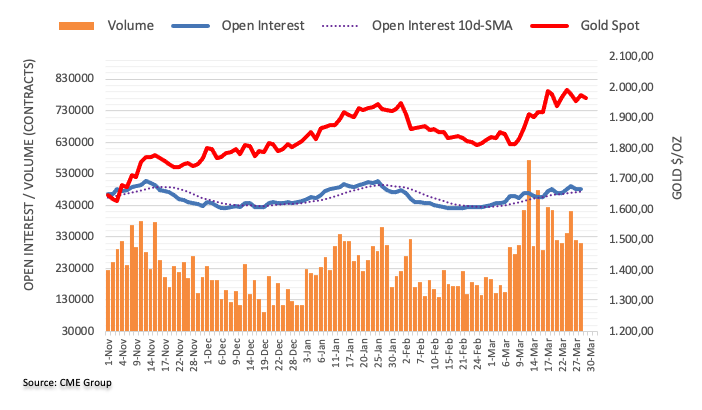
China's Taiwan Affairs Office threatened retaliation over Taiwan President Tsai Ing-wen's visit to the US on Wednesday.
Zhu Fenglian, spokesperson of China's Taiwan Affairs Office said at a news conference, “if she contacts US House Speaker McCarthy, it will be another provocation that seriously violates the one-China principle, harms China's sovereignty and territorial integrity, and destroys peace and stability in the Taiwan Strait. We firmly oppose this and will definitely take measures to resolutely fight back."
In response, Reuters cited senior US officials, as saying that “China shouldn't overreact to Taiwan president's transit.”
Additional comments
“Taiwan president's planned transit is consistent with long-standing US practice.”
“Urgs China to keep open channels of communication.”
“See no reason for Beijing to overreact.
“China's attempts to alter Taiwan's status quo will not pressure the US to change this.”
Market reaction
Amid renewed US-Sino tensions, further recovery in the AUD/USD pair appears elusive, The pair is trading at around 0.6700, down 0.16% on the day.
The high beta currency, AUD/USD, hit daily lows of 0.6688 after the Australian monthly Consumer Price Index (CPI) data disappointed and boosted expectations of a Reserve Bank of Australia (RBA) rate hike pause next Tuesday.
Outgoing Bank of Japan (BoJ) Governor Kuroda said on Wednesday, “Japan is closer than before to sustainably hit the 2% inflation target.”
Kuroda added that “wage pressure is heightening.”
Market reaction
USD/JPY was last seen trading at 131.72, up 0.66% on the day.
EUR/USD is still seen trading within 1.0660 and 1.0870 in the next few weeks, suggest Economist Lee Sue Ann and Markets Strategist Quek Ser Leang at UOB Group.
Key Quotes
24-hour view: “Yesterday, we noted ‘Upward momentum has improved somewhat’ and held the view that ‘while EUR could break above 1.0830; it is unlikely to threaten the next resistance at 1.0870’. Our view turned out to be correct as EUR rose to a 1.0848 before settling near the high at 1.0843 (+0.44%). Upward momentum has improved, albeit not much. Today, EUR could rise above 1.0870 but the chances of it staying above this level are not high. The next resistance is at 1.0900. Support is at 1.0820; a break of 1.0800 would indicate that the current upward pressure has eased.”
Next 1-3 weeks: “Our latest narrative was from two days ago (27 Mar, spot at 1.0775) wherein we were of the view that EUR ‘appears to have entered a consolidation phase and it is likely to trade between 1.0660 and 1.0870 for the time being’. While there is no change in our view, short-term upward momentum is building, albeit tentatively. Looking ahead, EUR has to break and stay above 1.0900 before a sustained advance is likely. The prospect of EUR breaking clearly above 1.0900 is low for now but it would remain intact as long as EUR stays above the ‘strong support’ level of 1.0770 in the next few days.”
- NZD/USD grinds higher at weekly top, extends the previous day’s rebound.
- Upbeat RSI, bullish MACD signals keep buyers hopeful.
- Six-week-old descending resistance line, key DMAs challenge Kiwi pair buyers.
- Downside break of three-week-long ascending support line can recall bears.
NZD/USD prints mild gains around 0.6260 during early Wednesday in Europe as bulls take a breather following the previous day’s run-up, the biggest in over a week. In doing so, the Kiwi pair fades upside momentum below the key resistances while defending a two-day run-up.
That said, the quote’s sustained U-turn from a three-week-old ascending support line joins bullish MACD signals to keep buyers. Adding strength to the upside hopes is the steady RSI (14).
However, the downward-sloping resistance line from mid-February, close to 0.6280 at the latest, restricts the immediate upside of the NZD/USD pair.
Following that, a convergence of the 50-DMA and 100-DMA challenges the Kiwi pair buyers around 0.6285-95.
It’s worth noting that the 0.6300 round figure acts as an extra filter towards the north, a break of which won’t hesitate to challenge the mid-February high surrounding 0.6390.
Meanwhile, pullback moves need validation from the aforementioned immediate support line, close to 0.6195 by the press time.
In a case where NZD/USD remains bearish past 0.6195, multiple lows marked since late November 2022, around 0.6090-80, may gain the market’s attention.
Overall, NZD/USD is likely to remain firmer but the upside momentum remains less convincing below 0.6300.
NZD/USD: Daily chart

Trend: Limited upside expected
- GBP/USD has sensed buying interest near 1.2320 as USD Index has retreated.
- S&P500 futures are continuously adding gains as the appeal for risk-sensitive assets has accelerated.
- UK growth rate is expected to remain stagnant in the fourth quarter.
The GBP/USD pair has shown a recovery move after a gradual correction to near 1.2320 in the Asian session. The Cable is aiming to recapture the immediate resistance of 1.2350 as the US Dollar Index (DXY) has retreated after a rebound to near 102.60. Bearish bets have resumed for the US Dollar Index (DXY) amid easing fears of the United States banking crisis and rising odds of a steady stance on interest rates by the Federal Reserve (Fed) ahead.
The USD Index is expected to revert to its intraday low of 102.40 as the risk appetite of the market participants is improving further. S&P500 futures are continuously adding gains as the appeal for risk-sensitive assets has accelerated. US equities have hogged the limelight as ebbing fears of US banking shakedown are fueling confidence among the market participants.
Meanwhile, the demand for US government bonds has rebounded, which has trimmed the 10-year US Treasury yields to 3.55%.
The Pound Sterling has gained sufficient strength as Bank of England (BoE) Governor Andrew Bailey won’t shy of hiking rates further if there would be evidence of persistent inflation. The street is anticipating that the BoE cannot dodge more rate hikes as the double-digit United Kingdom inflation would not come down easily.
For further guidance, investors will keep an eye on UK Gross Domestic Product (GDP) data, which is scheduled for Friday. As per the consensus, UK’s growth has remained stagnant in the fourth quarter of CY2022. Annual GDP is expected to remain steady at 0.4%. The UK economy is expected to witness a deep recession due to the synergetic effect of stagnant growth and sticky inflation.
- USD/CAD stays defensive after bouncing off three-week low, prods two-day downtrend.
- Recent challenges to market’s optimism join firmer yields to underpin US Dollar rebound.
- WTI crude oil fails to cheer heavy inventory draw at the highest level in fortnight.
- BoC’s Gravelle, second-tier US housing data eyed for fresh impulse.
USD/CAD retreats from intraday high, fading bounce off three-week low, as it traces the early Wednesday’s sluggish markets around 1.3600. In doing so, the Loonie pair also takes clues from the lackluster prices of WTI crude oil, Canada’s main export item. However, the latest challenges to sentiment and the US Dollar’s corrective bounce prods the pair’s two-day downtrend near the multi-day bottom ahead of a speech from Bank of Canada (BoC) Deputy Governor Toni Gravelle.
That said, WTI crude oil seesaws around a two-week high as Oil buyers seek more clues to extend the latest gains, backed by heavy inventory draw and receding fears of the banking crisis. That said, the weekly prints of the American Petroleum Institute’s (API) Crude Oil Stock data marked a surprise daw in inventories by flashing -6.076M figure for the week ended on March 24 versus the previous addition of 3.262M.
On the other hand, US Dollar Index (DXY) picks up bids to 102.60 while printing the first daily gains in three. In doing so, the greenback’s gauge versus the six major currencies traces upbeat US Treasury bond yields amid mixed US data and the market’s indecision.
Talking about the prevailing cautious optimism, the Silicon Valley Bank (SVB) deal and policymakers’ efforts to defend their respective banking system, not to forget the central banks’ confirmations that the financial crisis is off the table, keep the market mildly positive. However, the latest geopolitical fears emanating from China join the upbeat US inflation expectations to trigger the US Dollar’s corrective bounce, due to the greenback’s haven appeal.
It’s worth observing that the recent US blacklisting of Chinese companies and China’s dislike for the meeting of the White House speaker and Taiwan President challenge the sentiment.
Amid these plays, US 10-year and two-year Treasury bond yields print a three-day uptrend around 3.58% and 4.10% respectively while the S&P 500 Futures print mild gains, the first in three.
Looking forward, USD/CAD traders should pay attention to risk catalysts, as well as a speech from BoC’s Gravelle for clear directions. However, major attention will be given to the US inflation data, up for release on Friday.
Technical analysis
50-day Exponential Moving Average (EMA) probes the Loonie pair’s two-day downtrend near 1.3590 at the latest. However, the Loonie pair’s failure to cross the key horizontal resistance surrounding 1.3845-65, established since September 2022, joins the bearish MACD signals and downbeat RSI (14), not oversold, to keep the Loonie pair sellers hopeful.
- Gold price is declining towards $1960.00 as investors are getting anxious ahead of US PCE inflation data.
- The reputation of Gold as a safe-haven amid US banking jitters has ebbed.
- On a broader note, Gold price is auctioning in a Symmetrical Triangle chart pattern.
Gold price (XAU/USD) has dropped after failing to sustain above $1,970.00 in the Asian session. The precious metal has lost its appeal as fears of the United States banking crisis have receded significantly. The Gold price is expected to extend its correction further as the US Dollar Index (DXY) has shown a recovery move.
The USD Index has rebounded after building an intermediate cushion around 102.40. The USD Index has extended its recovery to near 102.60 as investors are shifting their focus to core Personal Consumption Expenditure (PCE) Price Index data, which is scheduled for Friday.
Federal Reserve’s (Fed) preferred inflation gauge is expected to accelerate by 0.4%, lower than the former expansion of 0.6%. The annual figure is expected to remain steady at 4.7%. A deceleration in the pace of consumer spending on core goods will further ease the chances of one more rate hike by the Fed. Chances are favoring a decline in consumer spending as labor cost index remained lower than anticipated. Also, US banks have tightened credit conditions for households and businesses after the collapse of three mid-size banks.
Meanwhile, S&P500 futures have generated firmer gains in the Asian session after a rangebound auction on Tuesday. US equities have been underpinned on hopes that the Federal Reserve (Fed) will keep rates steady ahead.
Gold technical analysis
Gold price has dropped after a pullback move to near the prior order block region placed in a range of $1,968-1,980 on an hourly scale. On a broader note, the precious metal is auctioning in a Symmetrical Triangle chart pattern. The Gold price is struggling in holding its auction above the 20-period Exponential Moving Average (EMA) at $1,968.00.
Meanwhile, the Relative Strength Index (RSI) (14) has failed in sustaining inside the bullish range of 60.00-80.00.
Gold hourly chart
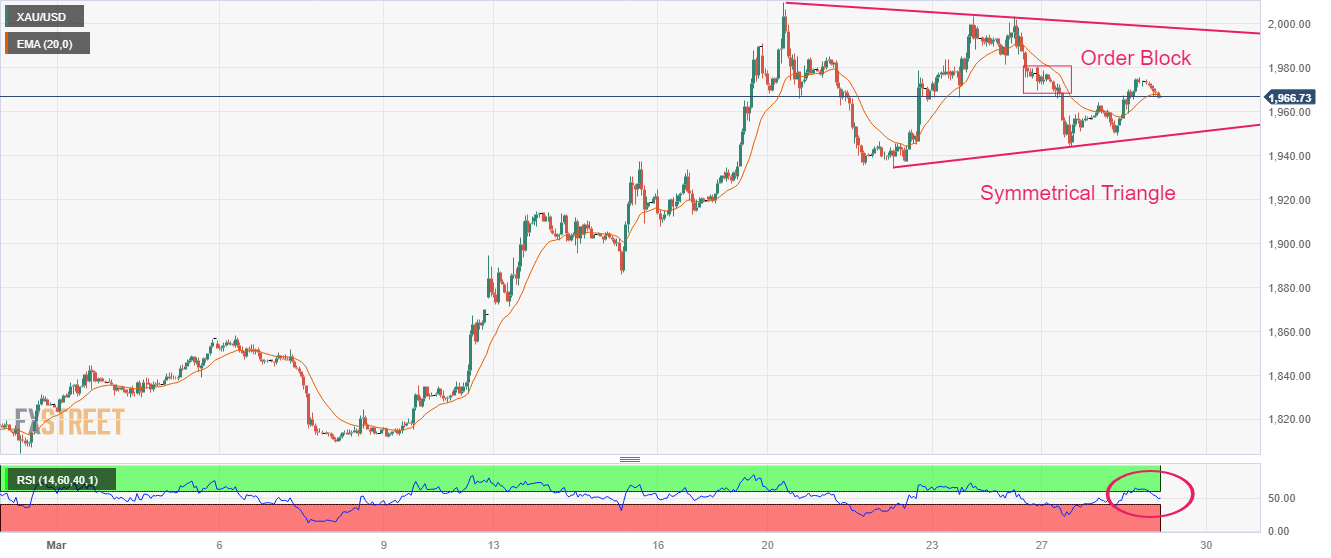
- USD/INR extends bounce off three-week-old support line towards short-term key resistance.
- 200-SMA, fortnight-long descending trend line challenges Indian Rupee bears.
- Steady RSI suggests further grinding of prices inside triangle formation.
USD/INR picks up bids to pare weekly losses around 82.30 as it snaps a two-day downtrend amid early Wednesday. In doing so, the Indian Rupee pair rebounds from an ascending support line from March 06, and stays within the short-term symmetrical triangle.
It’s worth noting, however, that the steady RSI (14) line hints at the USD/INR pair’s further dribbling inside the stated triangle, currently between 82.15 and 82.50.
That said, the 200-SMA adds strength to the triangle’s top line surrounding 82.50, making it a tough nut to crack for the USD/INR bulls.
In a case where USD/INR price rallies beyond 82.50, a one-month-old descending resistance line near 82.85 can challenge the pair buyers before directing them to the multiple resistance area surrounding the 83.00 psychological magnet.
On the flip side, a clear break of the 82.15 level can quickly drag the USD/INR bears towards the 61.8% Fibonacci retracement level of the pair’s late January-February upside, near 81.70.
During the fall, the 82.00 round figure may act as an intermediate halt while the monthly low of near 81.50 acts as an extra filter towards the south.
Overall, USD/INR is likely to remain sidelined but the multiple hurdles toward the north keep the pair sellers hopeful.
USD/INR: Four-hour chart
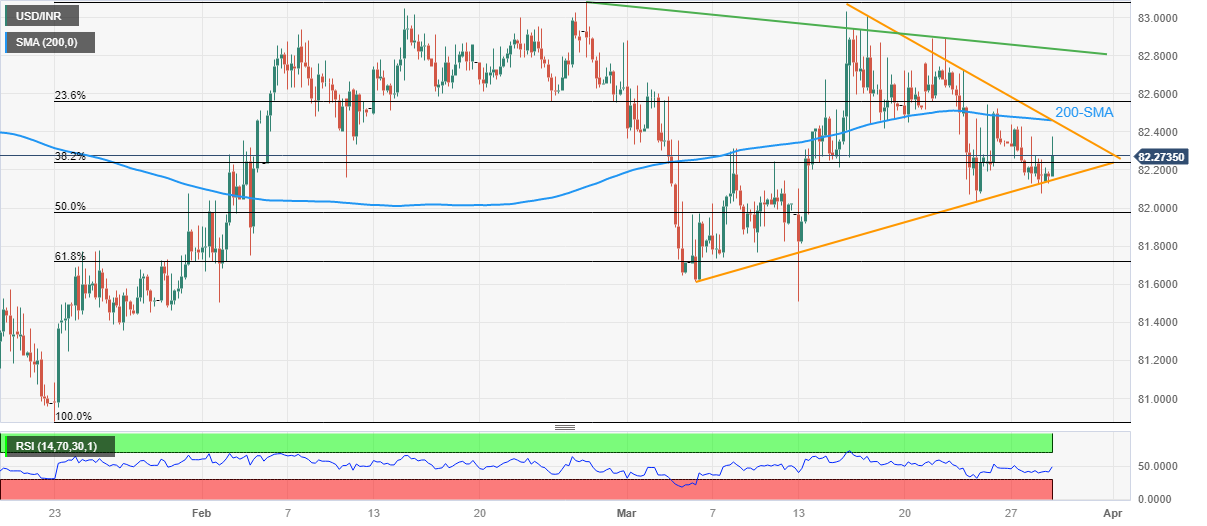
Trend: Limited upside expected
- AUD/USD has shifted its business below 0.6700 after the Australian CPI softens consecutively.
- Subdued retail demand weighed heavily on Australian inflation.
- The 20-period EMA at 0.6686 is acting as a cushion for the Australian Dollar.
The AUD/USD pair is displaying topsy-turvy moves below the round-level resistance of 0.6700 in the Asian session. The Aussie asset has turned rangebound after a vertical downside move post-softening of the Australian Consumer Price Index (CPI).
Monthly Australian inflation (Fed) softened further to 6.9% from the prior release of 7.4% as households’ spending has trimmed dramatically. Households are struggling in bearing the burden of inflated goods and services with their nominal growth in earnings. This has bolstered the intention of pausing the policy-tightening spell by the Reserve Bank of Australia (RBA) from its April meeting.
Meanwhile, the US Dollar Index (DXY) has shown a firmer recovery from 102.40. The recovery move by the USD Index has escalated to 102.60.
On a two-hour scale, AUD/USD has shown a decent upside after sensing strength near the upward-sloping trendline of the Symmetrical Triangle chart pattern, which is placed from March 10 low at 0.6564. The downward-sloping trendline of the chart pattern is plotted from March 01 high at 0.6784.
The 20-period Exponential Moving Average (EMA) at 0.6686 is acting as a cushion for the Australian Dollar.
In addition to that, the Relative Strength Index (RSI) (14) is making efforts in keeping itself in the bullish range of 60.00-80.00, which will keep the Australian Dollar in the grip of bulls.
Should the asset breaks above March 13 high at 0.6717, Aussie bulls would drive the asset further toward March 07 high at 0.67478 followed by the horizontal resistance plotted from February 23 low at 0.6781.
On the contrary, a slippage below March 15 low at 0.6564 will drag the asset toward October 4 high at 0.6547 and the round-level support at 0.6500.
AUD/USD two-hour chart

- EUR/USD retreats from weekly top, prints mild losses while snapping two-day uptrend.
- Mixed sentiment, month-end positioning allow US Dollar to lick its wounds amid firmer US Treasury bond yields.
- Comparatively more hawkish ECB talks than the Fed counterpart keep buyers hopeful unless German, European HICP disappoints.
EUR/USD witnesses headwinds at the weekly top as Euro traders remain cautious ahead of the key German clues. Adding strength to the pullback moves could be firmer yields and a rebound in US Dollar amid mixed sentiment. That said, the Euro pair eases to 1.0835, printing mild losses during early Wednesday, as it snaps a two-day winning streak.
US Dollar Index (DXY) picks up bids to 102.60 while printing the first daily gains in three. In doing so, the greenback’s gauge versus the six major currencies traces upbeat US Treasury bond yields amid mixed US data and the market’s indecision.
It’s worth noting that the Silicon Valley Bank (SVB) deal and policymakers’ efforts to defend their respective banking system, not to forget the central banks’ confirmations that the financial crisis is off the table, keep the market cautiously optimistic. However, the latest geopolitical fears emanating from China, mainly due to the US blacklisting some more Chinese companies, join the upbeat US inflation expectations to weigh on the EUR/USD price.
On the same line was the news that French authorities raided five banks on tax avoidance and money laundering concerns, as well as the talks surrounding the $5.4 million Credit Default Swap (CDS) trade of Deutsche Bank.
Talking about the data, US Conference Board (CB) Consumer Confidence rose to 104.2 in March, versus 101.0 expected and an upwardly revised prior figure of 103.4. Further, US Housing Price Index rose 0.2% MoM in January versus -0.6% expected and -0.1% prior while the S&P/Case-Shiller Home Price Indices matched 2.5% YoY forecasts for the said month compared to 4.5% previous readings.
Against this backdrop, US 10-year and two-year Treasury bond yields print a three-day uptrend around 3.58% and 4.10% respectively while the S&P 500 Futures print mild gains, the first in three.
Looking ahead, EUR/USD may witness further pullback amid fresh challenges to sentiment and upbeat US inflation expectations, per the 10-year and 5-year breakeven inflation rates from the St. Louis Federal Reserve (FRED).
However, the European Central Bank (ECB) officials have been more hawkish than their Federal Reserve (Fed) counterparts and hence firmer prints of inflation data can allow the EUR/USD buyers to return to the table. On Tuesday, ECB policymaker Madis Muller said that “although inflation is decreasing, it is still too soon to declare success.” On the same line were comments from Andrea Enria, Chair of the Supervisory Board of the European Central Bank (ECB), who said on Tuesday that direct exposure to Credit Suisse is relevant but manageable.
Moving on, Germany’s GfK Consumer Confidence Survey for April will be crucial for providing initial signals for Thursday’s inflation numbers. Following that, second-tier statistics from the US will be important to watch for clear directions.
Technical analysis
Although a two-month-old horizontal resistance challenges EUR/USD buyers around 1.0930, the 10-DMA level surrounding 1.0770 puts a short-term floor under the Euro pair.
- Silver price struggles to extend two-week uptrend, seesaws around intraday low of late.
- Failure to cross previous support line joins RSI retreat to lure XAG/USD sellers.
- 61.8% Fibonacci retracement, 50-SMA restrict short-term downside of the Silver price.
- XAG/USD bulls need to refresh monthly high to keep the driver’s seat.
Silver price (XAG/USD) prints 0.35% intraday losses around $23.25 as bulls run out of steam during early Wednesday, after posting positive closings in the last two consecutive weeks.
The bright metal’s latest retreat could be linked to the failure of crossing the previous support line from March 16, now immediate resistance near $23.45. Also challenging the Silver buyers is the latest U-turn in the RSI (14), as well as the lower high formation of the oscillator’s line.
As a result, the XAG/USD sellers may again try to break the 61.8% Fibonacci retracement level of the metal’s February-March fall, also known as the golden Fibonacci ratio, around $22.80.
It’s worth noting that the 50-SMA, around $22.75 by press time, also acts as a short-term downside filter.
Should the XAG/USD breaks the stated SMA support, the odds of witnessing a slump toward the 200-SMA support near $21.60 can’t be ruled out.
However, the 50% Fibonacci retracement, close to $22.30, may act as an intermediate halt during the fall.
On the flip side, a clear break of the stated support-turned-resistance, near $23.45, isn’t an open welcome to the Silver buyers as the previous tops surrounding $23.55 could check the upside momentum.
Following that, a run-up towards $24.00 and then to February’s high near $24.65 can’t be ruled out.
Silver price: Four-hour chart
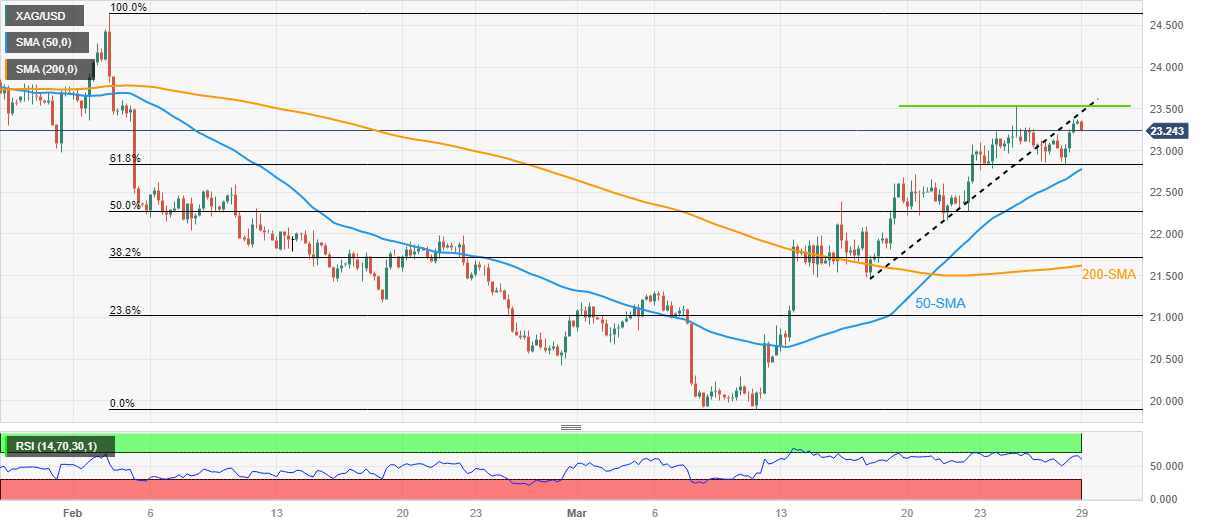
Trend: Pullback expected
- USD/MXN dribbles around three-week low as bears take a breather during five-day downtrend.
- US Dollar bears the burden of risk-on mood, mixed data.
- Hawkish hopes from Banxico contrast with the Fed policy pivot talks to weigh on Mexican Peso pair.
USD/MXN holds lower grounds near 18.22 as sellers flirt with the lowest levels in three weeks during early Wednesday. In doing so, the Mexican Peso pair drops for the fifth consecutive day.
The quote’s latest weakness could be linked to the market’s cautious optimism surrounding the health of the global banking system, as well as the likely easing in recession woes in some of the developed nations due to the double-barrel attack of COVID-19 and geopolitics. However, a comparatively less hawkish bias for the US Federal Reserve (Fed) than the Banxico appears the key catalyst for the USD/MXN pair’s south-run.
Be it the Silicon Valley Bank (SVB) deal or the European and the US policymakers’ readiness to defend their respective banking system, not to forget bold efforts by the major central banks to infuse US Dollar-linked liquidity in the market, the traders seem to cheer them all of late. However, a lack of major catalysts allows them to take a breather.
On the same line could be the mixed US data as the Conference Board (CB) Consumer Confidence rose to 104.2 in March, versus 101.0 expected and an upwardly revised prior figure of 103.4. Further, US Housing Price Index rose 0.2% MoM in January versus -0.6% expected and -0.1% prior while the S&P/Case-Shiller Home Price Indices matched 2.5% YoY forecasts for the said month compared to 4.5% previous readings.
On the contrary, Mexican Trade Balance marked a wider deficit in February, to $1.844B versus the $0.9B expected.
It should be noted that the news that Australian Treasurer Jim Chalmers will convene a meeting of the country's top financial regulators to check how the latest volatility in global financial markets could affect the country, an official in the treasurer's office said on Tuesday per Reuters, prod the optimism. Furthermore, a discussion revealing the US and European regulators’ dislike for the latest banking fallouts and risks associated with it joined the much-debated $5.4 million Credit Default Swap (CDS) trade of Deutsche Bank to prod the risk-on mood.
Amid these plays, US Treasury bond yields print a three-day uptrend while the S&P 500 Futures print mild gains, the first in three.
Looking ahead, the second-tier US housing numbers may entertain market players but more important will be the headlines surrounding the global banking sector's health and easing fears of more rate hikes by the top-tier central banks.
Technical analysis
The last Wednesday’s corrective bounce failed to cross the 50-DMA hurdle, around 18.56 by the press time, which in turn directs USD/MXN bears towards the 18.00 round figure.
| Raw materials | Closed | Change, % |
|---|---|---|
| Silver | 23.332 | 1 |
| Gold | 1973.9 | 0.84 |
| Palladium | 1418.84 | 0.33 |
Bank of Japan (BoJ) Deputy Governor Shinichi Uchida said on Wednesday, they “won't foretell markets on information ahead of every monetary policy meeting.”
Uchida noted that the central bank “will make a judgment on trend inflation by looking at various indicators.”
Related reads
- USD/JPY Price Analysis: 200-HMA prods bulls around mid-131.00s
- GBP/JPY Price Analysis: Bulls looking to pounce again at a discount
- USD/JPY bulls take a breather after rising nearly 80-pips on key resistance break.
- Nearly Overbought RSI conditions join 200-HMA to challenge Yen pair buyers.
- Three-week-old descending trend line adds to the upside filters.
- Weekly support line stops bears from retaking control.
USD/JPY struggles around intraday high, after a stellar run-up to 131.66, as the key moving average challenges the Yen pair buyers during early Wednesday. Also testing the upside momentum are the overbought conditions of the Relative Strength Index (RSI) line, placed at 14.
That said, USD/JPY rallied nearly 85 pips on breaking a fortnight-long descending trend line. The recovery moves, however, failed to cross the 200-Hour Moving Average (HMA).
It’s worth noting that the MACD signals are bullish and can join the latest trend line breakout to propel Yen prices beyond the latest HMA hurdle surrounding 131.55.
Even so, a downward-sloping resistance line from March 08, close to 131.90 by the press time, closely followed by the 132.00 round figure, could challenge the USD/JPY bulls.
On the contrary, pullback moves remain elusive unless staying beyond the previous resistance line, around 131.05 at the latest.
Following that, an ascending trend line from the last Friday, close to 130.60, will precede the latest swing low around 129.65 to act as the last defence of the USD/JPY bulls.
To sum up, the USD/JPY pair is likely to grind higher even if the bullish trend appears far from here.
USD/JPY: Hourly chart

Trend: Limited upside expected
- NZD/USD is facing hurdles in shifting its auction above 0.6260.
- The USD Index has shown a recovery move, however, the downside bias seems healthy amid the risk-on mood.
- A 25bp rate hike is expected from the RBNZ, which will push the OCR to 5%.
The NZD/USD pair is struggling in shifting its auction above 0.6260 in the Asian session. The Kiwi asset is facing hurdles as the US Dollar Index (DXY) has shown a recovery move near 102.40. The USD Index has found an intermediate cushion around 102.40, however, the downside bias has not faded yet as investors are split about the interest rate decision to be taken by the Federal Reserve (Fed) in May.
S&P500 futures have generated significant gains in the Asian session after a choppy Tuesday on hopes that fears United States banking crisis would recede further. The overall market sentiment looks positive amid improved risk appetite for risk-sensitive assets. The demand for US government bonds is getting dented further amid decelerating US banking jitters. This has increased 10-year US Treasury yields to 3.58%.
Going forward, the release of the core Personal Consumption Expenditure (PCE) Price Index (Feb) data will be of significant importance. As per the consensus, monthly core PCE would accelerate by 0.4%, lower than the former expansion of 0.6%. The annual figure is expected to remain steady at 4.7%. A deceleration in the pace of consumer spending on core goods will further ease the chances of one more rate hike by the Fed.
As per the CME Fedwatch tool, less than 50% odds are in favor of a one more 25 basis point (bp) rate hike by the Fed for its May meeting.
On the New Zealand Dollar front, investors are expecting a less-hawkish monetary policy stance by the Reserve Bank of New Zealand (RBNZ) next week due to the dismal economic outlook. Analysts at ANZ Bank expect the RBNZ will raise the Official Cash Rate (OCR) by 25bp to 5.00% at its Monetary Policy Review (MPR) next Wednesday. A deceleration in the pace of rate hikes is optimal for decelerating economy. The report from ANZ Bank also dictated that the OCR would peak at 5.25% with one more hike to come in May.
- GBP/JPY bulls sit tight in anticipation of a discount.
- Bulls eye a run to 162.50 for the session ahead.
GBP/JPY is climbing in Asia as the Yen gets sold off. The bulls are sitting in the wings looking for a discount as the following illustrates.
GBP/JPY H1 charts

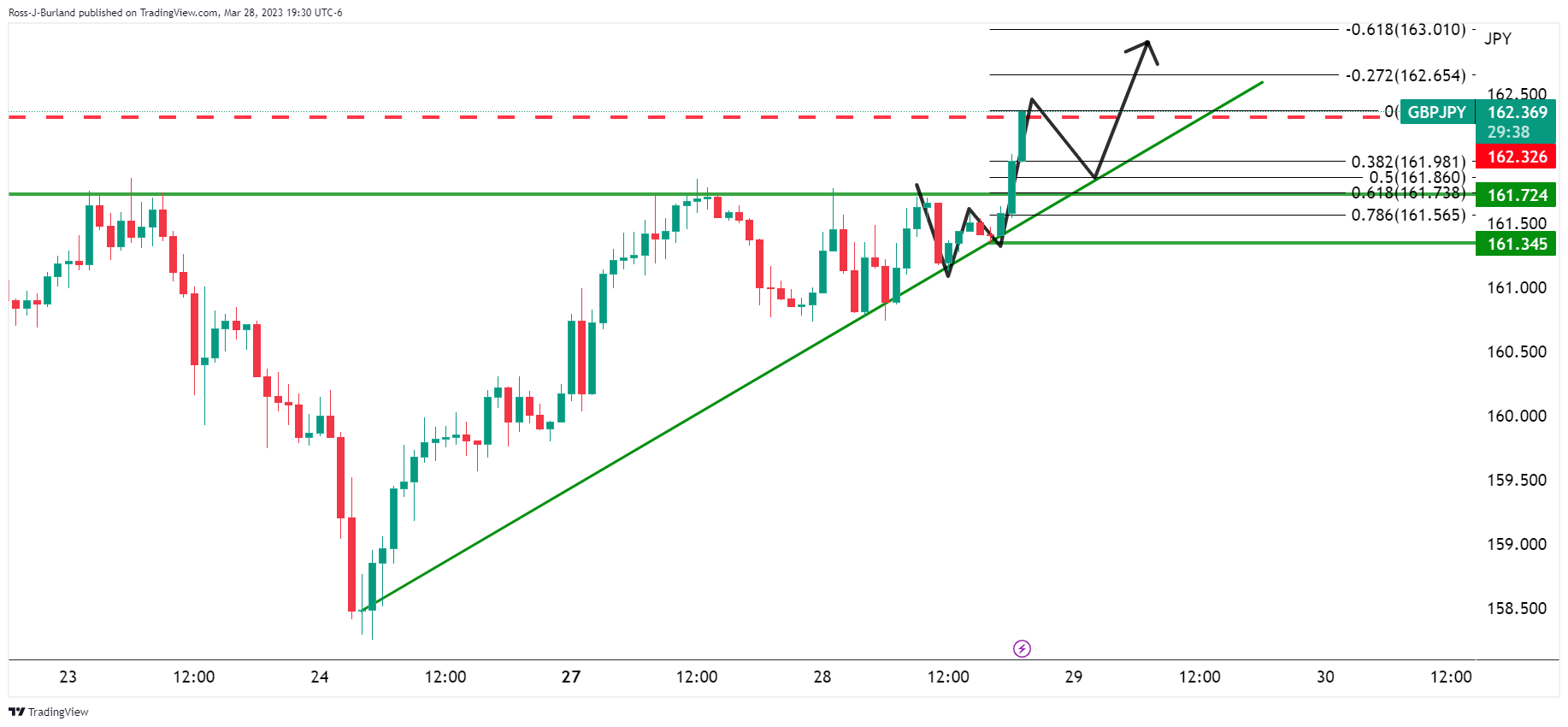
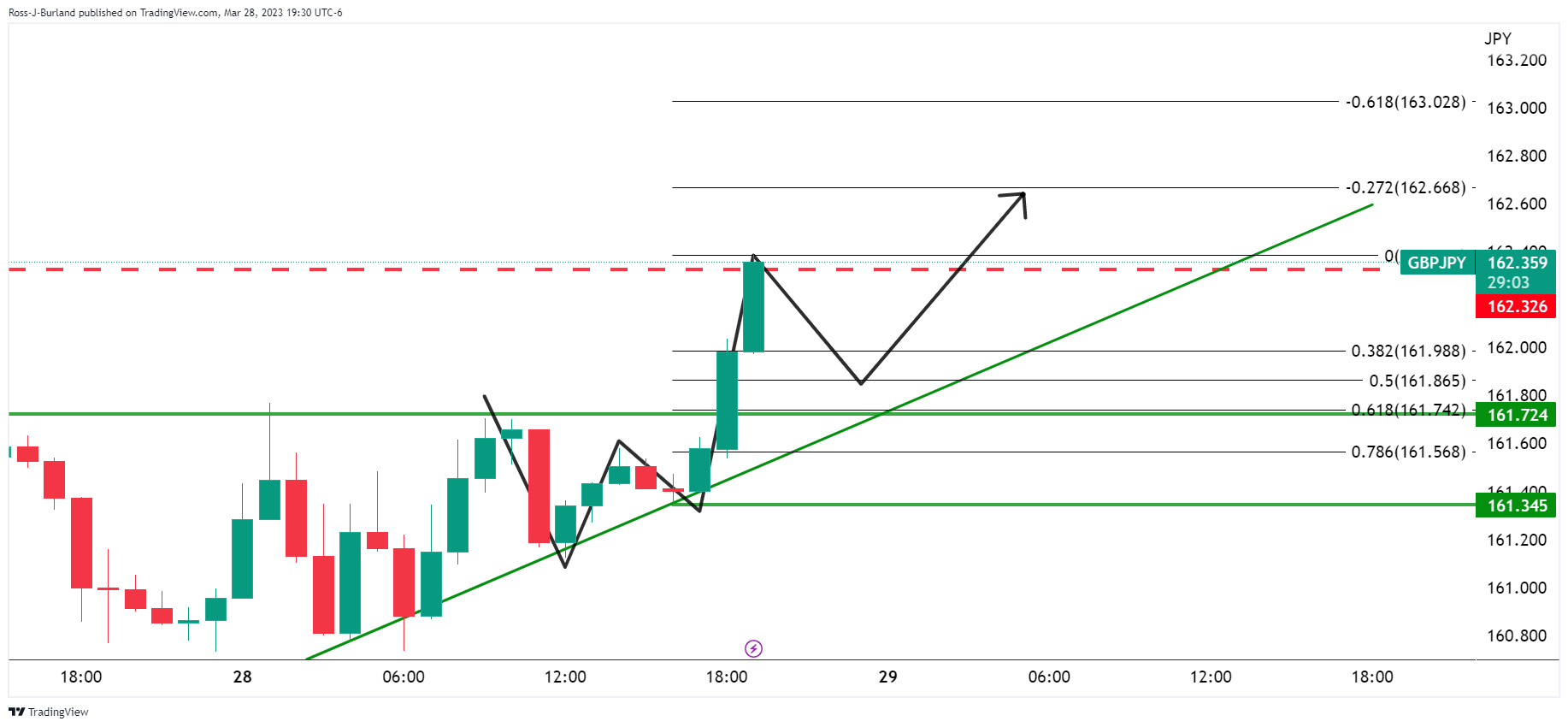
The W-formation is a reversion pattern and while the price is hugging the dynamic trendline support, a correction into the neckline would be expected to be met with buying force to propel the pair higher in due course woth 162.50 eyed.
GBP/JPY M5 chart
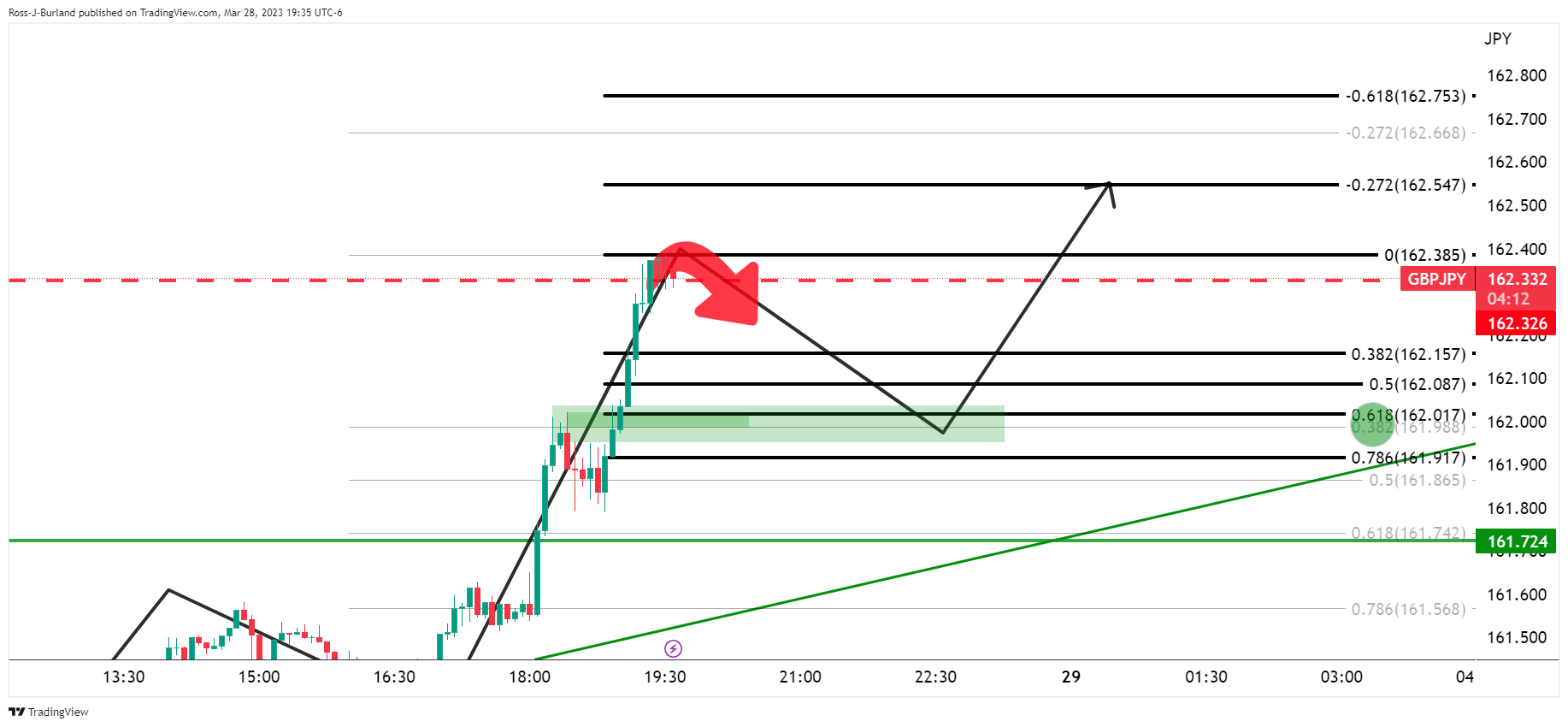
GBP/JPY bulls are lurking on the 5 min chart where prior resistance meets the combination of the 61.8% and 38.2% ratios near 162.00.
Deputy Director General of China’s National Development and Reform Commission of the People's Republic of China (NDRC) said in a statement on Wednesday, “we are confident about the growth condition for this year.”
“China's potential growth rate is the same as the potential growth rate of the entire world,” he added.
Market reaction
AUD/USD licks its wounds below 0.6700 on softer Australian inflation data and a mixed market mood. The pair is down 0.22% on the day, trading at 0.6993, as of writing.
- Global markets remain dicey as traders await this week’s key data/events.
- Mixed concerns about banking sector risk, US-China woes and Fed bets also limit trading activities.
- S&P 500 Futures snap two-day losing streak, yields rise for the third consecutive day.
- Risk catalysts are the key for clear directions, banking news, geopolitics are important for fresh impetus.
Risk appetite stays firmer despite early Wednesday’s inactive markets as traders seek confirmation of banking optimism amid an unimpressive calendar in Asia.
While portraying the mood, US Treasury bond yields print a three-day uptrend while the S&P 500 Futures print mild gains, the first in three. That said, the US 10-year and two-year Treasury bond yields recently refreshed intraday high around 3.58% and 4.12% in that order.
It should be noted that the receding fears of a banking crisis and hopes of less aggressive rate hikes from the top-tier central banks seem to gain the market’s attention. Also keeping the traders positive are chatters that the likely recession in some of the developed countries will be less severe than initially expected.
Furthermore, recently mixed US data and challenges for the Fed hawks also keep the market players optimistic, which in turn weigh on the US Dollar even as the yields recover of late.
Alternatively, headlines from the South China Morning Post (SCMP) suggest that the US has added 5 Chinese firms to its trade blacklist, which in turn should have probed the market’s optimism.
On the same line is the news that Australian Treasurer Jim Chalmers will convene a meeting of the country's top financial regulators to check how the latest volatility in global financial markets could affect the country, an official in the treasurer's office said on Tuesday per Reuters, prod the optimism. Furthermore, a discussion revealing the US and European regulators’ dislike for the latest banking fallouts and risks associated with it joined the much-debated $5.4 million Credit Default Swap (CDS) trade of Deutsche Bank to prod the risk-on mood.
Moving on, the second-tier US housing numbers may entertain market players but more important will be the headlines surrounding the global banking sector's health and easing fears of more rate hikes by the top-tier central banks.
Also read: Forex Today: Dollar keeps moving south as markets settle down
- GBP/USD retreats from the highest levels since early February, snaps two-day uptrend.
- Overbought RSI, bearish candlestick formation at multi-day top teases sellers.
- Weekly support line holds the key for bear’s entry.
- Previous support line from early March, two-week-long ascending trend line together challenges the bulls.
GBP/USD extends pullback from an eight-week high while printing mild losses near 1.2330 during early Wednesday. In doing so, the Cable pair prints the first daily loss in three.
Given the nearly overbought RSI (14), coupled with the bearish Doji candlestick at the multi-day top, the GBP/USD pair is likely to decline further.
However, an upward-sloping support line from the last Friday, around 1.2300 by the press time, restricts the short-term downside of the Cable pair.
Following that, the 50-SMA and the March 24 bottom, respectively near 1.2250 and 1.2190, could challenge the GBP/USD bears.
It’s worth noting that the 100-SMA level surrounding 1.2135 acts as the last defense of the GBP/USD buyers, a break of which won’t hesitate to prod the mid-month low of near the 1.2000 psychological magnet.
On the flip side, a convergence of the previous support line from March 08 and a fortnight-long ascending trend line, around 1.2390, challenges the GBP/USD buyers.
Even if the quote rises past 1.2390, multiple tops marked during late 2022 and early 2023, around 1.2445-50, appear a tough nut to crack for the Cable pair buyers.
To sum up, GBP/USD is likely bracing for a pullback but the reversal of the latest bullish trend is far from sight.
GBP/USD: Four-hour chart
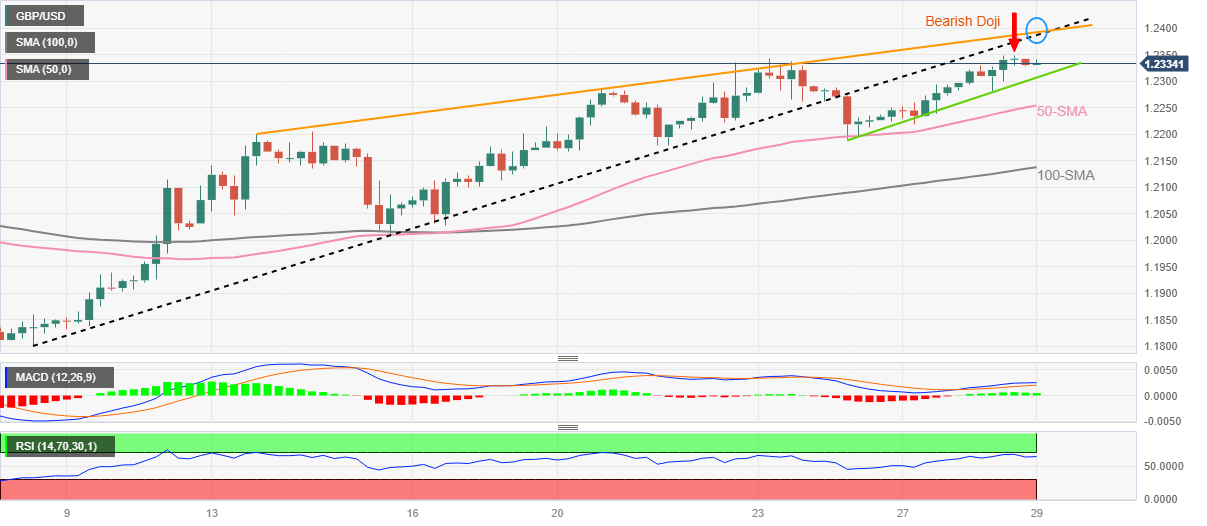
Trend: Pullback expected
In recent trade today, the People’s Bank of China (PBOC) set the yuan at 6.8771 vs. the previous closing of 6.8755.
About the fix
China maintains strict control of the yuan’s rate on the mainland.
The onshore yuan (CNY) differs from the offshore one (CNH) in trading restrictions, this last one is not as tightly controlled.
Each morning, the People’s Bank of China (PBOC) sets a so-called daily midpoint fix, based on the yuan’s previous day's closing level and quotations taken from the inter-bank dealer.
- USD/CAD is facing tough barriers near 1.3600 amid solid oil price and a decline in the USD index.
- The Canadian economy will receive billions of dollars of tax revenue from banks and insurance companies for dividends they get on investments.
- Oil price is expected to remain on tenterhooks ahead of US EIA inventory data.
The USD/CAD pair has sensed stiff barriers near 1.3600 in the Asian session. The downside bias for the Loonie asset seems solid as the US Dollar Index (DXY) looks prone to further losses below 102.40. The USD Index has found intermediate support near 102.40 but is likely to surrender amid improved risk sentiment.
The USD Index is facing immense pressure after easing United States banking jitters. Fears of a US banking crisis have started receding, however, the commentary from US House Speaker Kevin McCarthy in an interview at CNBC on Tuesday that there was no need for blanket insurance on all bank deposits "at this moment in time," as reported by Reuters, could stimulate them again.
S&P500 futures remained mostly restricted on Tuesday after the commentary from US House Speaker Kevin McCarthy. While the overall market sentiment looks cheerful as the Federal Reserve (Fed) is expected to sound steady for its interest rate decision in its next monetary policy meeting in May.
Meanwhile, the appeal for US government bonds remained weak as investors believe that the US will be out of the banking crisis sooner. This led to a further rise in 10-year US Treasury yields to 3.57%.
The Canadian Dollar remained volatile on Tuesday after Finance Minister Chrystia Freeland announced that dividends received by financial institutions from holding domestic shares will be treated as business income, as reported by Bloomberg. This will result in billions of dollars of tax revenue from banks and insurance companies for dividends they get from Canadian firms.
On the oil front, the oil price has accelerated to near $74.00 amid a weaker US Dollar and expectations of more sanctions on Russia. For further guidance, oil inventory data by the US Energy Information Administration (EIA) will be keenly watched. As per the consensus, the US EIA will report a small build-up in oil stockpiles by 0.187 million barrels for the week ending March 24.
It is worth noting that Canada is the leading exporter of oil to the United States and higher oil price would strengthen the Canadian Dollar further.
- AUD/NZD braces for the biggest daily loss in a week on downbeat Australia inflation.
- Australia’s Monthly CPI slumps to 6.8% YoY versus 7.1% expected and 7.4% prior.
- Cautious optimism puts a floor under the prices.
- Risk catalysts eyed for fresh impetus even as economic calendar becomes interesting.
AUD/NZD renews intraday low near 1.0690, marking a near 30-pip slump as Australia’s headline inflation data disappoints early Wednesday. As the downbeat Aussie Retail Sales also join the recently weaker Consumer Price Index (CPI) data, the increasing odds of the Reserve Bank of Australia’s (RBA) policy pivot keep bears hopeful.
That said, Australia’s Monthly Consumer Price Index dropped to 6.8% YoY in February versus 7.2% expected and 7.4% prior.
Also read: Aussie CPI misses expectationsa and AUD drops below 0.6700
Although the recent Aussie data favor bears, the market’s cautious optimism allows the AUD/NZD pair to check the bears before giving them control.
Behind the risk-on mood could be the receding fears of a banking crisis and hopes of less aggressive rate hikes from the top-tier central banks seem to gain the market’s attention. Also keeping the traders positive are chatters that the likely recession in some of the developed countries will be less severe than initially expected.
However, news that Australian Treasurer Jim Chalmers will convene a meeting of the country's top financial regulators to check how the latest volatility in global financial markets could affect the country, an official in the treasurer's office said on Tuesday per Reuters, prod the optimism. On the same line could be the much-debated $5.4 million Credit Default Swap (CDS) trade of Deutsche Bank. Furthermore, financial market regulators from the US and Europe also showed their dislike for the market’s curbs and raised fears of late.
While portraying the mood, US Treasury bond yields struggle to extend the two-day rebound but S&P 500 Futures print mild gains at the latest.
With the latest Aussie data raising fears of no rate hike from the Reserve Bank of Australia (RBA), AUD/NZD traders will be more interested in New Zealand’s housing market numbers and the ANZ sentiment figures ahead of China activity data for March. Should these numbers appear strong, the cross-currency pair may witness further downside.
Technical analysis
The AUD/NZD pair’s sustained bounces off a horizontal area comprising multiple levels marked since early December 2022, around 1.0660-75, join bullish MACD signals to tease buyers. However, the 21-DMA and the previous day’s Doji candlestick challenge the upside momentum. Furthermore, the steadily rising RSI (14) adds strength to the recovery.
- EUR/USD is moving up to key resistance.
- If EUR/USD holds above 1.0800, then the bias will be longer-term bullish.
EUR/USD is stalling on the bid near a five-day high around 1.0850 as euro zone government bond yields rose on Tuesday.
The US Dollar fell against a basket of currencies for a second straight day on Tuesday with the DXY, which measures the currency against six rivals, falling to a low of 102.41, not far now from the seven-week low of 101.91 hit last Thursday. This gives rise to a bullish outlook as illustrated on the following charts:
EUR/USD daily chart
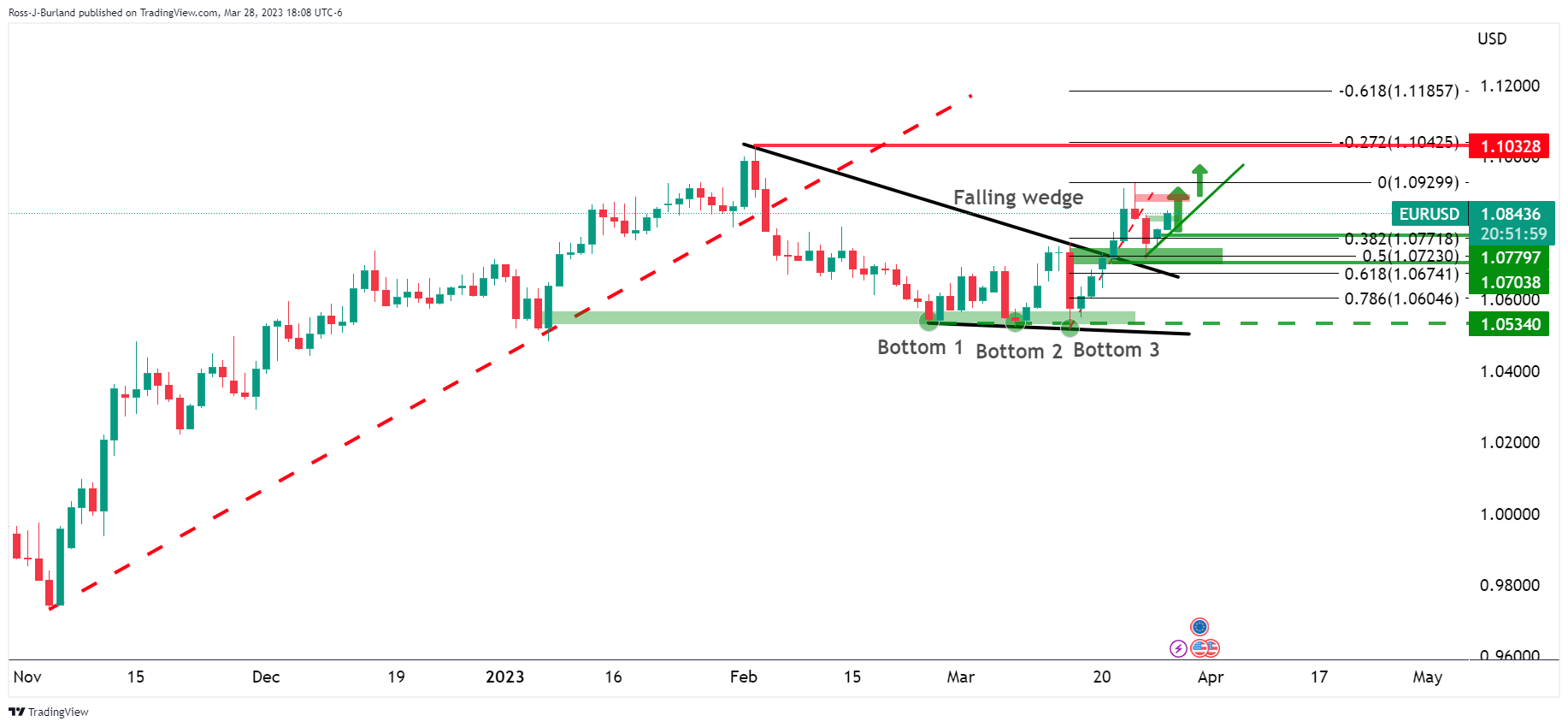
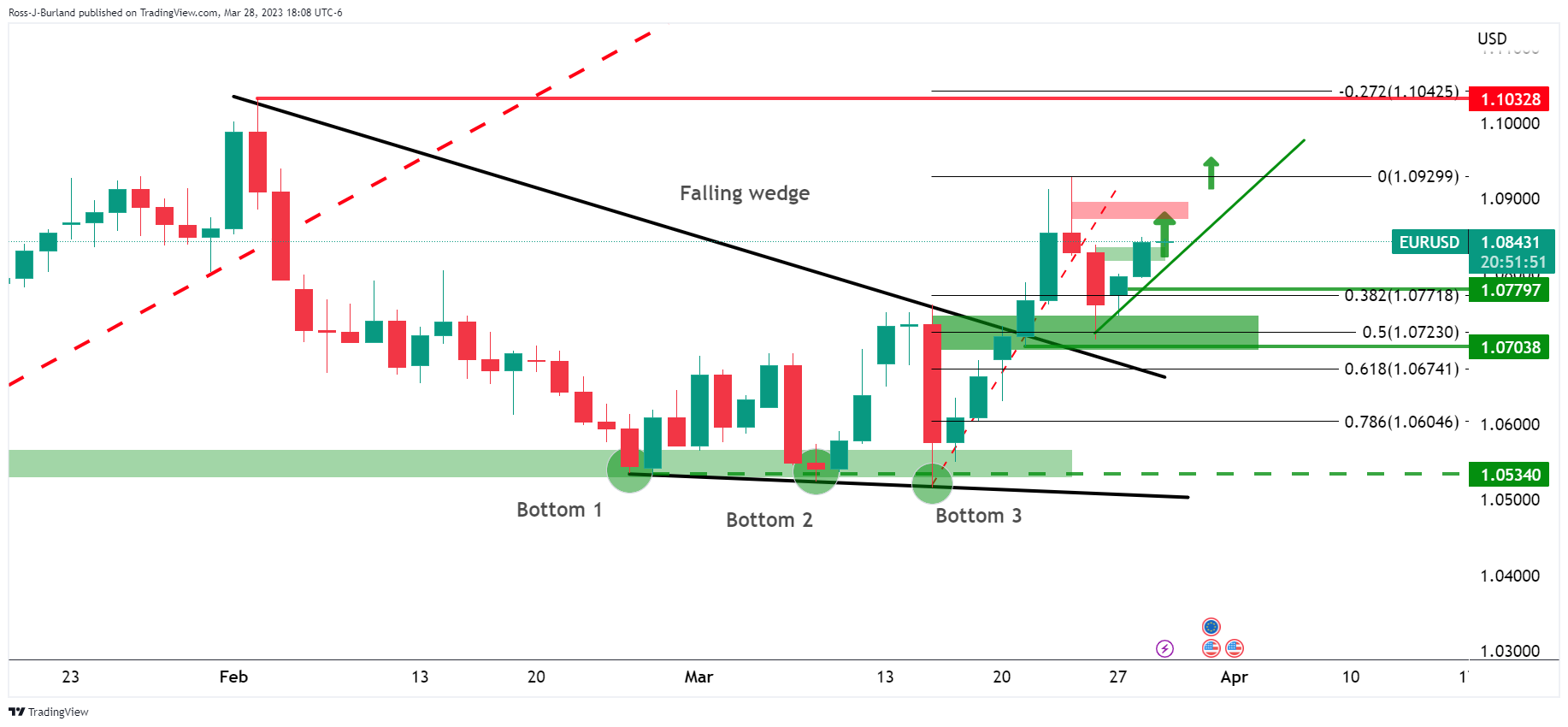
The daily chart shows the price on the front side of the bullish microtrend breaking out of the bearish wedge.
EUR/USD H1 chart
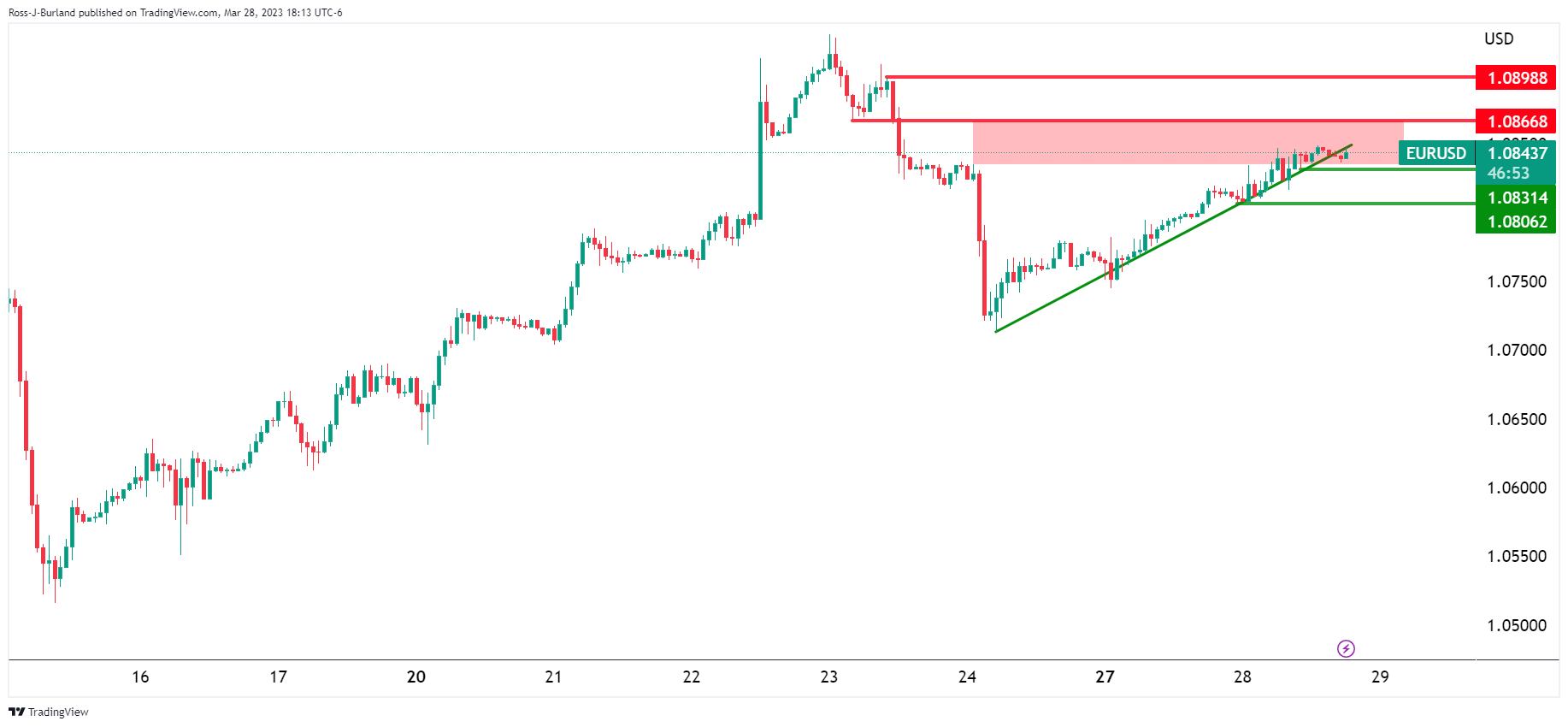
From a lower time frame, the price is moving up to the resistance and a break of dynamic support could be the catalyst for a significant correction. However, holding above 1.0800, the bias is longer-term bullish.
- AUD/JPY has dropped sharply to near 87.80 as Australian inflation has softened further to 6.8%.
- The collaborative effect of weaker Retail Sales and softening price index would support the RBA in keeping policy unchanged.
- BoJ Kuroda remained extremely dovish for further monetary policy as the sustainable inflation target has not been met yet.
The AUD/JPY pair has slipped firmly to near 87.80 as the Australian Bureau of Statistics has reported further softening in the monthly Consumer Price Index (CPI) (Feb). The economic data has landed at 6.9%, lower than the consensus of 7.1% and the former release of 7.4%.
On Tuesday, Australian Retail Sales expanded by 0.2%, lower than the consensus of 0.4% and the former release of 1.9%. A weaker-than-expected retail demand indicates that households are bearing the burden of higher inflation and are facing issues in offsetting the impact of inflated products with current paying capacity.
The collaborative effect of weaker Retail Sales and softening price index would support the Reserve Bank of Australia (RBA) in keeping monetary policy unchanged in its April meeting. Investors should be aware of the fact that RBA Governor Philip Lowe has already pushed its Official Cash Rate (OCR) to 3.60% in March.
Going forward, China’s Bureau of Statistics will report Manufacturing and Non-Manufacturing PMI data on Friday. A decent performance is expected by the market participants as the Chinese economy is promoting growth through monetary measures after dismantling pandemic controls. It is worth noting that Australia is the leading trading partner of China and accelerating economic activities in China will also support the Australian Dollar.
On the Japanese Yen front, the ex-bank of Japan Governor Haruhiko Kuroda remained extremely dovish for further monetary policy as the sustainable inflation target has not been met yet. He further added, “It is premature to debate an exit from easy monetary policy.” And, “More time is needed to stably and sustainably hit the price target.”
- AUD/USD takes offers to refresh intraday low, snaps two-day uptrend on weak Australia inflation data.
- Australia’s Monthly CPI dropped to 6.8% YoY in February versus 7.1% YoY expected and 7.4% prior.
- Market sentiment remains positive despite mixed concerns about the key central banks’ next moves.
AUD/USD drops 20 pips to 0.6690 as Aussie inflation disappoints during early Wednesday. In doing so, the risk barometer pair snaps two-day winning streak.
That said, Australia’s Monthly Consumer Price Index dropped to 6.8% YoY in February versus 7.1% expected and 7.4% prior.
Given the latest slump in the inflation data, the odds of witnessing another 0.25% rate hike from the Reserve Bank of Australia (RBA) become unwelcomed and drown the AUD/USD prices, especially after the downbeat Aussie Retail Sales.
Also read: Aussie CPI misses expectationsa and AUD drops below 0.6700
Contrary to the downbeat data, a firmer risk profile puts a floor under the AUD/USD pair even if it drops by the press time.
While tracing the key catalysts for the latest risk-on mood, receding fears of a banking crisis and hopes of less aggressive rate hikes from the top-tier central banks seem to gain the market’s attention. Also keeping the traders positive are chatters that the likely recession in some of the developed countries will be less severe than initially expected.
On the contrary, news that Australian Treasurer Jim Chalmers will convene a meeting of the country's top financial regulators to check how the latest volatility in global financial markets could affect the country, an official in the treasurer's office said on Tuesday per Reuters, prod the optimism. On the same line could be the much-debated $5.4 million Credit Default Swap (CDS) trade of Deutsche Bank. Furthermore, financial market regulators from the US and Europe also showed their dislike for the market’s curbs and raised fears of late.
Amid these plays, US Treasury bond yields struggle to extend the two-day rebound but S&P 500 Futures print mild gains at the latest.
Having witnessed the initial reaction to Australia’s inflation data, AUD/USD pair traders should pay attention to the second-tier housing numbers for fresh impetus. However, more important will be the headlines surrounding the global banking sector's health and easing fears of more rate hikes by the top-tier central banks.
Technical analysis
The AUD/USD pair’s first daily closing beyond the 21-day Exponential Moving Average (EMA), around the 0.6700 by the press time, directs buyers towards the convergence of the 50-day EMA and the previous weekly high surrounding 0.6755-60.
Australia´s monthly Consumer Price Index (YoY), released by the RBA and republished by the Australian Bureau of Statistics has been released as follows:
- Australian monthly CPI for February in at 6.8% (vs. expected 7.1%).
AUD/USD update
AUD/USD has spilled over to the downside and is piercing a near-term support structure below 0.6700:
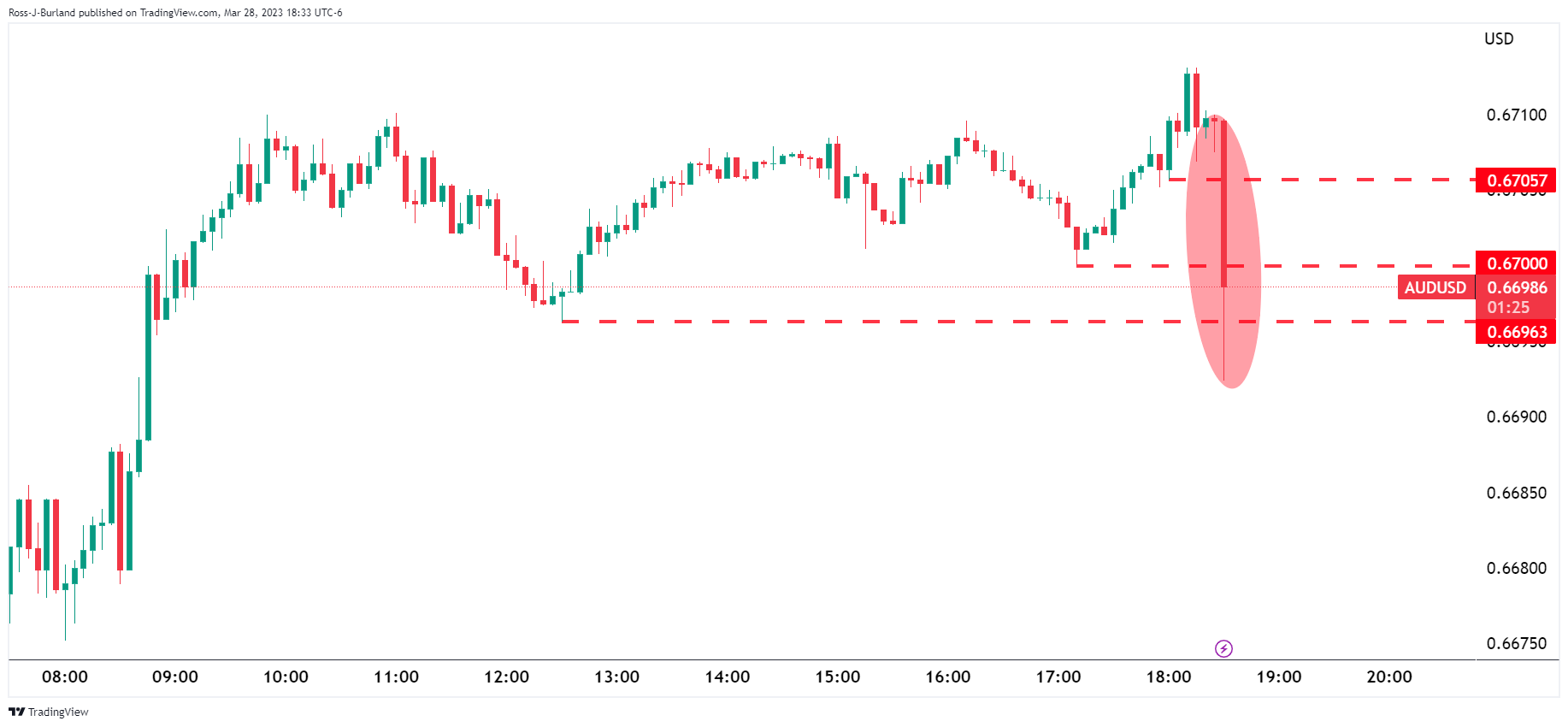
About the monthly Consumer Price Index (YoY)
The monthly Consumer Price Index (YoY), released by the RBA and republished by the Australian Bureau of Statistics, is a measure of price movements by the comparison between the retail prices of a representative shopping basket of goods and services. The purchasing power of AUD is dragged down by inflation. The CPI is a key indicator to measure inflation and changes in purchasing trends. A high reading is seen as positive (or bullish) for the AUD, while a low reading is seen as negative (or bearish). Note: This indicator started to be published in 2022 and it updates the price change for the last 12 months in Australia in a monthly basis, instead of the quarterly period of the main Australian CPI.
| Index | Change, points | Closed | Change, % |
|---|---|---|---|
| NIKKEI 225 | 41.38 | 27518.25 | 0.15 |
| Hang Seng | 216.96 | 19784.65 | 1.11 |
| KOSPI | 25.72 | 2434.94 | 1.07 |
| ASX 200 | 72.1 | 7034.1 | 1.04 |
| FTSE 100 | 12.45 | 7484.25 | 0.17 |
| DAX | 14.34 | 15142.02 | 0.09 |
| CAC 40 | 10.07 | 7088.34 | 0.14 |
| Dow Jones | -37.83 | 32394.25 | -0.12 |
| S&P 500 | -6.26 | 3971.27 | -0.16 |
| NASDAQ Composite | -52.76 | 11716.08 | -0.45 |
| Pare | Closed | Change, % |
|---|---|---|
| AUDUSD | 0.67069 | 0.86 |
| EURJPY | 141.912 | -0.12 |
| EURUSD | 1.08435 | 0.4 |
| GBPJPY | 161.468 | -0.09 |
| GBPUSD | 1.23368 | 0.42 |
| NZDUSD | 0.62499 | 0.87 |
| USDCAD | 1.3599 | -0.45 |
| USDCHF | 0.91961 | 0.45 |
| USDJPY | 130.873 | -0.52 |
- The US Dollar Index dropped to near 102.40 amid improved risk sentiment led by the easing US banking crisis.
- Federal Reserve won’t be required more strengthening of monetary tools to continue to weigh on US Inflation.
- Core Personal Consumption Expenditure (Q4) is seen steady at 4.3%.
The US Dollar Index (DXY) witnessed a sheer sell-off on Tuesday as United States banking jitters eased after the announcement of the acquisition of collapsed Silicon Valley Bank’s (SVB) deposits and loans by First Citizens BancShares. Apart from that, improvement in market sentiment in hopes that the Federal Reserve (Fed) won’t be required more strengthening of monetary tools to continue to weigh on US Inflation.
US banking shakedown by the collapse of three mid-size banks is forcing banks to remain more precautionary while disbursing advances to businesses and households. The debacle of US banks has resulted in the withdrawal of deposits by households amid the absence of wider blanket insurance on all deposits and dents confidence. This would lead to a decline in advances by small US banks or they may be required to tighten credit conditions further to avoid further casualties.
Therefore, Fed chair Jerome Powell won’t be required to go heavy on interest rates as fewer advances would weigh heavily on persistent inflation in the US economy.
Going forward, the release of the core Personal Consumption Expenditure (PCE) (Q4) data will remain in the spotlight. The economic data is expected to remain steady at 4.3%.
USD Index technical analysis
The USD Index has shifted its business below the 61.8% Fibonacci retracement (placed from February 02 low at 100.82 to March 08 high at 105.88) at 102.75 on a four-hour scale. The asset is expected to fully retrace its previous move ahead.
The declining 50-period Exponential Moving Average (EMA) at 103.07 is acting as a barrier for the USD Index.
The Relative Strength Index (RSI) (14) is oscillating in the bearish range of 20.00-60.00 in which the 60.00 level has been considered a barrier for bulls.
USD Index four-hour chart
-638156453286878133.png)
- Gold price remains in a bearish consolidation mode, mildly bid of late.
- Traders recheck previous optimism surrounding banking environment and prod XAU/USD buyers.
- Mixed concerns about inflation, as well as central bank moves, also restrict the Gold price momentum.
- XAU/USD bears need validation from higher inflation, fresh rejection of banking crisis.
Gold price (XAU/USD) stays defensive around $1,972, after snapping a two-day losing streak the previous day, as bulls seek more clues amid a cautious mood ahead of the top-tier data. Also challenging the XAU/USD price could be the mixed concerns about the market’s recent optimism that the banking turmoil is over. Furthermore, the month-end positioning and a light calendar are extra catalysts that restrict the Gold price moves of late. However, the economic line is about to be populated and hence can offer an active session to the commodity traders moving forward.
Gold price grinds between banking and inflation concerns
Gold price bounced off short-term key support as the US Dollar failed to cheer a rebound in the United States Treasury bond yields amid mixed sentiment and mostly upbeat US data. The reason could be linked to the market’s month-end positioning, as well as recent challenges to the market sentiment emanating from banking headlines.
That said, the United States Conference Board (CB) Consumer Confidence rose to 104.2 in March, versus 101.0 expected and an upwardly revised prior figure of 103.4. Further, US Housing Price Index rose 0.2% MoM in January versus -0.6% expected and -0.1% prior while the S&P/Case-Shiller Home Price Indices matched 2.5% YoY forecasts for the said month compared to 4.5% previous readings.
On the other hand, Wall Street closed with mild losses and the US Treasury bond yields managed to recover but the US Dollar Index (DXY) failed to improve as hawkish Fed bets eased. That said, CME’s FedWatch Tool suggests market players placing near 65% bets on another 0.25% rate hike for May 03 meeting.
It should be noted that the US Dollar couldn’t cheer mixed US data and the market’s indecision about the banking crisis. That said, markets initially cheered the First Citizens BancShares' agreement to buy all of the failed lender Silicon Valley Bank's deposits and loans before highlighting the European Union and the United States policymaker's efforts to defend their respective banking sector.
However, the much-debated $5.4 million Credit Default Swap (CDS) trade of Deutsche Bank weighs on the sentiment of late and allow the Gold buyers to take a breather. Furthermore, US House Speaker Kevin McCarthy said in an interview with CNBC on Tuesday that there was no need for blanket insurance on all bank deposits "at this moment in time," as reported by Reuters. On the same line, Jose Manuel Campa, Chairman of the European Banking Authority (EBA), warned in the German Handelsblatt newspaper, "The risks in the financial system remain very high." The policymaker also added that the rising interest rates continued to weigh on financial markets.
Geopolitical fears also weigh on XAU/USD
Apart from Gold the traders’ indecision, and geopolitical fears surrounding China, Russia and North Korea also weigh on the XAU/USD price. That said, the Sino-American tussles appear grim of late while US President Joe Biden’s concerns about Russia’s shifting of nuclear weapons to Belarus and North Korean Leader Kim Jong Un’s lauding of readiness to use nuclear powers raise the market’s fears of deadly war in case if theses catalysts move forward. The same could join the month-end positioning and a light calendar to challenge the Gold buyers.
Market’s anxiety restricts Gold price moves
Although multiple hurdles keep challenging the Gold buyers, apart from the US Dollar weakness, the lack of data and cautious mood ahead of this week’s top-tier inflation data from Germany, Europe and the US prod the XAU/USD traders. Adding strength to the market’s indecision could be the recent jump in the US inflation expectations, as per the 10-year and 5-year breakeven inflation rates from the St. Louis Federal Reserve (FRED). That said the 10-year and 5-year breakeven inflation rates from the St. Louis Federal Reserve (FRED) recently flashed a three-day and two-day winning streak respectively while posting the 2.31% and 2.34% level in that order. With this, the inflation precursors rose to the highest levels in a fortnight.
To sum up, the Gold price remains indecisive despite the latest rebound and hence traders should wait for clear directions before taking any major positions.
Gold price technical analysis
Gold price reverses its pullback from a multi-month-old ascending resistance line while bouncing off the 10-DMA. However, the receding strength of the bullish signals on the Moving Average Convergence and Divergence (MACD) indicator tests the Gold buyers. Furthermore, a downside break of the Relative Strength Index (RSI) line, placed at 14, adds strength to the seller’s hopes of witnessing further declines in the XAU/USD.
That said, the 10-DMA level surrounding $1,960 joins the early February tops surrounding $1,955 to restrict short-term XAU/USD downside.
It’s worth noting, however, that a clear break of the $1,955 support could quickly drag the Gold price toward the $1,900 threshold.
Alternatively, the stated resistance line from early August 2022, around a $2,000 psychological magnet, precedes the Year-To-Date (YTD) high of near $2,010 to act as the last defense of the Gold bears, a break of which could propel XAU/USD toward the previous yearly top of $2,070.
Gold price: Daily chart
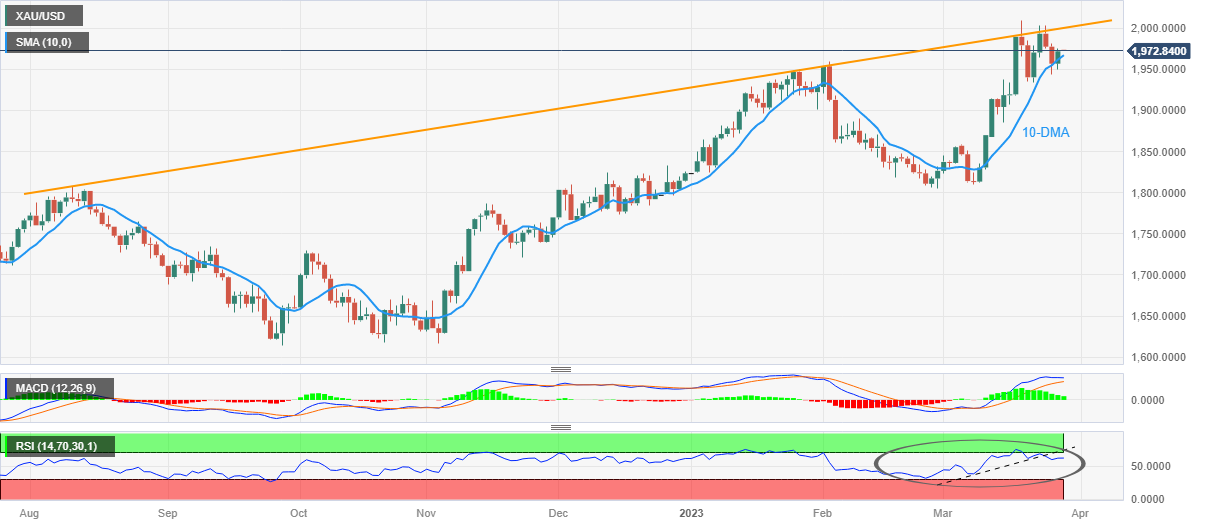
Trend: Further weakness expected
© 2000-2025. All rights reserved.
This site is managed by Teletrade D.J. LLC 2351 LLC 2022 (Euro House, Richmond Hill Road, Kingstown, VC0100, St. Vincent and the Grenadines).
The information on this website is for informational purposes only and does not constitute any investment advice.
The company does not serve or provide services to customers who are residents of the US, Canada, Iran, The Democratic People's Republic of Korea, Yemen and FATF blacklisted countries.
Making transactions on financial markets with marginal financial instruments opens up wide possibilities and allows investors who are willing to take risks to earn high profits, carrying a potentially high risk of losses at the same time. Therefore you should responsibly approach the issue of choosing the appropriate investment strategy, taking the available resources into account, before starting trading.
Use of the information: full or partial use of materials from this website must always be referenced to TeleTrade as the source of information. Use of the materials on the Internet must be accompanied by a hyperlink to teletrade.org. Automatic import of materials and information from this website is prohibited.
Please contact our PR department if you have any questions or need assistance at pr@teletrade.global.
















